
- Cookie Policy
- Privacy Policy & Terms of Use
- Travelling to Ypres
- Staying in Ypres
- Passchendaele
- Sanctuary Wood
- Bayernwald Trenches and Kemmel
- Lijssenthoek Cemetery
- Yorkshire Trench
- Polygon Wood
- Five Must See Somme Sites
- Travelling to the Somme
- Staying in the Somme
- Beaumont Hamel
- Newfoundland Memorial Park
- Ulster Tower
- Lochnagar Crater & Area
- Iron Harvest
- Delville Wood
- Trones Wood, Guillemont & Area
- Villers-Bretonneux
- Cuinchy, Cambrin and Vermelles
- Vimy Ridge Area

World War One Battlefields
Visiting the first world war battlefields of the western front.
- - Cookie Policy
- - Privacy Policy & Terms of Use
- - Travelling to Ypres
- - Staying in Ypres
- - Passchendaele
- - Tyne Cot
- - Essex Farm
- - Ypres
- - Sanctuary Wood
- - Hill 60
- - Bayernwald Trenches and Kemmel
- - Hooge
- - Lijssenthoek Cemetery
- - Messines
- - Plugstreet
- - Yorkshire Trench
- - Langemark
- - Polygon Wood
- - Five Must See Somme Sites
- - Travelling to the Somme
- - Staying in the Somme
- - Thiepval
- - Beaumont Hamel
- - Newfoundland Memorial Park
- - Ulster Tower
- - Albert
- - High Wood
- - Lochnagar Crater & Area
- - Iron Harvest
- - Delville Wood
- - Trones Wood, Guillemont & Area
- - Serre
- - Mametz
- - Villers-Bretonneux
- - Arras
- - Cuinchy, Cambrin and Vermelles
- - Fromelles
- - Verdun
- - Vimy Ridge
- - Vimy Ridge Area

Flanders /Ypres
Visiting Ypres and the Salient - Belgian Flanders

Visiting the Somme battlefields in Northern France

Other battlefields
Covering other sites of interest on the Western Front
Welcome to the World War One Battlefields website!
This website went live in 2004, and is regularly updated to provide an online guide to areas of the Western Front as they are today, with historical information and photographs alongside modern photos of each area. It provides practical information – see pages on Visiting the Somme and Visiting Ypres . There is information on how to best reach the battlefields of the Somme and Flanders and also where to stay ( Somme and Flanders ). For those with limited time, there is a page listing Five must-see Somme sites – useful if you have only one day to spend in the area. Helping you to make the most of your battlefield visit is the main purpose of this website.
There are many more pages on what to see in the two main areas of interest on the Western Front, Ypres/Flanders and the Somme . For Flanders, these include Tyne Cot , the Menin Gate in Ypres and Passchendaele , whilst in the Somme, there are pages on the Thiepval Memorial , the Newfoundland Memorial Park and Beaumont Hamel , among others.
There are also pages on other key sites on the Western Front, such as Vimy Ridge , Arras and Verdun .
Latest Site Updates
The latest updates to the website are from a trip e to the Somme in summer, 2021. There were few visitors, and I took some aerial photographs and video footage of some of the sites. The most recent updates are to the Ulster Tower page; other recent updates have been made to the Beaumont Hamel , Thiepval , High Wood and Trones Wood pages.
There are some excellent guidebooks and other resources for visiting the battlefields. These are also listed on the relevant pages.

Sections covering the main battlefields of interest on the Western Front can be accessed via the links below:
The Somme battlefields
Ypres/flanders battlefields.
Explore These World War I Trenches and Tunnels in France and Belgium
These four sites give visitors a glimpse into the trench warfare tactics soldiers experienced during the Great War
Jennifer Nalewicki
Travel Correspondent
:focal(585x471:586x472)/https://tf-cmsv2-smithsonianmag-media.s3.amazonaws.com/filer/67/3d/673d376c-fb1e-4c24-8266-c59ef5fc95dc/istock-533838141.jpg)
For troops serving on the front lines during World War I, trench warfare was common practice. The use of machine guns and rapid-fire field artillery pieces forced soldiers on both sides, the Allies and the Central Powers, to bore intricate trench systems into the ground. These trenches served as protection against enemy fire and allowed soldiers to fire back without being fully exposed. Tunnels, on the other hand, were used to surreptitiously place explosives beneath unsuspecting enemy soldiers and move supplies between different parts of a battleground. In one known instance, a tunnel was used as an underground hospital.
While overgrowth and erosion have largely overtaken many battlegrounds in the 100 years since the Treaty of Versailles was signed, officially ending the war between Germany and the Allies, archaeologists, historians and even civilians have uncovered the remnants of these protective hideaways throughout Europe. These sites are important glimpses, even today, into battles that took place during the Great War.
Here are four tunnels and trenches visitors can see firsthand:
Canadian Memorial, Vimy, France
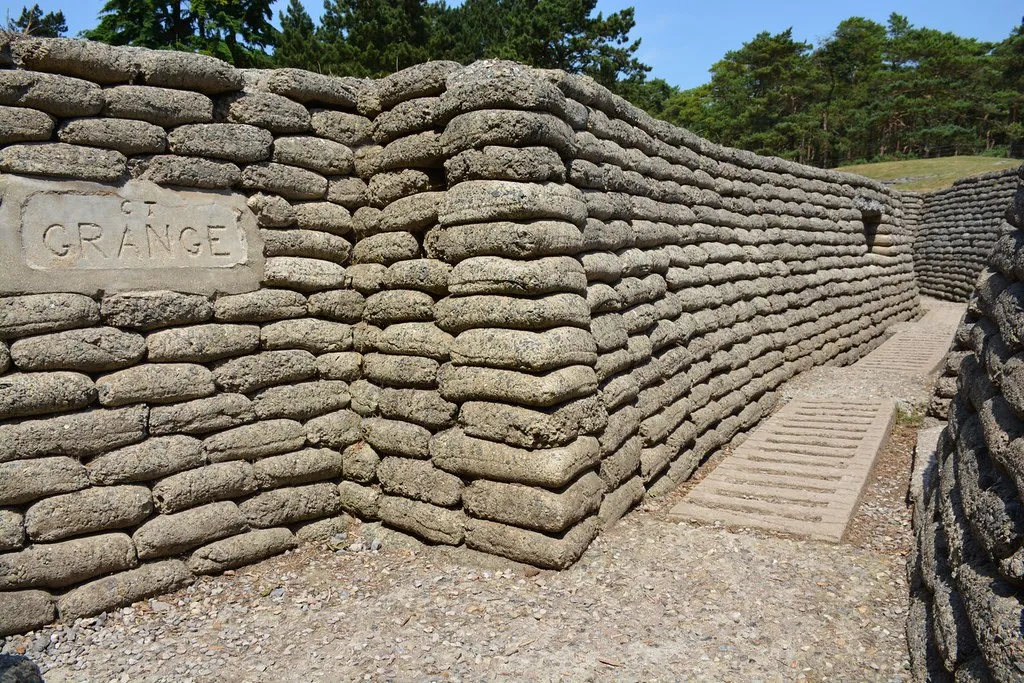
One of the first things visitors notice at this memorial site in northern France, about 125 miles north of Paris, is the massive limestone monument that commemorates the thousands of Canadian soldiers who went missing or were presumed dead during the First World War. The memorial sits on the site of the Battle of Vimy Ridge overlooking the restored remnants of an elaborate system of brick-lined trenches and tunnels burrowed in the surrounding green hills.
In preparation for the battle, the Canadian Armed Forces worked with several British tunneling companies to create an intricate underground network of tunnels, some nearly a kilometer in length to protect soldiers and to facilitate and disguise the movement of troops and supplies. This was particularly important as the Germans held the higher ground in the region and could easily spot activity on the surface. Some tunnels were outfitted with running water and lighting systems. Others were used to covertly position explosives beneath German fortifications.
On the morning of Easter Sunday, April 9, 1917, during a sleet storm, the Canadian Armed Forces attacked the German Sixth Army. Waves of Canadian troops poured over the trench walls following close behind an artillery attack designed to give the Canadians time to reach the German positions before the Sixth Army could recover from the barrage. Despite heavy losses, the Canadians succeeded in driving the Germans back.
Today, tour groups can explore both the tunnels and trenches with guides, or virtually via Google Canada .
Wellington Quarry, Arras, France
/https://tf-cmsv2-smithsonianmag-media.s3.amazonaws.com/filer/10/9b/109b5136-8e11-403c-94ba-75c9884c0e23/5088907181_a3fbb80f30_b.jpg)
The tunnels associated with the Wellington Quarry , or la Carrière Wellington, located 110 miles north of Paris, were so elaborate that they contained a working hospital for the British Army and Allied Powers fully equipped with 700 beds and operating theaters. Not only that, but workers from the New Zealand Tunneling Company—tapped to complete the massive project—built the labyrinth of passageways so that they interlinked with preexisting tunnels dating back to the Middle Ages. (The name Wellington is a nod to New Zealand's capital city.) Today, the Carrière Wellington Museum resides underground, and tours include an elevator ride 70 feet below the surface, a description of the 1917 Battle of Arras that happened here between the British Empire and German Empire, and a glimpse at soldiers’ subterranean lives by visiting their sleeping quarters and the hospital for wounded soldiers.
Sanctuary Wood, Ypres, Belgium
/https://tf-cmsv2-smithsonianmag-media.s3.amazonaws.com/filer/40/4f/404f36f7-f524-4cf4-8451-d420048f9554/istock-174939198.jpg)
Once the dust settled after the final battle of World War I and citizens received the all clear, one farmer by the name of Schier returned to reclaim his property and discovered a maze of trenches bored into his land in western Belgium. Rather than replant his crops, he decided to keep the land as it was to preserve the memory of the Great War and those who lost their lives in battle. In the century since, the property remains in the hands of the same family, the Schiers, who maintain it and have kept it largely the way it appeared when their late relative discovered it. Today, Sanctuary Wood serves as a museum filled with artifacts discovered onsite, including weapons, ammunition, gravesites, soldiers’ personal belongings and photos. But arguably the main feature is the series of zigzagging, corrugated metal-lined trenches that stand as a reminder of where the British front line once resided and where hundreds of men lost their lives.
Beaumont-Hamel Newfoundland Memorial, Beaumont-Hamel, France
/https://tf-cmsv2-smithsonianmag-media.s3.amazonaws.com/filer/d7/3c/d73c1961-0f97-4ba8-bb9b-e144c9f5370d/beaumont-hamel_tranchees_3.jpg)
Among the trenches that make up this network constructed in a pocket of northern France, located about 100 miles southwest of Belgium, are some of the most shallow built during the war. In the years since, they have been taken back by nature. The undulating hills and valleys appear, on first glance, to be a mere quirk of the landscape, but in reality they served as protection for the Allied Powers. Today, the 74-acre site is home to a memorial —a bronze caribou atop a granite pyramid—commemorating soldiers of the Canadian Armed Forces, in particular those from Newfoundland who bravely served their country.
Get the latest Travel & Culture stories in your inbox.
Jennifer Nalewicki | | READ MORE
Jennifer Nalewicki is a Brooklyn-based journalist. Her articles have been published in The New York Times , Scientific American , Popular Mechanics , United Hemispheres and more. You can find more of her work at her website .
TTC family of brands
My Trafalgar
Destinations
Get Inspired
866 513 1995
WWI and WWII Battlefields
316 reviews
Last Minute Deal
Save up to $607
Available Dates
Your itinerary
Dates & prices
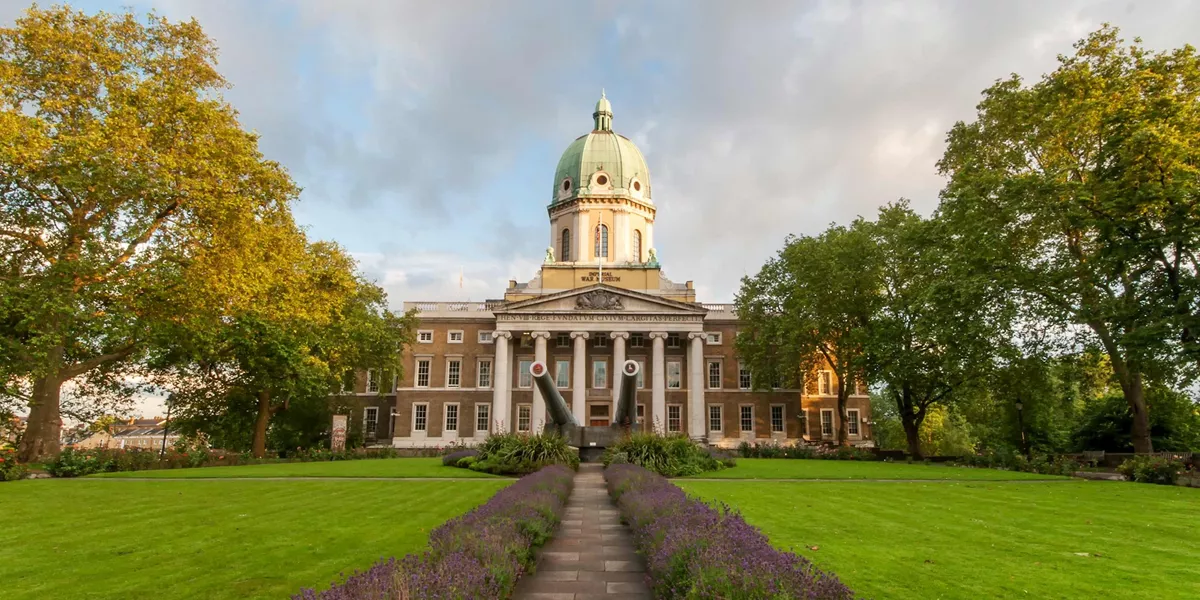
11 Day Battlefield Tour of UK, Belgium and France
11 days, 3 countries and 11 cities
Accommodation
10 Breakfasts, 4 Dinners
View day-by-day trip itinerary
Travel to the front lines of Europe, where brave soldiers once fought for freedom. On this epic battlefield tour through the countryside of Britain, Belgium and France, you’ll explore the tragedy and triumph of two World Wars.
Looking to book in a group of 9 or more?
Deals, savings and exclusive private touring options available plus if you need a different date or itinerary change we can create a custom trip. Contact us for more details
Trip code:
Low deposit from $200
Deposit protection
Free booking changes
Trip map & itinerary
Day by day itinerary
11 days itinerary trip from London to Paris visiting 3 countries and 11 cities
Download itinerary
Print itinerary
Expand all days
About this trip
Sightseeing highlights.
Explore London and Paris with a Local Specialist
Discover Normandy, Amiens, the Somme Region, Ypres, Brussels and Rouen
Visit the Imperial War Museum in London, the D-Day Landing Beaches, Saint-Sulpice church in Paris, Amiens Cathedral, military cemeteries throughout northern France and Belgium, the Australian National Memorial, the Caen Memorial, WWI & WWII Battlefields, the Dunkirk War Museum and evacuation beaches, and the Memorial Museum Passchendaele
View Buckingham Palace in London, the Eiffel Tower and the Arc de Triomphe in Paris and the Menin Gate
Travel highlights
Specific transfer information can be found here:
Airport Transfers
An expert Travel Director and professional Driver
Cherry-picked hotels, all tried and trusted
All porterage and restaurant gratuities
All hotel tips, charges and local taxes
Breakfast daily and up to half of your evening meals
Must-see sightseeing and surprise extras
Audio headsets for flexible sightseeing
Luxury air-conditioned coach with Wi-Fi in most countries or alternative transportation (such as rail journeys)
Optional Experiences and free time
Eurostar high-speed train from London to Brussels
On occasion, hotels of similar standard and location may be utilized.

MAKE TRAVEL MATTER® Experiences
Every one of our tours includes at least one conscious travel experience that supports one or more of the United Nations Sustainable Development Goals (SDGS). Look out for yours within the day-by-day trip itinerary.
Find out more

Net-zero by 2050
Travel knowing our 4-point climate action plan will ensure net-zero greenhouse gas emissions by 2050.

Support Local
Your tour directly supports local communities by visiting family-run businesses, UNESCO sites and places of cultural significance.

Sustainable Practices
Every part of our business, from trip design to how we run our offices, aligns to our 5-year sustainability strategy which ensures a positive impact on people, the planet and wildlife.

Philanthropic Efforts
Our not-for-profit, the TreadRight Foundation, invests in nature-based solutions to address climate change.
You’ll make a positive impact to people, planet and wildlife on this tour
LIVE, UNEDITED & INDEPENDENT TRAVELER REVIEWS
WWI and WWII Battlefields trip reviews
#ttbattlefields.
Real moments from real travelers, creating the greatest travel stories they’ll ever tell
Or search for something else

Help & Info
WE MAKE TRAVEL MATTER®
Unedited Reviews
Our Destination Management Companies
Frequently Asked Questions
Travel Updates
Media & Press Room
Do Not Sell or Share My Personal Information
Travel Planning
Get Your Free Brochure
Travel Insurance
Booking Conditions
Trip Deposit Level
Recommendations
Trafalgar Tours Limited is a proud member of The Travel Corporation family of companies.
#SimplyTrafalgar
Travel House, Rue du Manoir St Peter Port, Guernsey, GY1 2JH
Selected Region
United States
United Kingdom
New Zealand
South Africa
Copyright 2024 Trafalgar. All rights reserved.
Terms and Conditions
Privacy Policy
Cookie Policy

Battlefield Tours
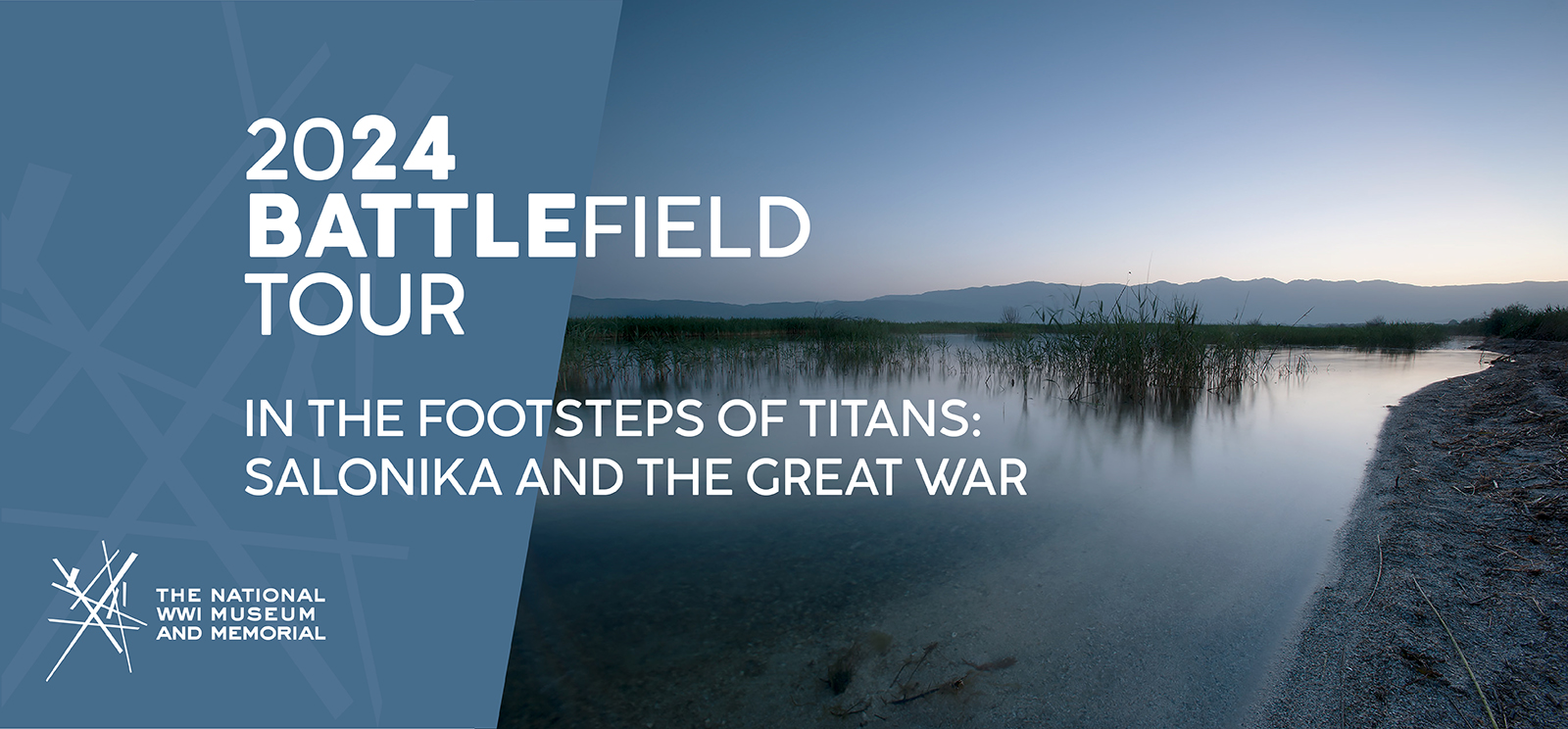
2024 Battlefield Tour
In the footsteps of titans: salonika and the great war, friday, sept. 13 – wednesday, sept. 18, 2024.
Venture into the crossroads of mythology and modernity with the National WWI Museum and Memorial as we explore the cultural and historical significance of the Salonika Front. From the dense forests and mountain landscapes of beautiful Greece, we will trace the forgotten trench lines of some of the war’s most remote battlefields and discover the global stories of this lesser-known theater rich in geopolitical importance as the “cradle of democracy.” The tour begins and ends in Thessaloniki (SKG) with five nights of lodging in the scenic Grecian countryside.
Please note:
This tour traverses rugged terrain and includes locations with steep and unpaved grounds. Unlike previous battlefield tours, much of this battlefield is inaccessible by vehicle. Participants MUST be able to walk a minimum of 6 miles without assistance and be able to carry their own equipment needed for hiking.
Planned Itinerary
Tour pricing, frequently asked questions.
Previous Tours
(May be subject to change)
Day 1: sept. 13.
Starting in Thessaloniki, the group’s first introduction to the campaign will be the Salonika (Lembet Road) Military Cemetery, containing personnel from all nations. The group will travel north to study Birdcage Line, constructed by the British Army in 1916, and end the day at the Doiran Memorial.
Overnight Doiran – Dinner included
Day 2: Sept. 14
Northbound from Doiran, the group will explore the furthest extent of the French Army’s advance in 1915, passing through Gradsko and Krivolak. Stopping at the Demir Kapija tunnel on the way back to Doiran, the group will study the Dec. 1915 retreat before finishing the day at Lake Doiran.
Overnight Doiran – Breakfast, Lunch and Dinner included
Day 3: Sept. 15
Most of the day’s travels will be on flat ground and near the group’s hotel in Doiran, examining key points of action in the Battles of Doiran like La Tortue, Hill 340, the Hilt and the Petit Couronné.
Day 4: Sept. 16
A full day’s hike to Devil’s Eye and its views over Pip Ridge, the scene of the final decisive battle of Salonika in Sept. 1918. En route to the site, the group will pass through the Bulgarian reserve positions, artillery and command bunkers, as well as the T Line bunkers and an isolated British Divisional Memorial.
Day 5: Sept. 17
Trekking through the Struma Valley, the group will explore the various actions at Tumbitza Farm, specifically the 27th Division attacks, as well as the British battery positions at Triada (Dragos) and the Bulgarian positions at Palio Castro. For the final evening, the group will return to Thessaloniki.
Overnight Thessaloniki – Breakfast, Lunch and Dinner included
Day 6: Sept. 18
Transfer to Thessaloniki Airport for departures.
Questions? Frequently Asked Questions
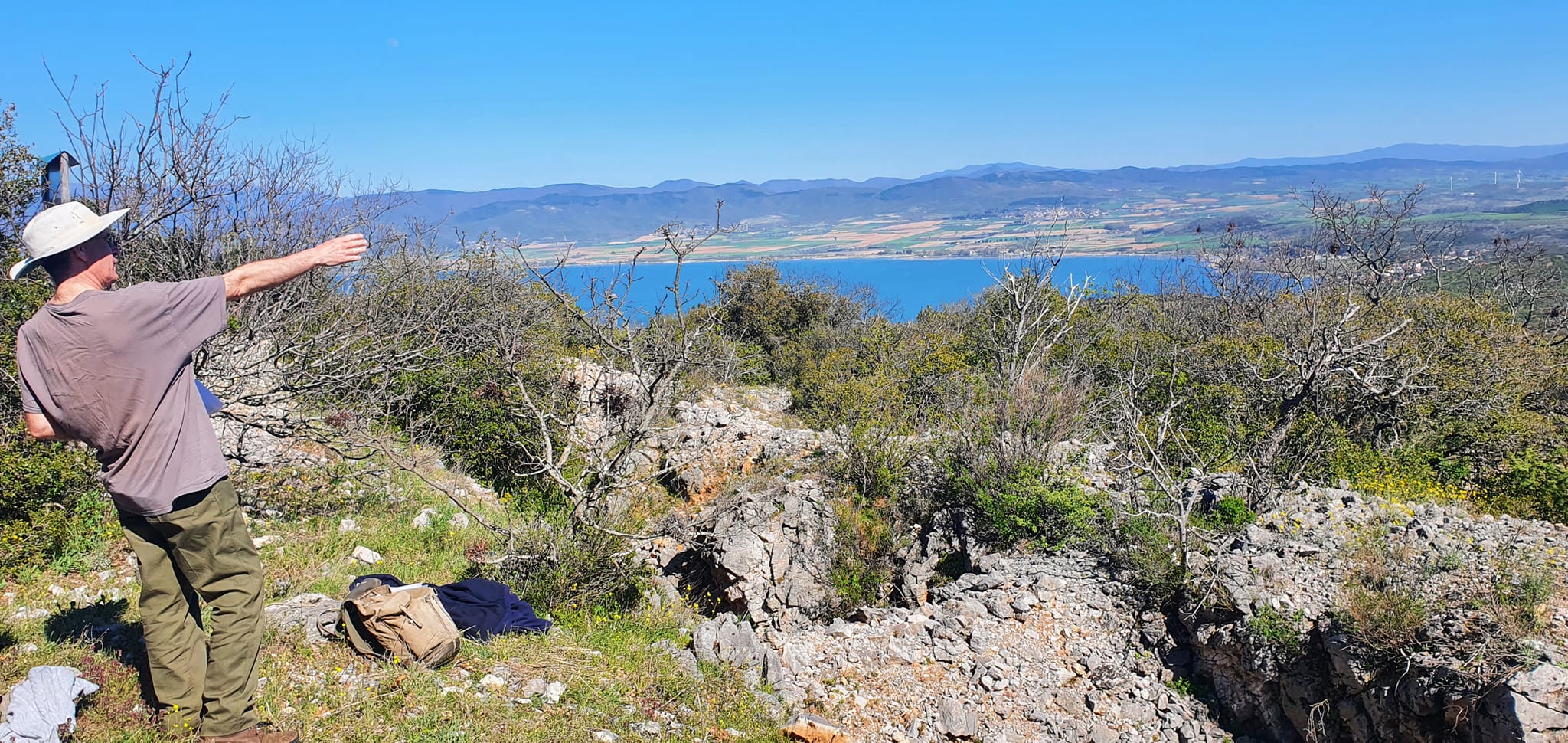
$500 deposit (per person) due by April 30, 2024
Account in full due by june 30, 2024, costs include:.
- Pick-up and drop-off at Thessaloniki Airport (SKG)
- Bus, driver and guides throughout tour
- 5 nights accommodation (includes all meals)
- Small group size
It does not include:
- Flights to and from Greece
- Incidentals
Travel Insurance
Traveler is responsible for securing their own optional travel insurance.
We encourage scheduling your arrival the day before the tour begins to avoid any risk of a delayed flight.
Ready to register? Registration
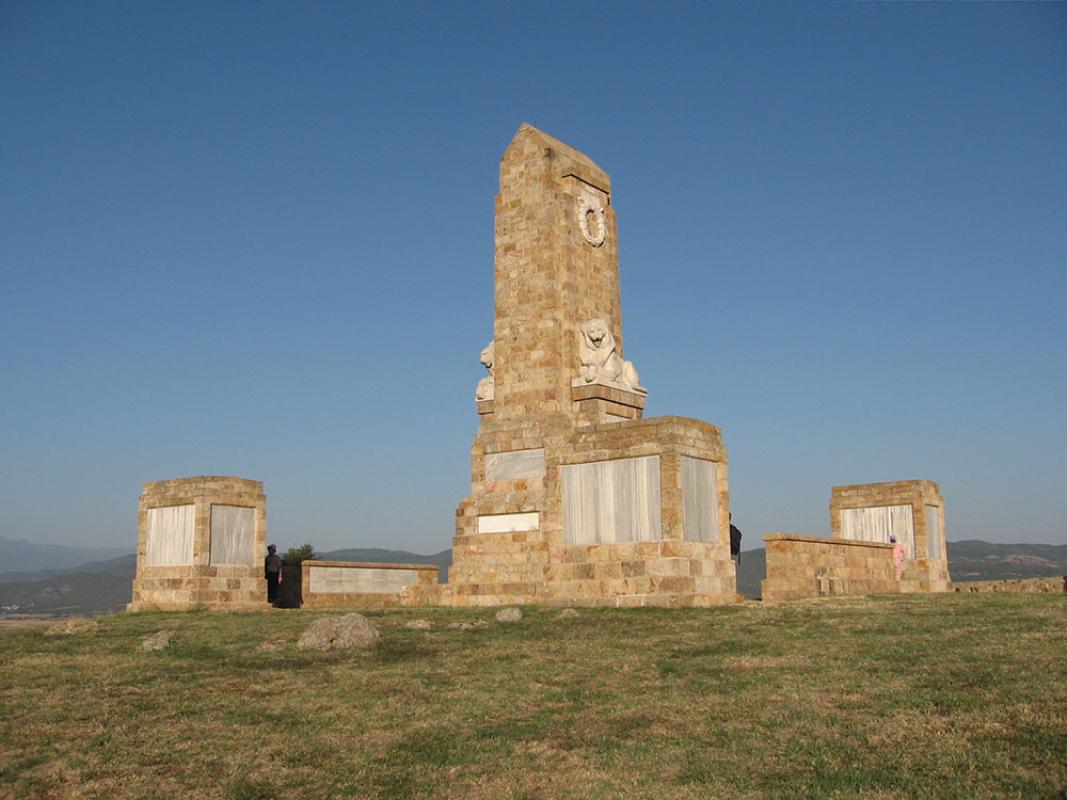
The British Memorial to the Missing near Lake Doiran.
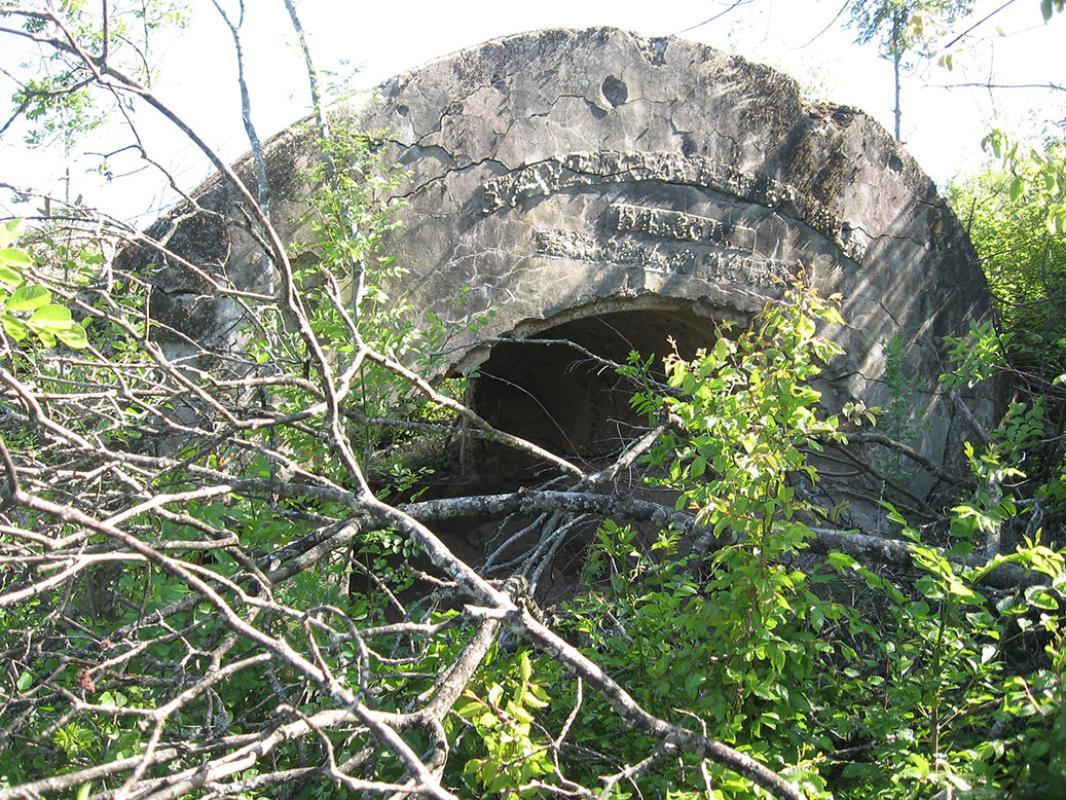
Bulgarian artillery position between Grand Couronné and Pip Ridge.
Please note: Modifications may occur due to current global travel restrictions.
When and where will we meet the group?
All participants should meet at the designated meeting place and time, provided with your tour information. It is recommended to arrive in the destination city the day before the tour, giving you ample time to meet at the gathering place. Once you receive the green light to purchase your airfare, please forward your arrival time and flight number to the Museum and Memorial's Learning Coordinator at [email protected] . This will assist guides in roll call before starting the tour.
What sites will we be visiting?
Please see the itinerary sent by the guides. The itinerary is loose, allowing flexibility in visiting additional sites.
What hotels will we be staying in? What amenities are included?
Please see the itinerary sent by the guides. Breakfast, WiFi and laundry services are generally available.
How many meals are included with my registration?
Breakfasts and at least one group dinner are covered under your registration. Lunches and other dinners are not included, unless otherwise specified. Please notify us immediately if you have any special dietary requirements. For most destinations, lunches will be approximately €15-€20 and dinners approximately €35.
How will we travel between different sites/cities?
Participants will travel by coach (bus) between cities and will walk around most sites.
What amenities are included with the bus?
The bus will have A/C and heating, a refrigerator, a restroom and complimentary water.
What should I wear?
- Comfortable outdoor wear (e.g. T-shirts, jeans, shorts.) Avoid wearing clothing with large, loud logos.
- Sweater or lightweight fleece
- Appropriate footwear (e.g. walking shoes). A change of footwear is also advised.
- Waterproof outer layers (light jacket)
- Hat and sunscreen
What are essential items I need to pack?
- Medicine (in your carry on!)*
- Camera or phone
- Night clothes
- Socks and underwear
- Satchel/day pack
- Electricity adapters for destination countries
- Portable power bank (if you have one)
- Waterproof jacket (and trousers if you have them)
- Sturdy shoes
- Large plastic bag for worn clothes
* Note on medicine: should be kept in its original packing, and kept in your carry-on along with a copy of any doctor's prescription. Please consult with State Department travel information to ensure that your prescriptions are not prohibited in the destination countries. Most over-the-counter medicines can be obtained abroad, though they may have different names than those in the U.S. One of the guides, where possible, will accompany you to a pharmacy (widely available) to assist with replacements, if needed.
I am staying in Europe after the tour. Can I be dropped off at my hotel after the tour?
Unfortunately, due to the size and schedule of the coach, you will not be able to be dropped off at your hotel by bus. If you need assistance returning to your hotel:
- See if your hotel has a shuttle service—communicate when and where you’ll need to be picked up.
- If a shuttle is unavailable, the guides can assist you in finding a taxi.
- If you’d prefer to use public transportation, the guides can assist you in getting the correct ticket/line.
How safe will I be touring in the Battlefield Tour regions?
Battle Honours hosts nearly 60 tours yearly and has been in the battlefield touring business for 15 years—many of the guides are former military or police. They have thoroughly assessed any potential risks that may occur during the tour—you will not be visiting any areas that may compromise your safety. Security is both their specialty and priority—you will be in very capable hands. To secure your money and passport, we recommend investing in a wearable money belt/pouch.
How much spending money should I bring with me?
We recommend bringing at least €200 in local currency, but how much you bring is truly a personal preference. Please make sure to notify your banks that you will be out of the country if you plan on taking your debit/credit/bank cards.
- VISA is most readily accepted; American Express/Discover are not accepted at most places.
- Cards issued by a smaller, regional bank that don’t have backing from larger institutions will not likely be accepted.
- ATMs are accessible everywhere for cash withdrawal—withdrawal fees/exchange rates may apply.
How can I use my cellphone while abroad?
You will need to contact your service provider to arrange an international plan (plans vary by provider.) To avoid roaming charges, we recommend turning off apps needing WiFi data before departure. Set your phone to “Airplane Mode” before boarding your overseas flight.
I have an ancestor who fought in World War I in this particular region. Can I see the sites pertinent to their involvement?
Yes! The guides cater the tour itinerary to these requests. Send the name, rank, and any key military/occupational identification of your WWI ancestor to Clive Harris and Mike Sheil approximately two months before departure, to give ample time for research.
Can I bring my ancestor’s personal items (a diary, photographs or other memorabilia)?
Yes, please do! These really help bring your ancestor’s story come to life on the battlefield. Please let the guides know what items you’ll be bringing before packing them.
How much can I expect to walk during the tour?
Participants can expect to walk multiple miles each day across uneven, unpaved terrain. Please make sure you have comfortable, sturdy walking shoes. Battlefield maps will be provided by guides on-site and via email to the participants.
What is the climate of the region we’ll be visiting?
Generally, weather will be warm to mild, and potentially rainy. Feel free to pack a light jacket for the evening and a day pack that includes snacks as you travel off the beaten path.
Questions about mobility and accessibility, or any other questions? Contact [email protected] or 816.888.8153.
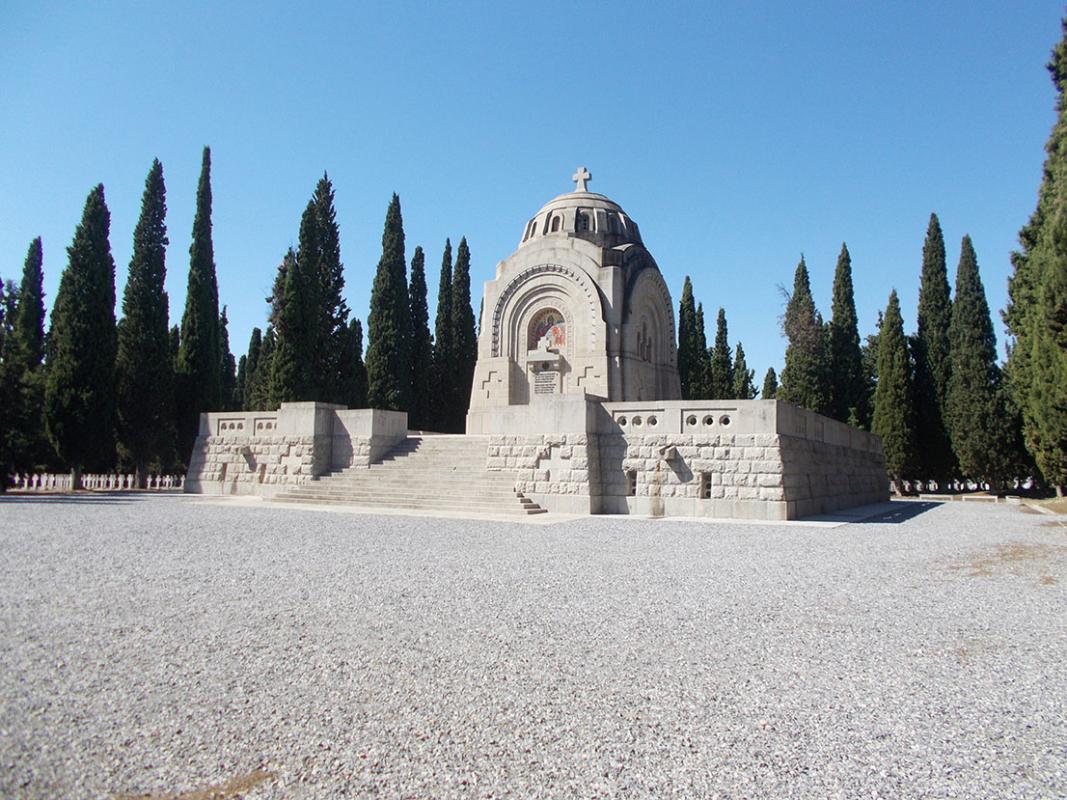
Serbian Mausoleum in Lembet Road Allied Military Cemetery.
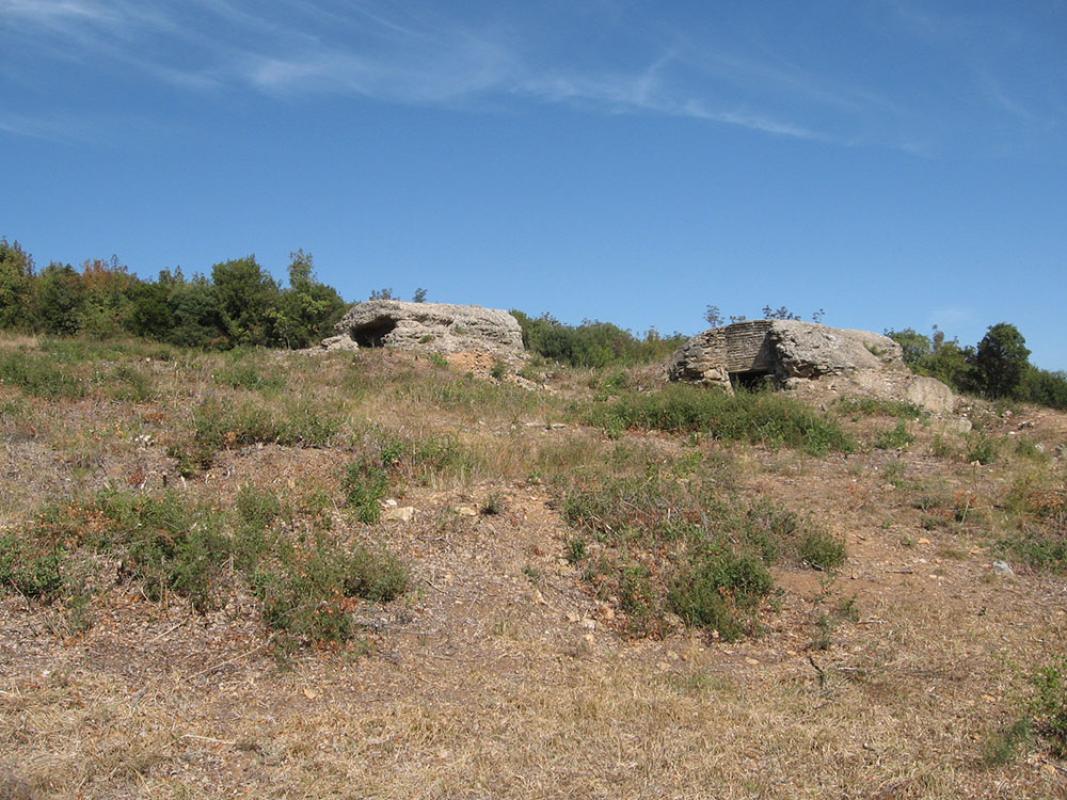
British artillery position on La Tortue.
Considering taking your first tour? View journals from our past tours:
2023: The War in Champagne (Instagram stories)
2022: Verdun and Saint-Mihiel (YouTube playlist)
2019: Gallipoli
2018: Harry S. Truman and the A.E.F.
2018: A.E.F. Centennial Tour of France
2017: The Doughboys in France
2016: British, Italian and American sectors of the Italian battlefields
2015: Imperial German Army on the Western Front
About Clive Harris
Raised in Hertfordshire, Clive developed a lifelong fascination with history. He spent seven years with the Royal Corps of Signals, serving operationally overseas with the 1st Armoured Division in BAOR — an Infantry attachment with the Royal Green Jackets, in Cyprus, Germany and France — and finally taking an instructor’s post in the Signals Wing of the Royal Military Academy Sandhurst. On leaving the army he joined his local Constabulary, serving 11 years in their Force Operations Room as a specialist communications officer and control room manager. In 1998, he began working as a speaker, writer, researcher and battlefield guide and since then has guided groups to the Somme, Ypres, Arras, Mons, Cambrai, The Hindenburg Line, Verdun, and Gallipoli for the Great War, as well as Normandy, Arnhem, The Italian Campaign, and of course the London Blitz for the Second World War. Clive is a Badged Member of the Guild of Battlefield Guides (No33) and also a member of the British Commission for Military History.
About Mike St Maur Sheil
Mike is the award-winning curator of Fields of Battle, Lands of Peace 1914-1918. After studying Geography at Oxford, in the early 1970s Mike began his career as a photojournalist covering “the Troubles” in Northern Ireland. Here he became associated with the New York picture agency, Black Star, and over thirty years later he is still in the fortunate position of being paid to do what he loves doing — taking photographs. Mike has visited over 60 countries around the world, working for a wide range of clients such as ABC-TV, BBC, Anti-Slavery International, British Red Cross, European Commission, National Geographic , The New York Times , Shell, Time and Time Life .
Images courtesy of Mike St Maur Sheil / Fields of Battle 1418

Accommodation on the Western Front Battlefields
Many of the First World War battlefield sites on the Western Front are located in rurual parts of Belgium and France. Nevertheless, there are towns and villages in cloe proximity which provide accommodation for visitors wanting to explore the battlefields.
In the last ten years some battlefield areas, such as the Ypres Salient in Belgium and the Somme battlefields in northern France, have become particularly popular destinations for visitors from Britain, Australia, Canada and New Zealand. For visitors wanting to stay on or near the battlefields our pages below provide information about a variety of accommodation including hotels, bed & breakfast, self-catering, hostels and camping available to suit the requirements and budgets of visitors travelling independently and for tour organizers wanting to book for groups of varying sizes.
- Yser/IJzer & the Belgian Coast, West Flanders
Ypres Salient Battlefields, West Flanders
French flanders & artois battlefields, northern france, somme battlefields, northern france, yser/ijzer & the belgian coast.
For accommodation in the area see our page:
Accommodation for the Yser/IJzer Battlefields
The battlefields of the Ypres Salient are in the semi-rural area of West Flanders. The landscape is mainly made up of agricultural small-holdings, fields, small rivers, woods and villages. The city of Ypres is a focal point in the area, offering a range of places to eat, WW1 related sites to visit and places to shop.
There is a good variety of accommodation in and around Ypres, in the nearby towns of Poperinge and Roeselare and in the outlying quiet country areas.
Accommodation in and around Ieper (Ypres)
For accommodation in the area of the French Flanders and Artois battlefields see our page at:
Accommodation on and around the French Flanders & Artois Battlefields
There are hotels to suit all budgets in the cities of Arras and Amiens, which lie to the north and south of the Somme battlefields. There are a few hotels in Albert and Bapaume and a number of self-catering houses and accommodation for bed & breakfast directly on the battlefields.
Accommodation on and around the Somme Battlefields
Related Topics
For information about the places to visit and sights to see on three battlefield areas of the 1914-1918 Western Front see our pages:
Visiting the Ypres Salient Battlefields
Visiting the French Flanders & Artois Battlefields
Visiting the Somme Battlefields
- Western Front Battlefields
- Battlefield Visits
- Memorials & Monuments
- Museums & Archive Collections
- Tracing Family History
- Researching Military History
- Education Resources
- Experience of the Great War
- Remembrance
- Organizations
- The Poppy Umbrella
- Tours from UK
- Tours start in Belgium/France
- Cycling Tours
- Walking Tours
- Self-Drive Tours
- Motorcycle Tours
- Tours by Rail
- Tours for Schools & Students
- Guild of Battlefield Guides
- Travel Maps
- Accommodation
Copyright © www.greatwar.co.uk All rights reserved.

Day Trip to Ypres, War Sites, and World War I Battlefields in Belgium
By Author Jurga
Posted on Last updated: April 19, 2023
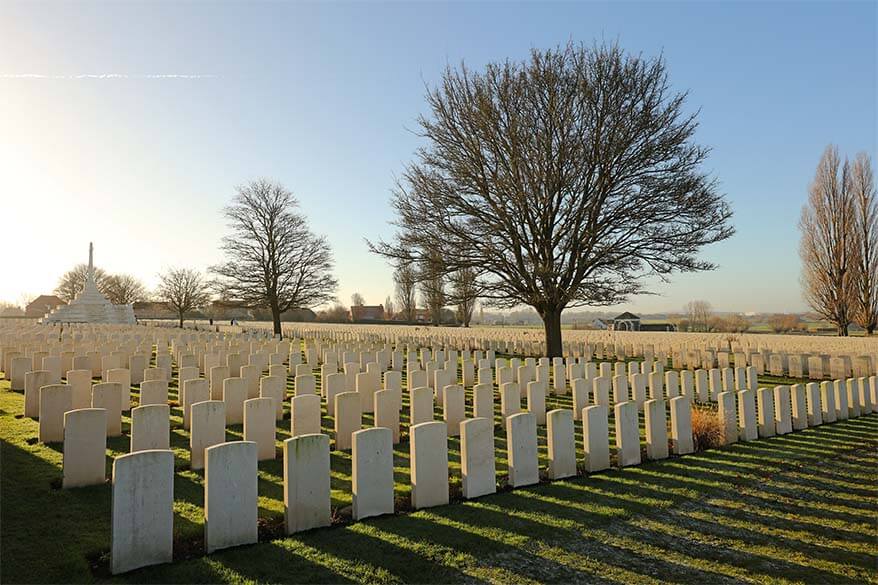
Does the name Ypres (Ieper) ring a bell to you? What about Flanders Fields – the World War I battlefields in Belgium ? If it does, you are now probably seeing images of the ‘great’ war, of the trenches and poison gas, and of hundreds of thousands of young soldiers who lost their lives in the war…
If you are wondering how to visit Ypres and the WW1 sites and battlefields in Belgium , then read on!
In this article, we are sharing our experience and tips for your visit to Ypres and the WWI battlefields. First, you can read about what to see and do in Ypres. In addition, you can find information about Tyne Cot and other famous Great War cemeteries near Ypres, as well as other WWI sites.
At the bottom of this post, you can find our suggested self-drive 1-day itinerary and also organized day tours that visit Ypres and WW1 sites in Belgium.
TIP: If you have no time to read the article and are looking for the best tour that visits Ypres and the battlefields, then check out this highly-rated day tour . It’s the best tour that’s available and ideal if you don’t have a car.
Day Trip to Ypres and World War I Battlefields
Why did we choose Ypres and the WWI battlefields for a family day trip?
This part of Europe has been a battlefield for so many armies throughout history, and Belgian schools do their utmost to ensure that future generations do not forget. The WWI battlefields near Ypres and the WWII Bastogne War Museum and Mardasson Memorial are the main war sites in Belgium and every child learns about their significance.
So it was not a surprise that our 8-year-old son came home from school one day and told us what he had learned about the terrible battlefields in West Flanders where hundreds of thousands of soldiers from all over the world died in the mud. He learned about the use of poison gas, Yperite, life in the trenches, and the fact that the soldiers were even eating their horses in order to survive in no-man’s-land.
We then realized that it was maybe time to bring him and his little brothers to the places he had heard and read about. In fact, we felt a bit ashamed, because it’s less than 2 hours from where we live and we hadn’t visited Ypres yet. While, in the meantime, tens of thousands of people come from all over the world to visit Ypres and the war battlefields every year…
So we thought it was a good time to take some time for reflection and to go back in time a hundred years (or does that sound too serious now?). And we decided to make a day trip to Ypres and surroundings.
We had a very interesting, moving, and educational day and so I want to share our experience. Whether you live here or are visiting Belgium, Ypres and the WWI battlefields are certainly worth the trip!

In Flanders Fields
Before I share practical information about visiting Ypres and the WWI Battlefields, I’d like to share this beautiful poem by John McCrae – ‘In Flanders Fields’.
In Flanders fields the poppies blow Between the crosses, row on row, That mark our place; and in the sky The larks, still bravely singing, fly Scarce heard amid the guns below.
We are the Dead. Short days ago We lived, felt dawn, saw sunset glow, Loved and were loved, and now we lie In Flanders fields.
Take up our quarrel with the foe: To you from failing hands we throw The torch; be yours to hold it high. If ye break faith with us who die We shall not sleep, though poppies grow In Flanders fields.

Tyne Cot Commonwealth War Graves Cemetery and Memorial
It was a cold December day and when we arrived in the tiny village of Zonnebeke the faint winter sun was there to welcome us.
It is here that some of the most infamous battles of WWI, the battle of Passchendaele (Passendale), took place in 1917, taking the lives of more than half a million soldiers.
Tyne Cot war cemetery is an obligatory stop when visiting the war battlefields in Belgium. It put us all in the ‘mood’ for the rest of that day: an impressive burial ground for almost 12,000 Commonwealth soldiers, most of whom the name/identity could never be established.
Our kids understood the meaning of a ‘world war’ after seeing headstones of soldiers from places as far away as Australia, New-Zealand, Canada, South-Africa or India in this tiny little village in Flanders.
The stone wall surrounding the cemetery makes-up the Tyne Cot Memorial to the Missing. Walking around here and seeing the names of almost 35,000 missing Commonwealth soldiers who died here after 1917 is very moving.
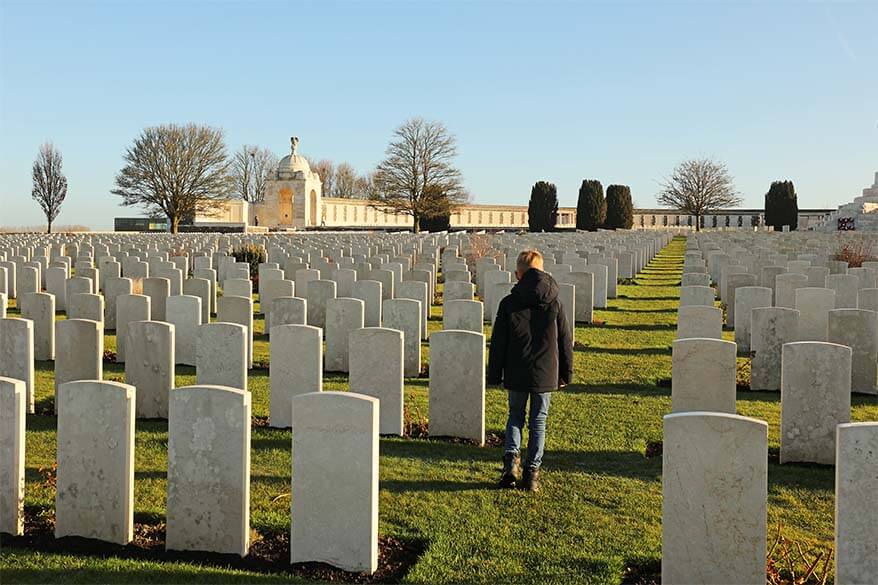
Practical information for visiting Tyne Cot:
- Tyne Cot is located approx. 10km outside the city center of Ypres. Address: Vijfwegestraat, 8980 Zonnebeke
- The Tyne Cot visitor’s center was closed during winter, but the cemetery can be visited anytime.
After visiting Tyne Cot, we drove to the center of Ypres, where we had a quick lunch. It wasn’t that easy to find something at a decent price and good quality in this tourist area in the low season, but there were a few restaurants open. I assume that there is more choice if you come here in the high tourist season.
After lunch, we visited the In Flanders Field Museum – it’s located right on the main town square of Ypres.

Ypres – Ieper
When you are visiting the battlefields, make sure to also take the time to explore the small town center of Ypres. If you are not sure where to go, you can follow the signs on the pavement for a tourist route – see the picture below.
Don’t miss the Cloth Hall where In Flanders Fields Museum is located, the St Martin’s Cathedral , the Menin Gate Memorial and the Ramparts next to the canal! Read on for more information about these places!

In Flanders Fields Museum and the Bell Tower
The In Flanders Fields Museum is situated right on the main square of Ypres town, in the impressive Lakenhalle building, or Ypres Cloth Hall . This is definitely a must if you want to get a picture of life during the war!
We steered the kids away from some of the videos and photographs that were too shocking in detail. On the other hand, our kids showed a huge interest in the stories told by children who survived the war, in the weapons, the clothes, and the various interactive displays.
For more information and practical information, check the official website of the In Flanders Fields museum .
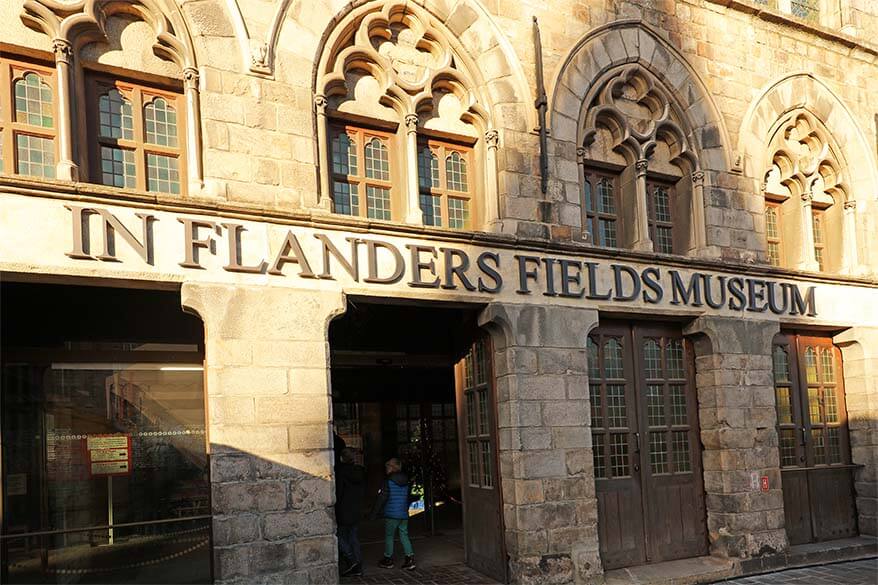
Inside the museum, you can also opt to climb the Bell Tower (Belfry). If you’re fit enough, make sure to do it! The views are great and in the distance, you can see the surroundings where all those battles of WWI took place.
Needless to say, we climbed the 231 steps of the Bell Tower (our kids can never resist a tower to climb!). From there, we had a fantastic view of the city, including the Menin Gate. It’s definitely worth the climb and the kids loved it!
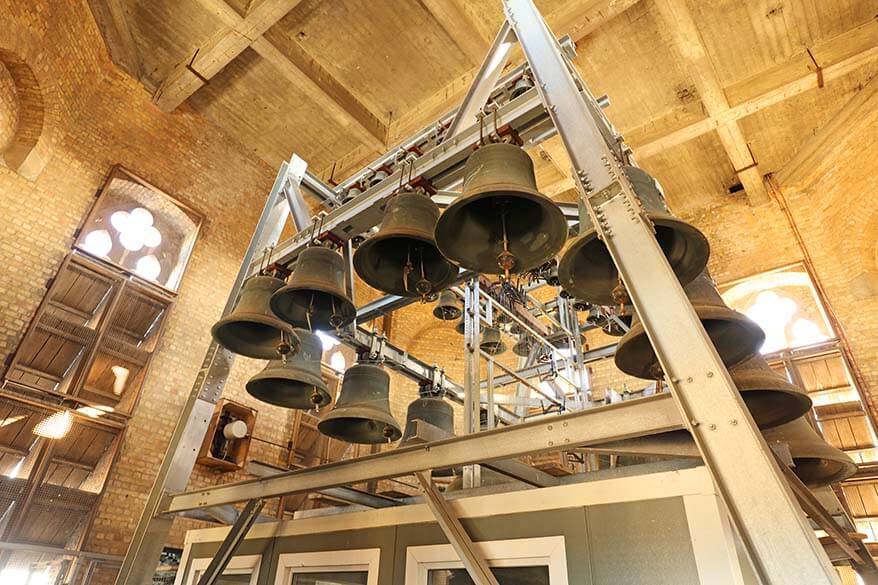
The Menin Gate and the Last Post
Another must-see landmark in Ypres, the Menin Gate , is sometimes also referred to as Ypres War Memorial. It has the names of almost 55,000 missing Commonwealth soldiers who died in the area between 1914 and 1917. Hundreds of thousands of men passed through this gate on their way to the battlefields.
The size of the monument is very impressive. But it’s not before you see thousands of names on the endless walls that you really get a lump in your throat. There are flowers everywhere and many ‘We will not forget’ messages that people still leave here every day.
“They shall grow not old, as we that are left grow old: Age shall not weary them, nor the years condemn. At the going down of the sun and in the morning, We will remember them.” – Laurence Binyon
Good to know: Every evening, at 8 PM, the Last Post is sounded at the Menin Gate . Following the Menin Gate Memorial opening in 1927, the people of Ypres wanted to express their gratitude towards those who had given their lives for Belgium’s freedom, and since that day for almost a century now, a daily ceremony is held at the Menin Gate. It’s a simple, but moving tribute.
The Last Post would certainly have been an unforgettable experience, but we also wanted to visit other places around Ypres, so we decided to leave this for a next visit. And indeed, a few months later, we returned to Ypres and listened to the Last Post. It’s so moving! If you can, wait for it.

The Ramparts of Ypres
If you have some time to discover Ypres more, it’s well worth walking on the walls surrounding the city.
The Ypres ramparts can be accessed via the Menin Gate. The official website of Ypres tourism has some more information about the Ramparts of Ypres .
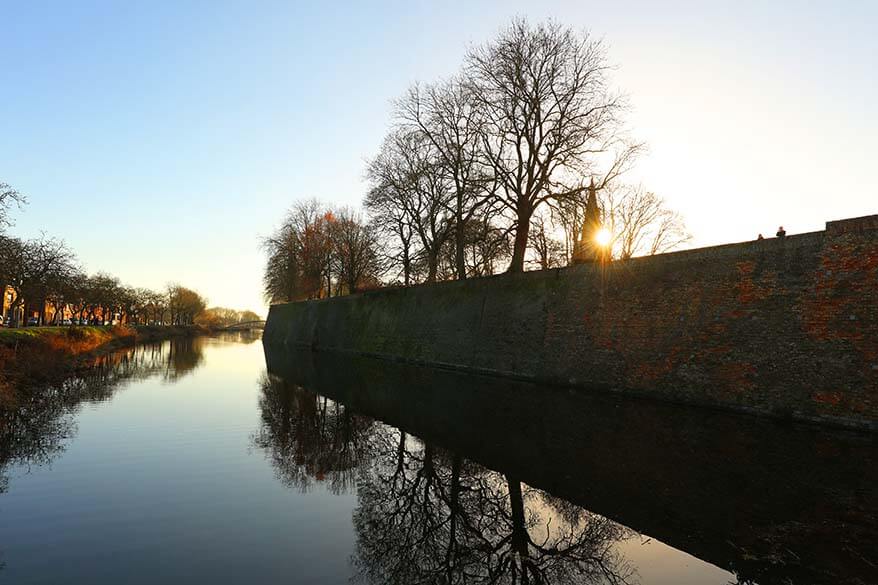
Yorkshire Trench & Dug-Out
Our kids wanted to see the trenches, so we drove to the Yorkshire Trench & Dug-Out where we could walk through the restored trenches.
We had some difficulties finding the place in the middle of an industrial area. In fact, the whole place has only been discovered in 1997 with the creation of the industrial site. While the kids walked through the trenches we read the explanatory signs. It’s so eye-opening to learn about life during the war.
Practical info for visiting Yorkshire Trench & Dug-Out:
- Yorkshire Trench & Dug-Out is not easy to find. It’s a very small place, amidst the industrial buildings, so drive slowly and look for a sign, on the left side if coming from Ypres. Address: Bargiestraat, 8904 Ieper
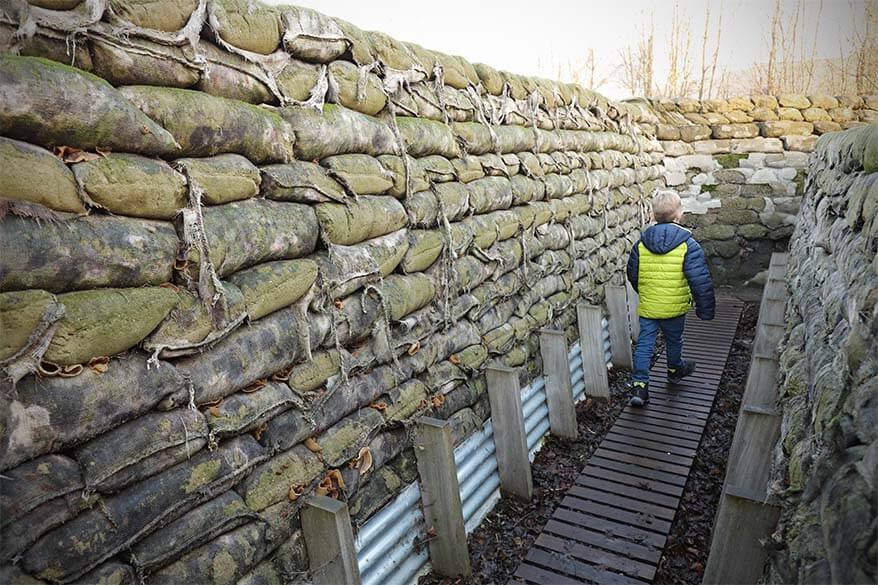
Langemark German War Cemetery
We continued our trip and went on to Langemark , where the first gas attacks took place, to visit the German war cemetery . More than 44,000 German soldiers are buried here, almost 25,000 of them in a mass grave.
If you come to meditate, this is a very good place to be. It was calm and quiet at the popular landmark like Tyne Cot, but this place was absolutely abandoned. The flat grave markers give this cemetery a distinct and modest look. The German graveyards are very different than the somewhat pompous Tyne Cot.
Practical info for visiting Langemark German war cemetery:
- Address: Klerkenstraat 64, 8920 Poelkapelle

Essex Farm Cemetery
One of the best known WWI sites in Ypres is the Essex Farm Cemetery . If you have the time, it’s definitely worth a visit too. You can read more about it here: Essex Farm .
Yser Tower – IJzertoren Diksmuide
The kids wanted to see the Yser Tower (IJzertoren) so we drove to the nearby town of Diksmuide . The Yser Tower is a peace monument and commemorates the soldiers killed on the Yser Front during WWI.
The Yser Tower, the highest peace monument in Europe, symbolizes the demand for peace. Words ‘No more war’ are written on the tower in the four languages of the fighting forces in the area during the First World War (Dutch, French, English, and German).
We knew it would be too late to visit the 22-floors museum (they close at 5 PM in winter), but we could at least make a walk around the peace site with the tower and the impressive Gate of Peace .

Trench of Death, Diksmuide
You can also visit the Trench of Death near Diksmuide . It’s a larger site than the Yorkshire Trench & Dug-Out. We skipped this as it was already dark by the time we were in the area. From what I understand, it’s a much more popular site with longer trenches, so if you have time to do just one, try the Trench of Death.
Here you can find more info for visiting the Trench of Death.
Vladslo German War Cemetery
Our next stop was the Vladslo German war cemetery . It’s one of the many cemeteries in the area, with almost 26,000 soldiers buried there.
It is an impressive place, with each gravestone containing 20 names of soldiers. But it is especially known for the Grieving Parents statues by Käthe Kollwitz , whose son is buried in this cemetery.
It was getting pretty dark by now and walking amongst the graves of so many young men who lost their life here was a moving and unusual experience. Although it all happened a hundred years ago we could still feel the pain, the suffering, and the death around us.
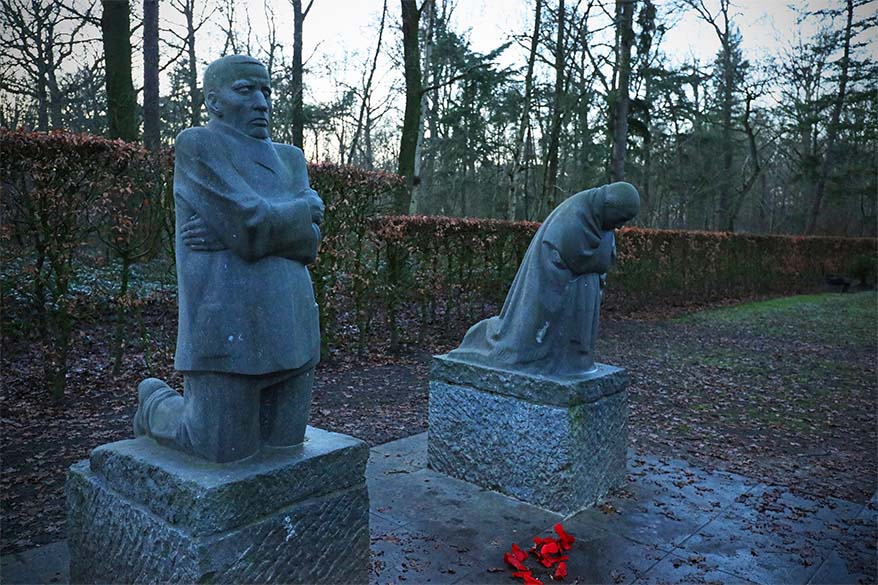
Suggested one day itinerary for Ypres and the World War I Battlefields in Belgium
Visiting Ypres and the war cemeteries was a unique experience, also for the children. We won’t quickly forget it!
If you are visiting Belgium, I highly recommend paying a visit to the WWI battlefields and Ypres.
If you have your own car and want to visit the most interesting WWI battlefields and cemeteries around Ypres in a day, I suggest the following itinerary:
Vladslo German war cemetery – the Trench of Death – Yser Tower and the Gate of Peace – Tyne Cot – Essex Farm or Langemark German War Cemetery – Ypres .
Best Tours to Ypres & WWI Battlefields
If you don’t have a car, it’s best to book an organized tour to Ypres (see below). You can also take a train to Ypres and visit the sights in town, but it’s not easy to see any other sights if you don’t have transportation.
Ypres tour from Brussels. This might be a good day trip to consider if you are staying in Brussels for a few days. However, the tours for visiting Ypres from Brussels seem to have been discontinued. So you’d have to first take a train to Bruges and then a tour from there – see below.
There are also organized tours to the Ypres battlefields that leave from Bruges . Bruges is very close to Ypres, so this is something definitely worth doing if you are staying there for a few days. Check this highly-rated tour to Ypres from Bruges .
TIP: You can easily take a train to Bruges from any other city in Belgium and join this tour for a day – it starts and ends at the train station in Bruges.
READ ALSO: What to See & Do in Bruges
Tips for Visiting Ypres and WWI Sites
- Plan ahead what you want to see , read about the places you want to visit, and decide on your itinerary in advance. There is so much to do in the area! If you travel with kids, you may want to tell them some history so that they know what to expect and understand what they see. Ypres City has an excellent website to help you prepare for your trip.
- If you are traveling by car, start your day early in the morning, especially in winter. Or stay overnight and take your time to explore the area more in-depth. Here you can find the best deals for Ypres accommodation .
- Take a picnic lunch if you are visiting the cemeteries during the day. We went to Ypres for lunch but wasted so much time on this.
- Dress warmly for the cemetery visits. There is a lot of wind in the area.
Books and Movies about the WWI
If you like history and want to know a bit more about World War I, here are some great book- and movie suggestions:
- The guns of August by Barbara Tuchman – about the start of WW I.
- The Great War: A Combat History of the First World War by Peter Hart.
- Voices from the Front: An Oral History of the Great War by Peter Hart.
- Movie and books about Passchendaele .
Yes, Ypres is worth visiting. The city is beautiful with some impressive landmarks, including Menin Gate and Flanders Fields Museum. In addition, Ypres is the starting point for visiting the World War I sites, battlefields, and war cemeteries throughout the region.
Ypres is best known as the site of five WWI battles between Germans and the Allied armies. Hundreds of thousands of soldiers have lost their lives near Ypres during the First World War. It was in Ypres that mustard gas (now called ‘Ieperiet’ or ‘Yperiet’) was used by Germans in 1917 for the first time.
At least 1 million people died in the battles near Ypres during WWI, with estimates up to 1,35 million casualties. First Battle (Oct-Nov 1914) had over 250,000 casualties, the Second Battle (Apr-May 1915) – around 100,000 casualties. The Battle of Passchendaele (July-November 1917) had around 400,000 to 800,000 casualties. The Fourth Battle of Ypres – 200,000 casualties, and the Fith Battle of Ypres had at least 10,000 casualties.
Yes, you can visit Ypres and Belgian WWI sites as a day trip from Brussels. Ypres is 120km from Brussels and it takes about 1,5 – 2 hours to drive there by car. You can also get to Ypres by train. But if you want to visit the war sites, it’s best to either come by car or with an organized tour.
So, this is our guide to visiting the Flanders Fields and Ypres. If you are visiting Belgium and are not sure how to best plan your time, please check our suggested Belgium itinerary for 3 or 4 days . It covers all the musts!
READ ALSO: Fun Facts About Belgium
More tips for visiting Belgium, Luxembourg & The Netherlands:
- Where to go: Belgium Itinerary
- Safety: Is Belgium safe?
- Best Things to Do in Brussels
- Best Areas to Stay in Brussels
- Brussels Flower Carpet
- Belgium in Winter
- Brussels Christmas Market
- Belgium Christmas Markets
- Best Things to Do in Antwerp
- Hidden Gems of Antwerp
- Best Theme Parks in Belgium
- Antwerp with Kids
- Best Things to Do in Bastogne
- Best Things to Do in Dinant
- Bastogne War Museum (WWII sites)
- 1 Day in Amsterdam
- 2 Days in Amsterdam
- Best Things to Do in Amsterdam
- Amsterdam Travel Tips
- Best Day Trips from Amsterdam
- Lisse Tulip Fields
- Tips for Visiting Keukenhof Gardens
- Best Day Trips from Luxembourg
If you found this post helpful, don’t forget to bookmark it and share it with your friends. Are you on Pinterest? Pin this image!
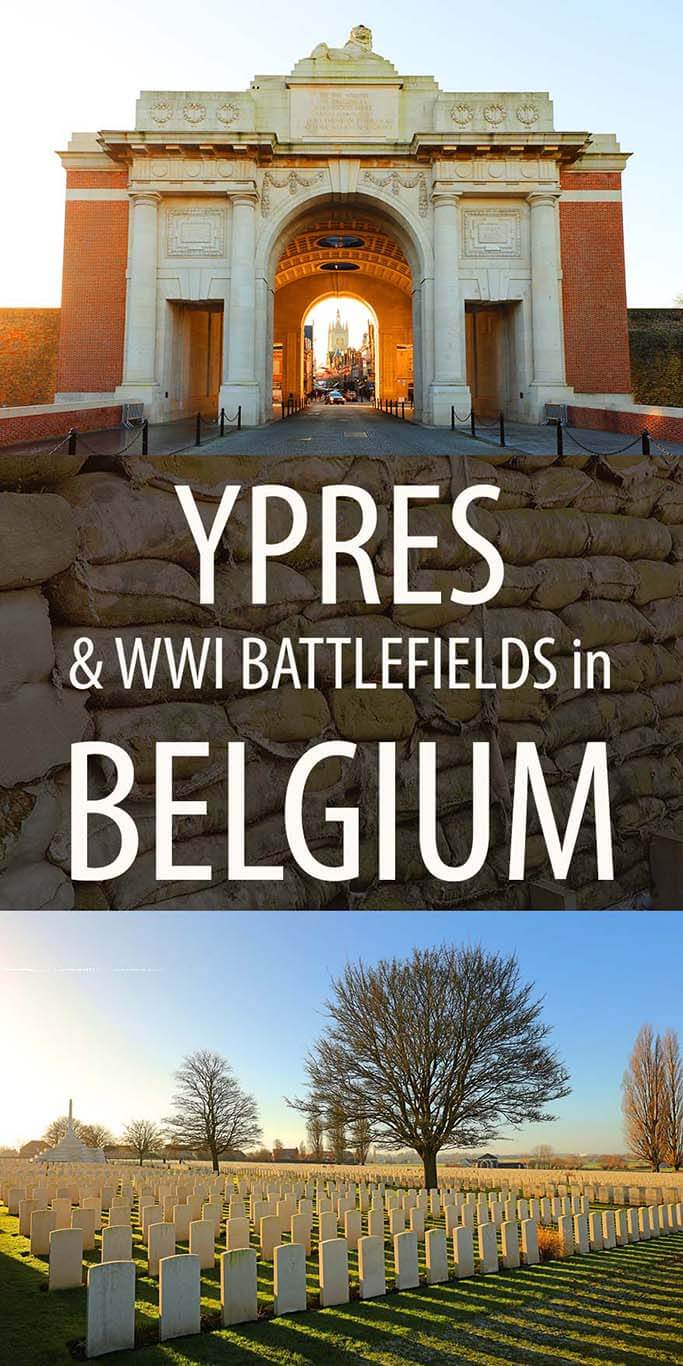
This site uses Akismet to reduce spam. Learn how your comment data is processed .
Friday 22nd of September 2023
thanks so much for your one day suggestions. We've just done our day and found it immensely fulfilling and moving. thanks again.
Saturday 23rd of September 2023
Glad to help, Phil. It is a very moving place to visit, indeed. And so sad too, even more so these days when it's very clear that the world still hasn't learned from the past... Enjoy the rest of your time in Belgium!
Saturday 28th of December 2019
Thank you for the informative blog and the one day itinerary suggestion. It worked great and we had an interesting and smooth day in the Ypres area - all thanks to you! :)
Tuesday 31st of December 2019
Glad to hear that you had a great time and enjoyed your visit to Ypres, Maarit. I really appreciate your kind feedback.
Mick stenson
Friday 13th of December 2019
I have visited ypres 3 times every time there is something i missed the time before. it is a very moveing place. i will be returning next year. thanks you
Monday 16th of December 2019
Agree with you, Mick. It's a special place and there is a lot to visit in the region. Enjoy your 4th trip!
Tuesday 15th of October 2019
Hi Jurga, it was great reading your blog. I am organising a tour for former, serving and military historians, next Oct. I am myself an ex cavalry officer from the Indian army, and living in the UK. Having gone through your blog, except for transportation to and back from the UK, would you have the time to help me with advice. Would be grateful and obliged. I organise tours to India which include the battlefields there in the east along the Burmese border
Hi Paddy, I'm sorry but I can't really help you with organizing a trip. I have as much practical information as possible on the blog, but really have no time to help hundreds of thousands of our readers with the practical side of planning their own trips. I'm sure you'll figure it out. Planning a trip to Belgium is nothing compared to India ;)
Saturday 18th of May 2019
Hello Jurga - thank you for your thoughtful and insightful post. We are visiting the first week in June and had decided to stay in Ghent as a good launching pad to brugge, ypres, brussels. We want to spend a day in Ypres. I would like to take a tour to provide (1) a good concise history and (2) transport to the key sites. What would you recommend? Do I do separate tours in ypres and outside? should I just rent a car and do the outside ypres on my own? It is just my husband and me. Thank you for your advice. Jackie (NYC)
Monday 20th of May 2019
Hi Jackie, generally, we recommend this organized tour. It visits Ypres and also some main places outside the town. The tour leaves from Bruges, but you can easily get there by train from Ghent. There are several trains per hour and it takes about 20-30min depending on which station/ train you take. If you rather rent a car, you can definitely visit all those places on your own, it just will require some preparation as there are so many cemeteries and places worth visiting. The tours know the best ones and they have perfected their itineraries to make sure you make the most of your time. We drove there from home and been to the area several times to later find out that we missed some interesting places... So I'd recommend going with a tour.
- Skip to primary navigation
- Skip to main content
- Skip to primary sidebar
- Skip to footer
TravelAwaits
Our mission is to serve the 50+ traveler who's ready to cross a few items off their bucket list.
9 Must-Visit World War I Sites In Flanders

Sharon Odegaard
- Activities and Interests
- Destinations
- History and Culture
Flanders Fields and the town of Ypres in Belgium will always be associated with the events of World War I. For more than four years, battle after battle raged in this area. Today, you can tour Flanders Fields and visit many World War I sites within just a few miles of Ypres.
Before you go, you will want to know at least a little about the war in Flanders. In August of 1914, at the war’s beginning, the Germans invaded Belgium on their way to France. The Germans also wanted to capture and use Belgian ports like Antwerp. At Ypres, the German advance was stopped by soldiers from Belgium, Britain, and France. In the winter, the armies dug in, building trenches they would occupy for years. The few miles of land in Flanders changed hands over and over, and little headway was made by either side. Many died in the fighting and in the mud of the Ypres Salient. Disease ravaged the armies, and poison gas, first used by the Germans in 1915, added another layer of gruesome injury and death.
Today, Flanders Fields is peaceful farmland, but it is also full of cemeteries and memorials. Even now, more than 100 years after the war’s end, unexploded artillery sometimes comes up during plowing. And soldiers long buried in the land are still being found and returned to their families.
Here are nine memorable World War I sites you can see in one day in or near Ypres. They can be seen in any order. You can visit Ypres and the Menin Gate in the daytime, and then return for dinner and the Last Post, for example. If you stay longer than a day, you can also visit places farther out.

The small town of Ypres is central to Flanders Fields. During World War I, Ypres was located within a few miles from the front as the fighting stagnated. Four major battles raged here in the Ypres Salient. Much of the town was destroyed.
A visit to Ypres is a must if you are touring Flanders Fields. You can eat here, shop here, stay in a nice hotel, and enjoy the town’s charming architecture without learning about any of its history. But once you discover what happened here during the war, you will see the area in a whole new light.
Since the war, the town’s buildings have been reconstructed in their original medieval style. Cloth Hall occupies the center of town. You can’t miss this tall, colorful building decorated with spires. Inside, you’ll find tourist information and a visitor center. The Yper Museum is here, offering interactive exhibits that cover 1,000 years of area history.
Another section of Cloth Hall houses the In Flanders Fields Museum , with its wealth of information about World War I in Flanders. You’ll see photos showing parts of Belgium that were totally destroyed during the conflict. One of the exhibits, Reconstructing Flanders Fields , is billed as “an ode to the resilience of forgotten men and women who cleared rubble and rebuilt their country after the First World War.”
Pro Tip: If you are in town for lunch or dinner, choose a patio table at De Trompet on the Market Square, next door to Cloth Hall. You’ll get a front-row seat to life in the busy town, and the salads and fish are delicious.

2. Menin Gate And The Last Post
At the entrance to Ypres is the Menin Gate , a beautiful war memorial to the British troops who died here during World War I. Names line the walls — more than 54,000 of them. These soldiers remain lost in the fields more than 100 years later. They hailed from Australia, Canada, India, South Africa, and the United Kingdom.
The gate, which existed before the war, was chosen for a memorial because hundreds of thousands of men passed through it on their way to the nearby battlefields.
Often, as farmers plow the fields and construction projects begin, the bodies of these soldiers are found. If a body is identified, the soldier is given a proper burial in a cemetery, and the name is then removed from this wall of the missing.
If possible, plan your time in Flanders Fields so that you can attend the Last Post under the arches of the Menin Gate. This ceremony takes place every evening at 8 p.m. The tradition started in 1928 and has continued every evening except during the time when the Germans occupied the town in World War II. Buglers from the Fire Brigade play, and families carry flags to honor the dead.
The Last Post bugle call is a song played by the British Army to mark the end of the day’s labors. At the Menin Gate, the music represents a final farewell to the fallen and signals their eternal rest. This ceremony of remembrance of those lost is short, but incredibly moving. The large crowd gathered each evening remains in total, respectful silence.
Be sure to arrive early for the ceremony. People stand on three sides of the gate, and the space fills up. Plan to be on your feet for a while, since there is no seating.

3. Tyne Cot Cemetery And Memorial
Located near the town of Passchendaele, the site of three major World War I battles, Tyne Cot Cemetery is a resting place for and memorial to the fallen soldiers from England, Canada, New Zealand, and Australia. It’s telling that out of the 12,000 graves, about 8,000 are marked unknown. These battles were so brutal that many of the young men who died could not be identified.
Tyne Cot, which first housed a barn, marks the farthest point reached by British forces in Belgium until near the end of the war. After the armistice, fallen soldiers were brought here from nearby Passchendaele, Langemarck, and other battlefields.
The Tyne Cot Memorial borders the curving rows of gravestones to the north. You can walk inside this memorial and see the names of nearly 35,000 men from the United Kingdom and New Zealand who died in the Ypres Salient after August of 1917 and were never found.

4. Hooge Crater Museum
This area saw fierce fighting from the fall of 1914 to the spring of 1918. A mine blew a crater here during one of the battles. Shortly after the war, a cemetery, church, and schoolhouse were built at Hooge. Today, the church holds the Hooge Crater Museum , with its collections of uniforms and weaponry. Plenty of artillery shells decorate the outside. Inside are displays of gas masks and other World War I artifacts.
The large cafe in the former schoolhouse serves delicious local foods. Consider planning your day so that you can be here at lunchtime. Relax on the patio and enjoy a ploughman’s lunch of meat and cheese or toasted ham and cheese, all served with fresh vegetables. The ice cream is a treat, too.

This area, the site of a notable battle of World War I, is preserved as it was during the war. The tunnels dug under Hill 60 were mined by Australians and blown up under enemy lines. The close proximity of the front lines is noted by the signs in the sidewalk. A German bunker also survives.
Australians took the Hill in June of 1917, Germans took it in April of 1918, and British and American troops took it back in September of 1918.

6. The Brooding Soldier
The Brooding Soldier looks down at you from atop a 33-foot granite column. Canadian troops held the line here in the face of the first poison chlorine gas attacks released by the Germans. More than 2,000 soldiers died. Notice that the memorialized soldier faces the direction from which the poison gas arrived.

7. German Military Cemetery
Of course, thousands of German men died in Flanders, too, and many are buried in the lovely German Military Cemetery just north of Ypres in Langemarck. The cemetery is one of four German cemeteries in Flanders. Under the shade of tall trees near picturesque farmland, more than 44,000 German soldiers rest. Gravestones laid flat are inscribed with the names of those in each site. Most moving is the Comrades Grave, the common grave of almost 25,000 unknown men.

8. Essex Farm Advanced Dressing Station And Cemetery
Attached to Essex Farm, just outside Ypres, the Essex Farm Advanced Dressing Station and Cemetery is a poignant place to visit.
The grave of one of the youngest of the fallen is here, and for that reason this is the World War I cemetery most visited by schoolchildren. This young man, only 15 years old, should have been in school, not on the battlefield, and that resonates with students.
The medic John McCrae worked in the field dressing station in primitive concrete bunkers at the edge of the cemetery. He is the author of the famous poem “In Flanders Fields”:
In Flanders fields the poppies blow
Between the crosses, row on row,
That mark our place; and in the sky
The larks, still bravely singing, fly
Scarce heard amid the guns below.
McCrae did not survive the war.
Take time to enter the primitive bunkers. Imagine the challenge of treating severely wounded men in this dark, dank, and dirty place.

9. Yorkshire Trench
The Yorkshire Trench system outside of Ypres has been restored to its original dimensions and exact location. The ground lay undisturbed until the 1990s, when construction workers started digging. They discovered a trench system just below the surface. Fortunately, part of the line of trenches is preserved and open to visitors. It’s amazing to walk in the footsteps of the men who lived and fought here 100 years ago.
Hill 62 is another place where the trenches have been restored and can be visited.
What To Know Before You Go
You could rent a car to see these World War I sights, or you could ride a bicycle. If you want a guide to inform you of the battles (and keep you from getting lost on the winding farm roads), I can recommend Quasimodo Tours . The guide is a local who is very knowledgeable about the history of Flanders Fields. The tour comes with an option to stay for the Last Post in Ypres.
The beauty of Flanders Fields comes as a surprise, considering its gruesome history. But just off the road, around a corner, or at the edge of a farmer’s crops, you’ll find memories of World War I. This war changed the world. By touring Flanders Fields, you’ll learn how it also changed the lives of many individuals, known and unknown.

As the owner of the travel blog, Exploring Our World , Sharon enjoys taking her readers on a journey with her. Articles often delve into the history of a place, and by adding in a generous number of photos, she inspires others to explore for themselves. In her early travels, she was most frustrated by coming back home and learning that she had missed a fascinating sight or a hidden gem. Now she helps travelers prepare for a trip by passing along travel tips, pointing out lesser known things to see, and alerting them to enjoyable day trips from major cities.
Her travel articles have been published by Stripes Europe Newsletter and the World War 2 Writing and Research Center. Whether she's discovering more about her hometown of San Diego, California or flying to faraway places, she enjoys sharing with travel lovers around the world.
- Women’s History
- Archaeology
- Britain’s best places
- Email digest
Britain’s best places to see: First World War museums and collections 9
by Alison Groom, 11-07-17 Post

The new First World War Galleries at IWM London. Photo Richard Moss
Here are the best places to explore artefacts and collections from the First World War in museums in Britain
The First World War continues to occupy a central place in the British national psyche. Despite the death in 2011 of Harry Patch , the last British veteran to experience the fighting in the trenches, we continue to memorialise and remember the Great War and today museums in the UK are looking at new ways of interpreting what was supposed to be the ‘war to end all wars’. There are dozens of military museums all over Britain where the sacrifices of a whole generation of young men can be explored. Here is a selection of the best of them.
Imperial War Museum London

© IWM London, First World War Galleries
IWM London has undoubtedly the finest collection of objects, archives and artworks relating to the First World War . Their atrium and First World War Gallery, opened in time for the centenary of World War One, features over 1300 objects from the IWM’s peerless collection, the new gallery also boasts around 60 interactives and films and a newly designed Trench Experience.
Personal stories are told through the artefacts bringing you close to the horrors of the Great War – like the officer’s leather glove, shrunk to the size of a child’s hand by the effects of poisonous gas or the remnants of chamise and life ring worn by a woman who survived the German sinking of the Lusitania after being sucked into the liner’s funnel then blown clear when the engines exploded.
Touchscreen controlled interactive tables and hands-on exhibits tackle everything from recruitment to rations. There are helmets, trench clubs, mills bombs, field guns, ghostly gas masks and relics from the Red Barron, all set within a narrative that begins with Britain as a great Empire Power and concludes with how the war changed the world forever.
The museum’s collections can also be explored via the website where a search of the First World War objects and archives yields pages and pages dealing with different aspects of the First World War and the collections held at the museum.
National Army Museum London

A woman assembles amunition in a factory during WW1, Courtesy of the National Army Museum
Also in London, the newly re-opened National Army Museum in Chelsea houses over 2,000 objects relating to the First World War spread across thematic galleries exploring the changing role of the army in society and the experiences of soldiers
Notable among their collections are the number of artefacts, which tell the story of women’s involvement in the War. Women stepped into a variety of roles traditionally assigned to men during the First World War, freeing up young men to fight on the front line.
The National Army Museum’s online exhibition, First World War in Focus, also reveals the stories of the individuals involved in the First World War and includes films about uniforms, weaponry and equipment of the British soldier throughout the conflict.

The Black Watch Museum Perth

The First World War Gallery, Courtesy of the Black Watch Museum
Located in Balhousie Castle, Perth, the Black Watch Regimental Museum is part of the Regimental Headquarters of the Black Watch (Royal Highland Regiment).
The First World War Gallery features a kilt worn in WWI still covered with Flanders mud and the colours of the 6th Battalion who were awarded the Croix de Guerre as a unit in 1918.
25 Black Watch Battalions served in the First World War, with more than 50,000 men passing through the Regiment. 8,000 of them were killed and over 20,000 wounded.
The display also features grave markers, a gas mask and silk banners printed with all the names of those killed.
The Museum of Liverpool Liverpool

The Waterfront to Western Front exhbition room, with exhibits on display.
The Museum of Liverpool has a poignant collection of objects used by soldiers in the First World War on show and an exhibition, From Waterfront to Western Front, which explores life on both the front line and at home in Liverpool. The war took 13,000 Liverpudlian lives over the course of the four year conflict.
In the Battle Gallery you can read a blood-stained diary; see objects hit by shells and bullets; watch actual footage of the King’s Regiment on the Western Front and even hear a soldier describing conditions in the trenches.
This summer visitors to the museum can see the medals of Captain Noel Chavasse , the only serviceman to be awarded the Victoria Cross (VC) twice during the First World War. On display at the Museum of Liverpool from July 31 to January 5 2018 it is the first time this important medal group, on loan from Lord Ashcroft KCMG PC, has gone on public display in Liverpool, the family’s home from 1900.
Enjoying this article? Get more stories like this delivered to your inbox.
Royal welch fusiliers museum caernarfon.

Colours – Courtesy of the Royal Welch Fusiliers Museum
The Royal Welch Fusiliers Regimental Museum has five beautifully refurbished galleries occupying two towers of Caernarfon Castle – a World Heritage Site.
You can learn how the Regiment won 14 Victoria Crosses and hear the words of famous writers who served with the Royal Welch during the First World War, such as Siegfried Sassoon, Robert Graves, David Jones, Frank Richards and Hedd Wyn.
The Lloyd George Museum & Highgate Cottage Llanystumdwy

The Versailles Peace Treaty, Lloyd George Museum CNV00018 Courtesy of Gwynedd Archives Service
Home to the future Prime Minister between 1864 and 1880, Highgate Cottage is maintained as it would have been during the Victorian period.
The museum features caskets and scrolls presented to Lloyd George as freedom honours, mainly for his work as Prime Minister when he led the country during the final, bloody years of the First World War.
There are also medals, paintings, photographs and documents, most famous of which being the Versailles Treaty, which was signed at the end of the First World War, imposing harsh restrictions on Germany and arguably fuelling the Second World War.
The Victorian garden and classroom bring visitors back in time to what we now know was the lead up to the Great War.
The Royal Engineers Museum Gillingham

First World War Gallery, Courtesy of The Royal Engineers Museum
In may ways the Royal Engineers Museum in Gillingham, which has just reopened, is the perfect place to begin an investigation of the First World War. It was the sappers of the Royal Engineers who designed, developed and in many cases built the trench systems of the Western Front. They were also in charge of accommodation, tunneling, army camps, new developments in military weapons technology and even oversaw the introduction of the Mills Bomb. By the end of the war The Corps had increased in size from 20,000 to 300,000 men.
The museum has a suitably rich collection of objects and artefacts from this pivotal period. Items range from battered pickelhaube helmets, grave markers and sepia photographs to a tunneler’s gas mask, early examples of camouflage, a flame thrower, gas shells and a huge collection of artwork – much of it by Corps members.
The museum also holds several Victoria Crosses awarded to Royal Engineers, among them the VC awarded posthumously to Sapper Hackett, the only tunneler to be awarded a VC in the First World War.
The Tank Museum Bovington

Tank Men Exhibition, Courtesy of the Tank Museum
Of all the killing machinery developed during the First World War, the tank is arguably the most dramatic and enduring. The Tank Museum at Bovington, Dorset, has many relics of the trench wars of 1914-18 and holds the biggest collection of First World War tanks to survive anywhere in the world.
The museum’s Mark V is one of the last First World War tanks to remain in full operating condition and their Mark II actually fought in the Battle of Arras in 1917. You can even get inside the Mark V** which has a fascinating walk-through facility.
Also in the museum is a dramatic trench display telling a soldier’s story – visitors follow in the footsteps of new recruits, arriving on a railway platform, walking the road to the trenches, walking through a British trench, passing through no-man’s land and then finally entering a German trench as a tank breaks over the top.
RAF Museum London

First World War in the Air Gallery. Photo Richard Moss
The RAF Museum’s collossal First World War in the Air Gallery is set in the historic Graham White Hangar. The collection is arguably the most comprehensive display of First World War aircraft anywhere in the world. Redeveloped and opened to the public in 2014 this historic space displays a collection of 13 aircraft of the period of the First World War.
Among them is the Sopwith Camel – the highest scoring fighter of the war – and the German Fokker D.VIII, which saw Herman Goering, later head of Hitler’s Luftwaffe, become an ace. The museum’s massive haul of smaller First World War objects – hitherto in storage – are now beautifully displayed in the three central cases allowing you to pour over personal objects, including diaries, mascots, medals, uniforms, weaponry and bullet strafed fragments of rudder art, all of which help to bring the story to life.

more like this
- Britain’s best places to see: Viking museums and collections
- The collection that tells the story of women’s work in the First World War
- These First World War letters and stories reveal a soldier’s love for his child
The Somme Museum Newtownards, Northern Ireland

Messines Exhibition, Courtesy of The Somme Association
In Northern Ireland, just south of Bangor, lies the Somme Heritage Museum. The museum is built on the site where soldiers of the 108th Brigade of the 36th Ulster Division were trained after the outbreak of war.
The museum provides an insight into Ireland’s role in one of the most crucial battles of the entire war. As well as this, free exhibitions explore the role of sea warfare in weakening the German offence and look at the crucial Battle of Jutland which enabled Britain to carry on its naval blockade of Germany. If you want to get the full feel for the impact the dreadful battle of the Somme on Ireland then a one hour tour should do the trick.
National Maritime Museum London

Jutland 1916: WWI’s Greatest Sea Battle © National Maritime Museum, London.
Opened to mark the centenary of the Battle of Jutland, the largest naval battle of the First World War, the National Maritime Museum’s permanent exhibition Jutland 1916: WW1’s Greatest Sea Battle brings to life the story of the clash which claimed more than 8,500 lives.
The galleries focus on the ships, technology and the people behind the battle, telling the personal stories of the sailors and their families, and exploring the experience of serving both on British and German ships. The exhibition also explores the frustrations around the battle of which the human cost was so high, but no decisive victory was achieved.
There are incredible objects on display – many for the first time – including a shipbuilder’s model of the HMS Queen Mary, the naval battlecruiser sunk at the battle, leaving just 188 survivors. The story of the battle is revealed through paintings, photographs, models and medals and there is also material from German archives which uncovers the other side of the battle.
HMS Caroline Belfast

The HMS Caroline [now a museum ship based in Alexandra Dock in Belfast] © William Murphy (CC BY-SA 2.0)
Belfast’s Titanic Quarter is dominated by not just one famous ship. The sole survivor of the Battle of Jutland and the only British First World War light cruiser still afloat, HMS Caroline is a true WW1 relic, and an absolute must-see. Launched not long after the outbreak of war in 1914, the ship has been an iconic part of Belfast’s maritime life for more than 90 years, and is now a floating museum revealing the cruiser’s history and the story of the greatest WWI naval battle.
A film about the Battle of Jutland summarises the tense 36-hour clash and recreated spaces on-board reveal life in the Captain’s quarters, mariners’ mess, sick bay and galley. In the engine rooms you can see HMS Caroline’s original engines and listen to the authentic thunderous roar that they would have made at full speed.
Fleet Air Arm Museum Yeovil

Sopwith Pup © Hugh Llewelyn (CC BY-SA 2.0)
Focusing on naval aviation, the brilliant Fleet Air Arm Museum charts the history of military air power at sea, from the early manned kites and bi-planes to the incredible naval technology we see today.
Each hall takes you through a different era in naval aviation – in Hall 1 The Navy’s Air War commemorates the Royal Naval Air Service, the air arm of the Royal Navy which operated during the First World War. With WW1 aircraft, interactives and personal stories from the early days of naval aviation, the display tells the story of the humble beginnings of air warfare at sea.
Also in Hall 1 Jutland 1916 – Frederick Rutland tells the long and fascinating story of one plane and its pilot which fought in the Battle of Jutland – the first time an aircraft was used at sea to assist the fleet. The Short 184, on show in the display survived World War I but was badly damaged during World War II, and its pilot Frederick Rutland has an equally fascinating story.
popular on Museum Crush
Post The Yorkshire obsession with Ancient Egyptian architecture The Yorkshire obsession with Ancient Egyptian architecture The Yorkshire obsession with Ancient Egyptian architecture
Post The beauty and danger in Victorian Glass Fire Grenades The beauty and danger in Victorian Glass Fire Grenades The beauty and danger in Victorian Glass Fire Grenades
Post Mods, Rockers, Skinheads, Punks: Snapshots of Southend’s Subcultural History Mods, Rockers, Skinheads, Punks: Snapshots of Southend’s Subc... Mods, Rockers, Skinheads, Punks: Snapshots of Southend’s Subcultural History
Post 11 relics of medieval England at Rievaulx Abbey 11 relics of medieval England at Rievaulx Abbey 11 relics of medieval England at Rievaulx Abbey
Post Six places to find Virginia Woolf and the Bloomsbury Set Six places to find Virginia Woolf and the Bloomsbury Set Six places to find Virginia Woolf and the Bloomsbury Set
9 comments on “ Britain’s best places to see: First World War museums and collections ”
I am amazed that there is no reference to the NMRN exhibition on the Battle of Jutland – in Portsmouth! or indeed HMS Caroline in Belfast- which fought at the battle of Jutland!!
Very good call Tim. We will certainly add HMS Caroline and also reconsider the NMRN, which wasn’t included as we were focussing on visits where a permanent collection could be explored. Richard (editor)
then we need to add HMS M.33 unique survivor of Gallipoli and a permanent collection!
Or to the excellent Bombardment of the Hartlepools gallery at the Museum of Hartlepool, a partner venue of the NMRN Hartlepool.
Excellent articles all! Now there are more sites that must be added to an ever growing list of British military (and natural history) museums to visit on a planned trip to the U.K. next year.
The national Army museum, disappointing, although very good for children it is very poor compared to what it was like prior to the reconstruction. The fantastic collection of medals are no longer on display, and some, especially the Peninsular Gold Medal are not captioned.
From a military collector’s point of view it is not worth the visit. This comment is echoed by many other collectors in the British medal Forum
A great wee museum …. https://www.facebook.com/Military-Museum-Scotland-SCIO-591070184353808/?ref=bookmarks
King & Country, Bankfield Museum Halifax winner of the Public History Prize by the Royal Historical Society.
The exhibition opened on the 4 August 2014 and runs until the 22nd December 2018. Each year we have also hosted a range of related events and talks. It ‘s not a permanent exhibiton, so really needs to be brought to anyones attention. We have been several times it is so good. Covers many aspects and gives personal perspectives. Access is (surprisingly) only by staircases, otherwise it is HIGHLY RECOMMENDED.
We have a gallery at the Royal Pavilion which looks at the Indian Military hospital based at the Pavilion and two other Brighton venues. It provides a fascinating insight into some of the Commonwealth soldiers who fought in WW1. https://brightonmuseums.org.uk/royalpavilion/history/ww1-and-the-royal-pavilion/
Add your comment Cancel reply
Your email address will not be published. Required fields are marked *
Add your comments below:
your name *
Your Email *
Save my name, email, and website in this browser for the next time I comment.
Currently you have JavaScript disabled. In order to post comments, please make sure JavaScript and Cookies are enabled, and reload the page. Click here for instructions on how to enable JavaScript in your browser.
World War I centenary: 10 places to commemorate the Great War
Oct 28, 2013 • 6 min read
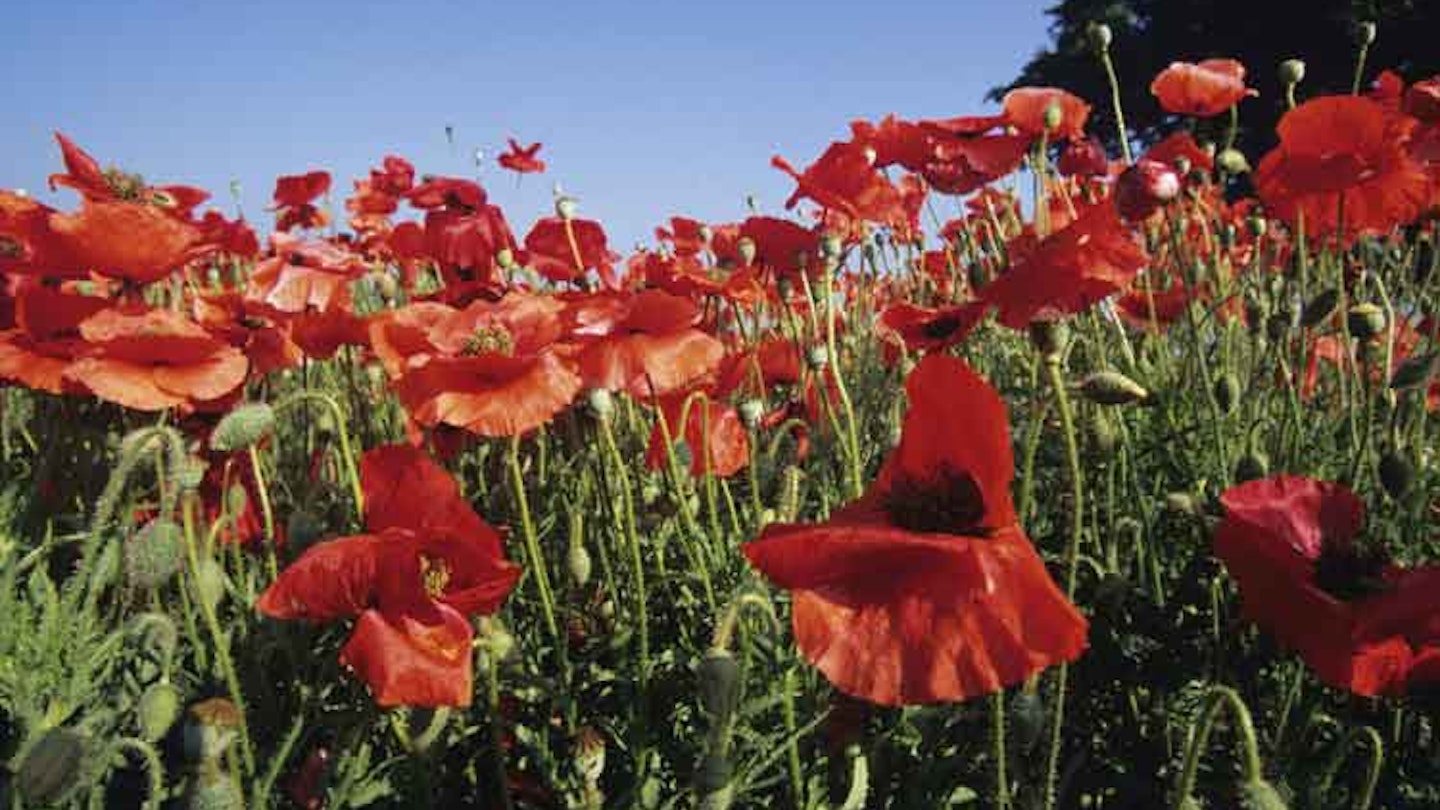
2014 marks the centenary of the start of the Great War (28 July 1914 to 11 November 1918). Here are some poignant reminders of this devastating conflict.

A field of wild Flanders poppies. Image by Tom Brakefield / Stockbyte / Getty Images.
Poppy Fields, Flanders , Belgium
‘In Flanders fields the poppies grow; between the crosses, row on row…’ Probably the most celebrated of the WWI poems, these beautifully evocative opening lines were penned by a Canadian Lieutenant Colonel, John McCrae, in homage to a lost friend. As war ravaged the countryside and churned the earth, the disturbance stimulated the growth of poppies; they illuminated the countryside and have since become the defining image of remembrance to the dead. The poppies still bloom each year, providing nature’s own homage to the bravery of those who made the greatest sacrifice.
Poppies are in bloom on the Western Front battlefields from April to early July, but unseasonal weather can affect their growth.
Gallipoli , Turkey
Away from northern Europe’s front lines, some of the fiercest fighting occurred at Gallipoli . This eight-month campaign proved disastrous for Allied forces – some 34,000 Brits, Aussies and Kiwis perished here. The Gallipoli peninsula is 240km southwest of İstanbul , flanked by the Aegean Sea on one side and the Dardanelles channel on the other. The Allied plan was simple – send a flotilla up the Dardanelles to seize control of İstanbul and open a naval passage to Russia. But Ottoman troops provided unflinching resistance that forced the Allies to withdraw.
Trooper Tours ( www.troopertours.com ) will take you around the key sites in Gallipoli.

Graves of British WWI soldiers at Tyne Cot British Military Cemetery. Image by Dennis K Johnson / Lonely Planet Images / Getty Images.
Tyne Cot Cemetery, Zonnebeke, Belgium
Of all the Commonwealth cemeteries marking the fallen heroes of WWI, Tyne Cot is the largest, containing 11,954 graves of soldiers from the UK, Canada, Australia, New Zealand, South Africa and the West Indies. The cemetery also carries the names of a further 35,000 soldiers who were never found. At the centre of the graves, the Commonwealth Cross of Sacrifice stands atop a German pillbox, overlooking row upon row of white headstones. There’s no more powerful introduction to the sorrow of war.
Zonnebeke is 75km south of Bruges . Combine a visit to Tyne Cot with a trip to the Memorial Museum Passchendaele 1917 ( www.passchendaele.be ).
Christmas Truce Memorial, Frelinghien, France
Amid the horror of front-line fighting, stories of simple humanity have become legend; none more so than the Christmas Truce of 1914. With the war still in its infancy, hundreds of Allied and German soldiers near the French town of Frelinghien downed their guns on Christmas Day and engaged in a remarkable truce. Official records are sketchy but the most famous story recollects a football match on the battlefield – nobody has been able to corroborate this, but enough evidence of the truce exists for it to be marked with a plaque at the edge of the village.
Frelinghien is 90km southwest of Calais ; combine it with a visit to Ieper , 15km north.

Menin Gates in Ieper, Belgium. Image by Dennis K Johnson / Lonely Planet Images / Getty Images.
Menin Gate Memorial , Ieper , Belgium
The battlefields around Ypres saw appalling conflict. At the eastern end of town stands Menin Gate, a memorial to more than 54,000 soldiers whose final resting place remains unknown. Every evening at 8pm, the road beneath the arch is closed to traffic and buglers from the local fire brigade sound the Last Post, the haunting commemoration to soldiers lost in war. On summer evenings the event draws large crowds who stand silent in remembrance; in the bleak winter, the bugle notes drift away in the wind.
Ypres is now known by its Flemish name, Ieper. Menin Gate is close to the marketplace.
Wilfred Owen’s Grave, Ors, France
Wilfred Owen was a British poet and one of WWI’s most celebrated voices. He enlisted in October 1915, and his work was influenced both by battlefield trauma and the writing of his friend, Siegfried Sassoon. His poems are regarded as the finest records of firsthand experience – Anthem for Doomed Youth is among the most famous. Owen was killed one week before Armistice Day – the telegram informing his mother was delivered amid victory celebrations – and his grave can be found in the Ors Communal Cemetery.
The village of Ors lies between Le Cateau and Landrecies, 85km southeast of Lille .

The Latin Bridge in Sarajevo. Image by Andrew Burke / Lonely Planet Images / Getty Images.
Latin Bridge , Sarajevo , Bosnia & Hercegovina
When Archduke Franz Ferdinand of Austria was assassinated in Sarajevo on 28 June 1914, few would have imagined the carnage that would follow. Ferdinand was targeted by a revolutionary movement known as Young Bosnia, and his death was the catalyst that led Austria-Hungary to declare war on Serbia. Germany, allied to Austria-Hungary, soon joined the fold. The spot of Ferdinand’s death was close to the Latin Bridge in the heart of the city, and a small plaque commemorates the event. There’s no fuss and precious little pomp, but for budding historians a visit here forms part of the ultimate WWI pilgrimage.
Sarajevo is one of Europe’s up-and-coming cities, so you can combine your history fix with top shopping and entertainment.
Armistice Glade, Rethondes, France
11 November 1918; the end of the Great War. After four long years, and with Europe on its knees, Germany accepted the armistice conditions proposed by the Allies. Under the command of Marshal Ferdinand Foch of the French Army, the selected congressmen assembled to sign the treaty. The location Foch chose was the carriage of his personal train, secluded in the tranquil forest of Compiègne. Today the forest hides a glade with a war memorial, under the gaze of Foch’s statue. Alongside lies a reconstruction of the Armistice Carriage – the original was seized by Nazi troops in WWII and destroyed in 1945.
The Armistice Glade lies between Rethondes and Compiègne (route D546). Trains ( www.sncf.com ) run from Paris Nord to Compiègne.
Trench of Death, Diksmuide, Belgium
The Western Front was a trench network covering thousands of kilometres, extending south from Nieuwpoort on the Belgian coast to the French border with Switzerland. Bitterly cold, waterlogged and thick with mud, the trenches offered soldiers precious little protection. In the countryside, 1.5km from the town of Diksmuide, a small section has been preserved. Known as the ‘Trench of Death’, conservation work ensures that this remains a unique example of battlefield life.
The Trench of Death is 45km southwest of Bruges, which makes a good base for exploring other battlefields and cemeteries.
Lochnagar Crater, La Boisselle, France
The five-month-long Battle of the Somme was one of WWI’s defining battles, with more than a million dead. Yet few know that its roots lay deep beneath the battlefield. In an attempt to outfox the Germans, British troops started the offensive by blowing them up from below. Tunnelling teams laid 10 huge mines under enemy lines, detonating them simultaneously. Stuffed with 28.8 tonnes of explosives, the assault gave the Allies an advantage in the battle. The massive crater (90m across, 30m deep) can still be seen.
La Boisselle is 155km north of Paris. From the village, follow the signs for ‘La Grande Mine’.

Seek out the world's most thought-provoking sights with Lonely Planet's Best in Travel 2014 .
Explore related stories
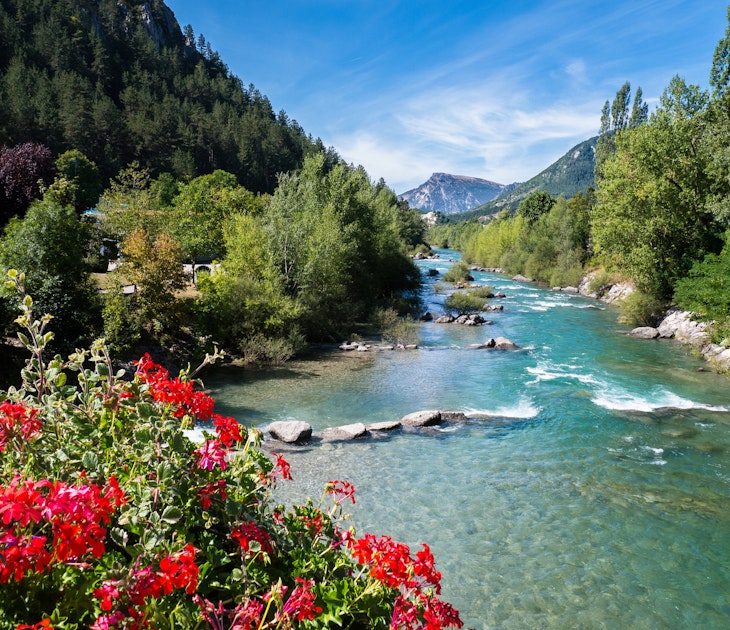
Jul 13, 2021 • 5 min read
This first-timer's guide to France can help you narrow down the best places to go, and other top tips to make the most of your visit.

Feb 26, 2020 • 11 min read

Oct 18, 2019 • 5 min read

May 22, 2017 • 5 min read
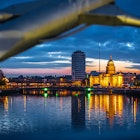
May 8, 2014 • 7 min read
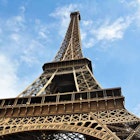
Jan 1, 2014 • 7 min read

Oct 10, 2013 • 5 min read

Sep 23, 2013 • 4 min read

Nov 20, 2012 • 5 min read

Feb 15, 2024 • 4 min read

Sign Up Today
Start your 14 day free trial today

The History Hit Miscellany of Facts, Figures and Fascinating Finds
Explore World War One History in France
France bore witness to many bloody battles during world war one, and is home to the remains of many battlefields, memorials and museums as a result. here's our pick of 10 of the most important attractions for anyone with an interest in france's world war one history..

Lucy Davidson
26 aug 2021, @lucejuiceluce.
The devastating nature of the ‘War To End All Wars’ was partially conducted along the Western Front. Huge armies dug into the muddy fields of France and set-piece advances involving hundreds of thousands of men. The result was a huge loss of life, often for little gain.
Today, visitors to the French World War One battlefields can experience recreations in museums, explore surviving trench works and observe memorials and cemeteries to those who died.
A number of battlefields are available to visit, including the Somme, Verdun and Pozieres. Other popular sites include Louvemont, the Lochnagar Crater and the Ulster Memorial Tower.
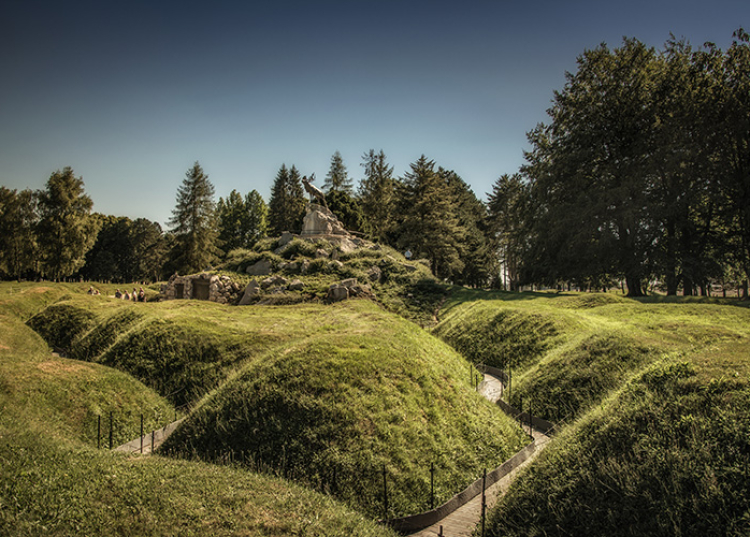
1. Somme battlefields
The Somme battlefields constitute a series of sites where the Battle of the Somme was fought during ‘The War to End All Wars’ – the First World War. They are among the most famous battlefields in France.
Today, a forty mile route known as the Circuit of Remembrance starts from either the town of Albert or that of Peronne, winding through numerous battle sites, memorials and museums. Those who wish to embark on this route of Somme battlefields can download audio guides to the route for free from various sources, including from the website of the Historial de la Grande Guerre museum.
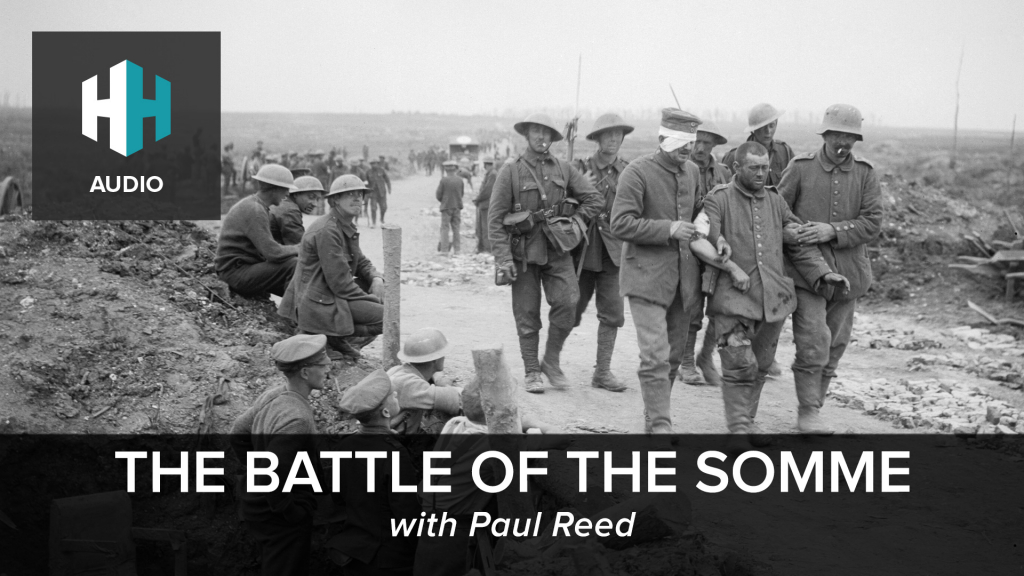
2. Verdun Memorial
The Verdun Memorial is a comprehensive museum of the Battle of Verdun and a memorial to fallen soldiers set in the Verdun battlefield, one of the most famous WW1 Battlefields in France. The memorial is set amidst the site of this battle and the surrounding landscape bears the scars of the war, including mine and shell craters. The memorial displays an array of objects and documentation dating back to the battle, including weaponry, French and German aircraft, photographs and medical equipment.
Laid out over two floors, the Verdun Memorial Museum immerses the visitor in the realities of the battle by recreating the trench system and using multimedia presentations to guide visitors through the events of the war. Exhibits are translated into English, French, German, Italian, Spanish and Dutch, making the Verdun Memorial very accessible and the museum is divided thematically. For those wishing to tour Verdun generally and see the different sites, the memorial offers advice and itineraries, meaning it’s a good starting point for anyone touring independently. It also has a dedicated educational centre.
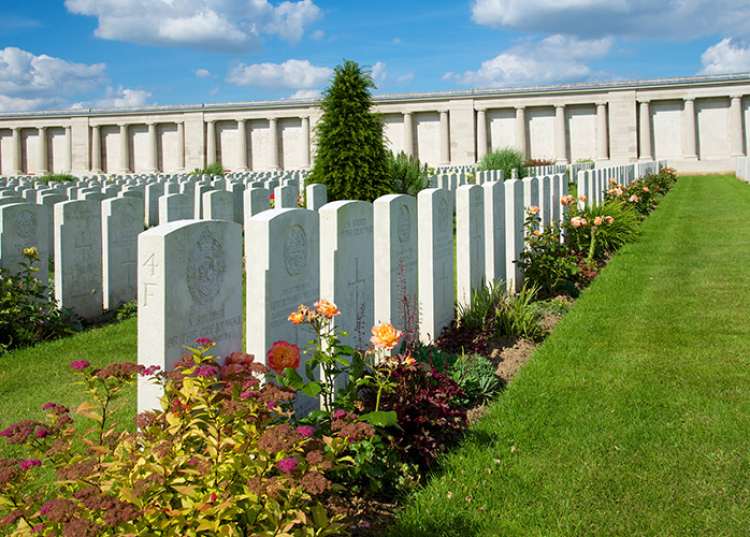
3. Pozieres
Pozieres was the site of a major battle between Allied and German forces in 1916. The clash was the first of numerous battles together known as The Battle of the Somme.
Today, visitors can follow the battle with signs and information panels and view the site of the Battle of Pozieres, including its Tank Memorial and the remnants of the Gibraltar blockhouse which was a German observation tower. There is also a cemetery and several obelisk shaped memorials. Poziers is one of the sites that make up the Circuit of Remembrance, a route along which visitors can explore the Battlle of the Somme.
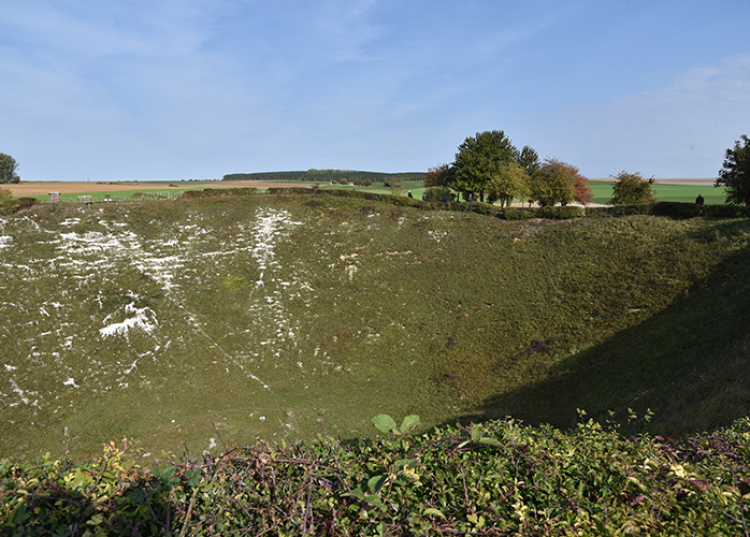
4. Lochnagar Crater
The Lochnagar Crater located in the village of La Boisselle in France’s Picardie region, is the site where one of the first and largest explosions of the Battle of the Somme took place on 1 July 1916.
Set off by British forces at 7:28am, the mine which created the Lochnagar Crater was one of the biggest ever detonated at that time and the crater itself is an astounding 100 metres in diameter and 30 metres deep. Today, visitors can see Lochnagar Crater, either as a one off site or as part of the Circuit of Remembrance, a route which explores the Battle of the Somme, one of the biggest battles in World War One.
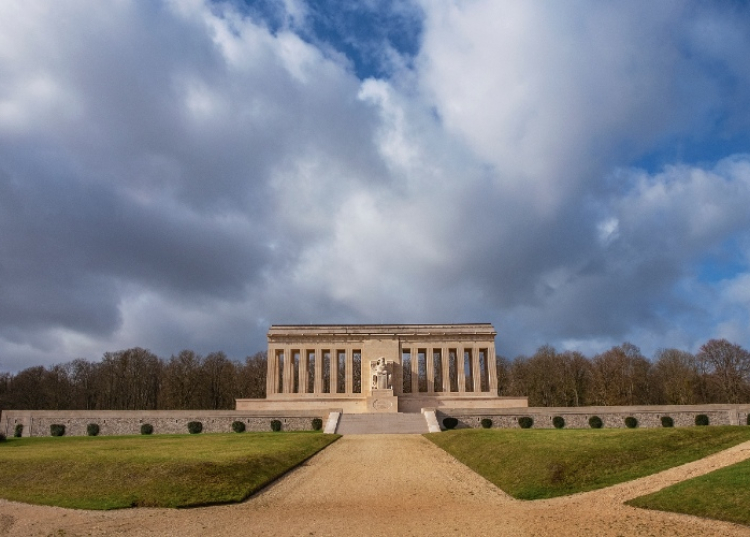
5. Chateau-Thierry American Monument
The Chateau-Thierry American Monument commemorates those American soldiers who fought in the region during World War I, such as those who took part in the Second Battle of the Marne.
Overlooking the River Marne, the granite structure of the Chateau-Thierry American Monument is a commanding sight with its colonnades and heroic statues. Visitors to the Chateau-Thierry American Monument can learn about the battles which took place in the area using the orientation map on the monument.
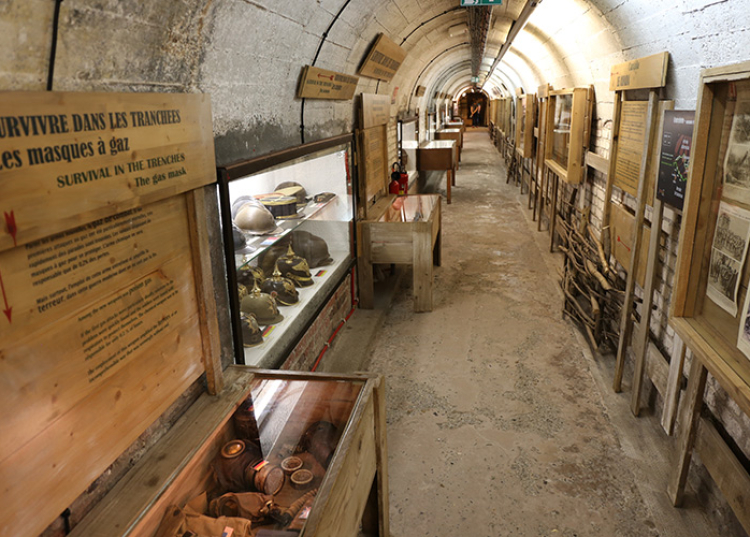
6. The Somme 1916 Museum
The Somme 1916 Museum is part of the Circuit of Remembrance, a tour of the Picardie region of France dedicated to the Battle of the Somme. Based in a former crypt in the town of Albert which later acted as a Second World War underground shelter, the museum displays a series of exhibits relating to the Battle of the Somme, including original weaponry, uniforms and equipment as well as looking at the experiences of the soldiers in the trenches.
The museum uses a variety of methods to try and recreate soldiers’ lives, immersing visitors in the experience with imagery, sound effects and lighting. Guided tours are available in English, French and German as are films in the museum’s projection room.
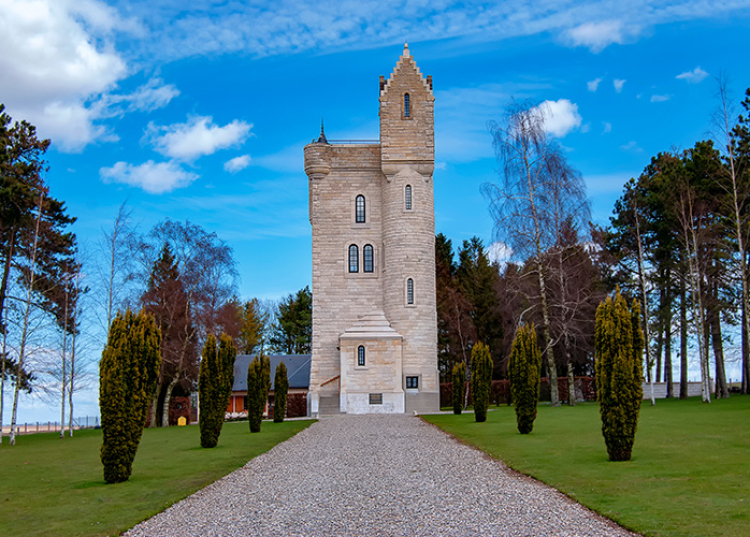
7. Ulster Memorial Tower
The Ulster Memorial Tower in Thiepval in France is a 70-foot high stone structure built as a memorial to the men of Ulster who fought and gave their lives during World War I. The first memorial to be built on the Western Front, the Ulster Memorial is a replica of Helen’s Tower, an important monument which is located in County Down in Northern Ireland.
Located on what was the German front line during the Battle of the Somme, the memorial faces Thiepval Wood, the site from which the 36th (Ulster) Division made its charge on the first day of the famous offensive, 1 July 1916. Today, the site offers guided tours of these woods from its visitor centre. Inside, visitors can view the plaques dedicated to the Irish soldiers, several paintings and visit its memorial chapel.
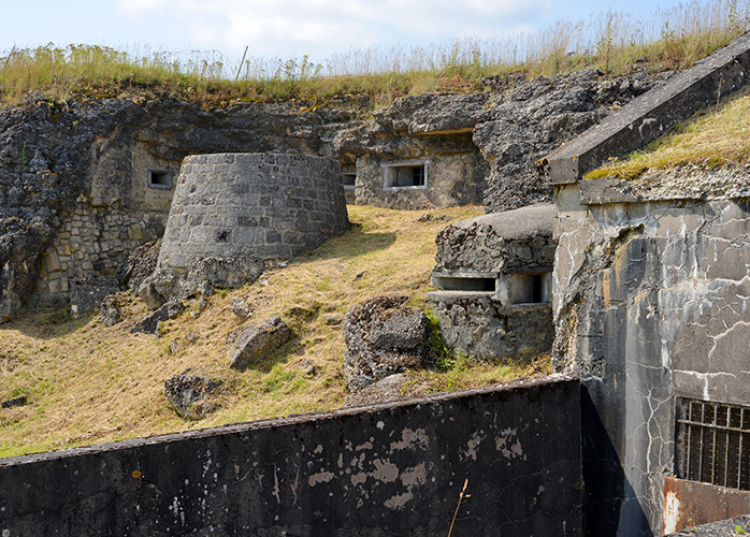
8. Fort Douaumont
Fort Douaumont was one of the strongest, most state of the art forts in France at the time of the First World War. However, in 1916, it was destroyed during the Battle of Verdun and today it lies as one of many ruined First World War Battlefields in France.
Today, visitors can see Fort Douaumont as it was at the end of World War One. You can take a tour through its three levels and see the guns, turrets and weaponry which remain. Despite the destruction, much of Fort Douaumont is well preserved including the barrack rooms and command posts. There is also a graveyard.
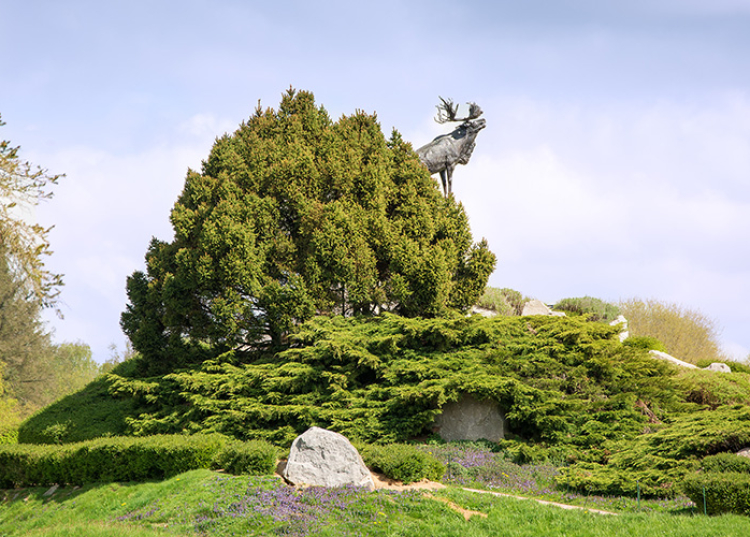
9. Newfoundland Memorial
The Newfoundland Memorial represents the best surviving trench system from WWI and commemorates the efforts of the 1st Battalion of the Canadian Newfoundland Regiment. The trenches at the site of the Newfoundland Memorial are some of the best preserved of their kind and offer visitors an invaluable insight into the conditions of the Great War. As such, it is amongst the best preserved French WW1 battlefields.
The memorial site consists of a number of areas, each of which are signposted, several cemeteries, memorials to the Newfoundland Division and to the Highland Division. The interpretation centre offers visitors can learn more about the origins of the Canadian soldiers and about the Somme.
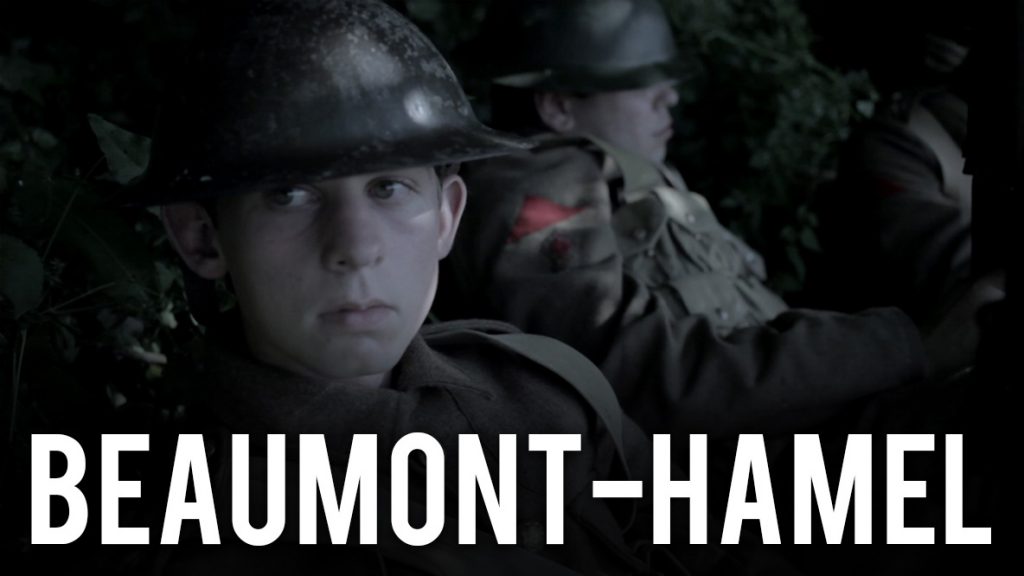
10. Douaumont Ossuary
The Douaumont Ossuary in Verdun is a memorial site to the soldiers who died whilst fighting in the Battle of Verdun during the First World War. The Ossuary houses the bones of approximately 130,000 unknown soldiers from both sides. These remains can been seen through small windows inside the Douaumont Ossuary and the Ossuary’s cloisters are lined with plaques of the names of fallen soldiers and the locations of where each body was recovered. It also has a chapel where ceremonies take place.
Made up of an imposing stone structure with a 46 metre tower and beautifully maintained fields which house a cemetery with the graves of a further 15,000 French soldiers, the Ossuary overlooks the battlefield of the Battle of Verdun. Visitors can climb to the top of its tower for panoramic views of these fields. The first floor of the Ossuary is dedicated to a museum of the First World War.

The Great War in France
Sites and memorials from the first world war 1914-1918.
- Explore France ►
- Where to stay
- Find a hotel
- Climate & weather
- Plan your trip
- France on a budget
- Eating in France
- Camping in France
- Search About-France
- A-Z of French life
- Driving in France
- Motorway services
- Routes from Calais
- Rules of the road
- Driving checklist
- Ferries to France
- Flying to France
- Rail travel in France
- Bus and coach travel
- Other main cities
- Choose a region
- The south of France
- The Dordogne
- The French seaside
- The Loire valley
- The Massif central
- Top attractions
- Best of France
- Heritage cities
- Skiing & wintersports
- Best small towns
- Best of rural France
- Wild France
- Tourist map of France
The Great War remembered

WW1 Military cemeteries in France
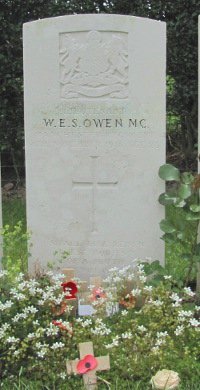
World War 1 battlefields museums and monuments
Staying in northern france.
- Click here for hotels in the Somme area , around the town of Albert
- Click here for hotels in the Meuse area , including Verdun
- Click here for b&b's in north east France
Battlefield Tours

- Hotels in the Somme area , around the town of Albert
- Hotels in the Meuse area , including Verdun
- Hotels in and near Arras
- Hotels in and near Reims
- Hotels in and near Ypres (Belgium)

- Byroads through France
- Small towns in France
- Beautiful French villages
What to Do in Lille in Northern France
Check out World War I memorials and battlefields
:max_bytes(150000):strip_icc():format(webp)/james-globe-56a3a1c05f9b58b7d0d2e4e5.jpg)
Dan Kitwood/Staff/Getty Images
Lille , France, is located in the north of France, on the Deûle River, near the border with Belgium . Lille is one hour from Paris and 80 minutes from London by the high-speed TGV train. In France, Lille is in the Nord-Pas de Calais region .
How to Get There
The Lille-Lesquin Airport is located about 5 miles from the center of Lille . An airport shuttle (from door A) gets you into the center of Lille in 20 minutes.
France has an in-depth rail system , and Lille has two train stations located 400 meters apart. The Lille Flandres station offers TER regional trains and direct TGV service to Paris , while the Lille Europe station has Eurostar service to London and Brussels , TGV service to Roissy Airport, Paris, and major French cities.
Visiting World War I Battlefields Around Lille
Lille, as the first stop on the French side of the channel tunnel, is a good place to visit if your main interest in the region is the World War I battlefields. However, there are other places you might want to consider. Arras, an hour from Lille but with no direct trains, is actually a little closer to many of the battlefields, while Bruges in Belgium also has WWI battlefield tours . You can also check out a two-day battlefield tour from Paris.
These are some of the main battlefields close to Lille:
- Somme: This was the biggest battle of the western front where one million people were killed or injured. It's around an hour's drive from Lille. You can remember those who lost their lives on this Somme Battlefield Tour .
- Fromelles: This site saw the bloodiest battle in the history of warfare involving Australian troops. You can learn more about what happened on this Battlefield Tour of Fromelles and Flanders.
- Vimy Ridge: This battlefield was a victory for largely Canadian troops. You can learn more on this Vimy Battlefield Tour from Lille .
- Ypres: One of the most famous battlefields, it was called "Wipers" by troops at the time. There is no tour from Lille, but there is from nearby Arras through the Ypres Tour from Arras.
About the Battle of Fromelles
The Battle of Fromelles, close to Lille, was the first important battle on the western front involving Australian troops. It is also considered to be the bloodiest 24 hours in Australian military history. In the night of July 19, 1916, 5,533 Australians and 1,547 English soldiers were killed, injured, or left missing. You can visit the memorial to Australians. The German losses were estimated at less than 1,600 people.
For many, this battle was as tragic as it was useless. It was simply a diversion for the great offensive battle in the Somme that was raging about 50 miles to the south. The battle provided neither a strategic advantage nor lasting benefit.
More Things to Do in the Area
Lille is known for its narrow, cobbled streets with Flemish houses, lively cafes, and elegant restaurants. It was designated as the "European City of Culture" for 2004.
You'll want to see Lille's Gothic Cathedral , the collection of 15th- through 20th-century paintings at the Musée des Beaux-Arts de Lyon , which art folks have designated the second most important art museum after the Louvre in Paris, and Place du Général de Gaulle, also known as the Grand Palace.
To get a different perspective on Lille, climb the stairs of the belfry and see it from above. You could also cruise through the streets of Lille in style in a vintage 2CV convertible.
For a great example of the Flemish baroque by architect Julien Destrée, see the Old Stock Exchange ( Vieille Bourse ) .
The Hospice Comtesse Museum was founded as a hospital in 1237 by the Countess of Flanders, Jeanne de Flandre and remained as a hospital until 1939. Get a glimpse of where Augustine nuns provided a haven for the sick, see some art, then go outside and visit the medicinal garden.
On the west side of Lille is Citadelle de Lille , Lille's fortress, built around 1668 by Vauban and was part of the city's fortifications, most of which were dismantled towards the end of the 19th century. The Bois de Boulogne surrounds the Citadelle and is popular with walkers and folks with children. There is a well-run zoo ( Parc Zoologique ) nearby.
Shoppers will want to stop over at the Center Commercial Euralille or Euralille Shopping Center located between the two train stations. There are 120 shops, restaurants, and cafes that will vie for your money in this Rem Koolhaas 1994 classic.
Note that many museums in Lille are closed on Monday and Tuesday.
For an interesting day trip from Lille, take the train to the nearby town of Lens , where you can see the new extension of the Louvre, called the Louvre-Lens.
Public Transportation
Lille has two metro lines, two tram lines, and about 60 bus lines. For the tourist, obtaining a Lille City Pass might be the best answer to transportation needs, as it provides entry to 28 tourist sites and attractions as well as free use of the public transportation system. You can get the pass at the tourist office.
Office of Tourism
The Lille Tourist Office is located in the Palais Rihour at Place Rihour. There are many tours you can sign up for in the tourism office, including a remembrance tour, a city tour, a bike tour, and a guided walking tour of Old Lille. You can also reserve to climb the Town Hall Belfry for a view of Lille and sign up for Segway tours.
Christmas Market
Lille was the first city in France to offer a Christmas market. The market runs from about mid-November to the end of December, and shops are even open on the three Sundays before Christmas. The Lille Christmas market is located on Rihour square.
Weather and Climate
Lille offers a very pleasant climate in the summer, although you can expect a little rain, which intensifies in the fall. June through August daily highs are in the low 20s (Centigrade), which is around 70°F.
Lille Guide: Planning Your Trip
The Nord-Pas-de-Calais Region: North France
A Tour of World War I Memorials in France
France Border Travel From the North to Spain
North Coast of France: The Ultimate Road Trip From Dieppe to Calais
Top 20 Most Popular French Cities for International Visitors
12 Top Things to Do in Lille, North France
What to See and Do in Lens, France
Albi: Planning Your Trip
5 Best Places to Visit in the 10th Arrondissement of Paris
Top 15 Monuments and Historic Sites in Paris
France Travel Planner for Every Vacation
Guide to Arras in Northern France
Travel Guide to Bruges, Belgium
One Week in France: The Ultimate Itinerary
The Louvre-Lens Museum in North France

Belgium WW1 battlefields, memorials, and more
November 17, 2021 | Posted in: Belgium
2014-2018 marked four years of commemorating the end of the Great War, World War I, now more than 100 years ago. There was an influx of people from around the world visiting the Belgium WW1 battlefields, memorials, museums, and cemeteries. If you weren't one of them but would still like to come and remember, here's a list of sites you can find around and related to the battlefields in Belgium.
1. In Flanders Fields Museum
2. west front nieuwpoort, 4. lange max museum, 5. hooge crater museum, 6. museum aan de ijzer, 7. the pondfarm, 8. talbot house, 9. memorial museum passchendaele 1917, 10. museum of 18 days, 11. memorial museum for the regiment, 12. fort boncelles museum, 13. blockhaus pionnier 14-18, 14. mons memorial museum, 15. museum of the battle of the borders in the gaume – museum baillet-latour, 1. lijssenthoek military cemetery, 2. buttes new british cemetery, 3. flanders field american cemetery, 4. german military cemetery langemark, 5. belgian military cemetery de panne, 6. belgian military cemetery houthulst, 7. essex farm cemetery, 8. saint-charles de potyze, 9. aeroplane cemetery, 10. zeebrugge churchyard, 11. german military cemetery hooglede, 12. bedford house cemetery, 13. belgian military cemetery oeren, 14. belgian military cemetery steenkerke, 15. hooge crater cemetery, 16. belgian military cemetery vleteren, 17. belgian military cemetery hoogstade, 18. ossuaire francais, 19. kemmel chateau military cemetery, 20. belgian military cemetery bruges, 21. harelbeke new british cemetery, 22. poelcapelle british cemetery, 23. belgian military cemetery keiem, 24. cement house cemetery, 25. divisional collection post cemetery and extension, 26. new irish farm cemetery, 27. dozinghem military cemetery, 28. french military cemetery machelen-aan-de-leie, 29. kezelberg military cemetery, 30. french soldier ereperk veurne, 31. french soldier ereperk roeselare, 32. dadizeele new british cemetery, 33. ingoyghem military cemetery, 34. duhallow ads commonwealth war graves commission cemetery, 35. potijze chateau grounds cemetery, 36. potijze chateau wood cemetery, 37. tuileries british cemetery, 38. german military cemetery vladslo, 39. zuidschote churchyard, 40. coxyde military cemetery, 41. belgian military cemetery ramskapelle, 42. ploegsteert wood military cemetery, 43. cemetery of heuleu, 44. saint-symphorien military cemetery, 45. locre no. 10 cemetery, 46. toronto avenue cemetery, 47. dranoutre military cemetery, 48. adinkerke churchyard extension, 49. la clytte military cemetery, 50. klein-vierstraat british cemetery, 51. godezonne farm cemetery, 52. kemmel no. 1 french cemetery, 53. irish house cemetery, 54. kemmel churchyard, 55. lindenhoek chalet military cemetery, 56. suffolk cemetery, vierstraat, 57. loker churchyard, 58. la laiterie military cemetery, 59. locre hospice cemetery, 60. kandahar farm cemetery, 61. westhof farm cemetery, 62. westoutre british cemetery, 63. westoutre churchyard and extension, 64. cabin hill cemetery, 65. croonaert chapel cemetery, 66. derry house cemetery no. 2, 67. lone tree cemetery, 68. oosttaverne wood cemetery, 69. r.e. farm cemetery, 70. somer farm cemetery, 71. packhorse farm shrine cemetery, 72. torreken farm cemetery no. 1, 73. artillery wood cemetery, 74. bard cottage cemetery, 75. saint quentin cabaret military cemetery, 76. pond farm cemetery, 77. colne valley cemetery, 78. wulverghem-lindenhoek road military cemetery, 79. ration farm (la plus douve) annexe, 80. welsh cemetery (caesar’s nose), 81. dragoon camp cemetery, 82. la belle alliance cemetery, 83. no man’s cot cemetery, 84. talana farm cemetery, 85. dickebusch new military cemetery extension, 86. dickebusch old military cemetery, 87. wijtschaete military cemetery, 88. dickebusch new military cemetery, 89. the huts cemetery, 90. bleuet farm cemetery, 91. solferino farm cemetery, 92. spanbroekmolen british cemetery, 93. canada farm cemetery, 94. ferme-olivier cemetery, 95. hagle dump cemetery, 96. hospital farm cemetery, 97. belgian battery corner cemetery, 98. menin road south military cemetery, 99. potijze chateau lawn cemetery, 100. ramparts cemetery, lille gate, 101. ypres reservoir cemetery, 102. ypres town cemetery extension, 103. buffs road cemetery, 104. la brique military cemetery no. 1, 105. la brique military cemetery no. 2, 106. minty farm cemetery, 107. oxford road cemetery, 108. track x cemetery, 109. white house cemetery, st. jean-les-ypres, 110. wieltje farm cemetery, 111. brandhoek new military cemetery no. 3, 112. brandhoek military cemetery, 113. brandhoek new military cemetery, 114. divisional cemetery, 115. hop store cemetery, 116. railway chateau cemetery, 117. red farm military cemetery, 118. vlamertinghe new military cemetery, 119. vlamertinghe military cemetery, 120. bus house cemetery, 121. elzenwalle brasserie cemetery, 122. oak dump cemetery, 123. ridge wood military cemetery, 124. voormezeele enclosure no.3, 125. voormezeele enclosures no.1 and no.2, 126. birr cross roads cemetery, 127. blauwepoort farm cemetery, 128. chester farm cemetery, 129. spoilbank cemetery, 130. first dcli cemetery the bluff, 131. hedge row trench cemetery, 132. larch wood (railway cutting) cemetery, 133. maple copse cemetery, 134. perth cemetery (china wall), 135. zillebeke churchyard, 136. berks cemetery extension, 137. calvaire (essex) military cemetery, 138. gunners farm military cemetery, 139. hyde park corner (royal berks) cemetery, 140. la plus douvre farm cemetery, 141. lancashire cottage cemetery, 142. london rifle brigade cemetery, 143. motor car corner cemetery, 144. strand military cemetery, 145. tancrez farm cemetery, 146. toronto avenue cemetery, 147. mud corner cemetery, 148. prowse point military cemetery, 149. underhill farm cemetery, 150. le touquet railway crossing cemetery, 151. ruisseau farm cemetery, 152. bridge house cemetery, 153. dochy farm new british cemetery, 154. gwalia cemetery, 155. haringhe (bandaghem) military cemetery, 156. seaforth cemetery, cheddar villa, 157. poperinghe old military cemetery, 158. grootebeek british cemetery, 159. poperinghe new military cemetery, 160. poperinghe communal cemetery, 161. st julien dressing station cemetery, 162. mendinghem military cemetery, 163. nine elms british cemetery, 164. reninghelst new military cemetery, 165. bethleem farm west cemetery, 166. abeele aerodrome military cemetery, 167. bethleem farm east cemetery, 168. messines ridge british cemetery, 169. ramscappelle road military cemetery, 170. nieuwpoort communal cemetery, 171. watou churchyard, 172. passchendale new british cemetery, 173. tyne cot cemetery visitors centre, 174. zandvoorde british cemetery, 175. zandvoorde churchyard, 176. polygon wood cemetery, 177. ploegsteert memorial, 178. wwi francis ledwidge memorial to the missing, 1. fort st. heribert, 2. fort de lantin, 3. fort de boncelles, 4. fort de loncin (fsfl), 5. fort de barchon, 6. fort flémalle, 7. fort de boncelles, 8. fort d'émines, 1. saint michael’s church, 2. st. vedast church, 3. the khaki chums cross, 4. st julien canadian war memorial, 5. ‘vierfrontenbrug’ bridge of four battles, 6. menin gate, 7. front line hooghe, 8. nieuwpoort memorial, 9. yorkshire trench and dug out, 10. railway line 74, 11. monument for king albert i, 12. statue 7de linieregiment, 13. guynemer pavilion, 14. memorial 14th line regiment, 15. hill 60, 16. ypres salient, 17. mine crater sint-elooi, 18. island of ireland peace park, 19. death cells & execution room poperinge, 20. interallied memorial, 21. bayernwald german trenches, 22. lettenberg bunkers, 23. 36th & 16th div memorial stones, 24. passchendaele dodengang or trenches, 25. pool of peace, 26. st george's memorial church, ypres, 27. hof ter molen, 28. coming world remember me, 29. german command post, zandvoorde, world war 1 battlefield tours, where to stay, how to get to the battlefields, belgium wwi museums.
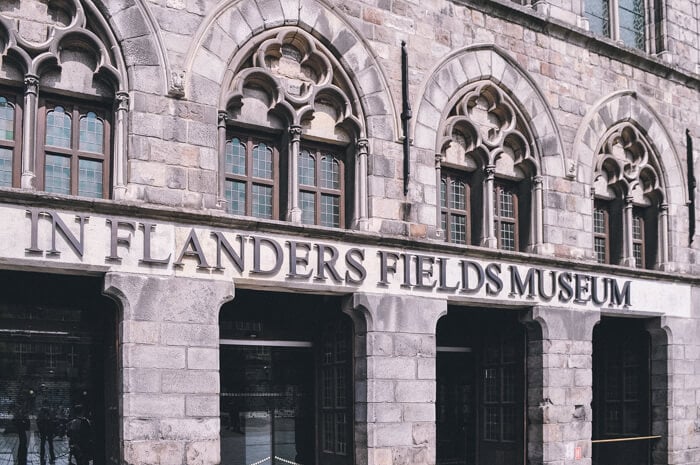
During World War One, the flooding of the IJzer Plains was orchestrated at Nieuwpoort’s sluice complex, stopping the relentless march of the German army. In the modern visitor center, you can enjoy amazing views of the WWI Belgian battle site areas and computer simulations where you can see how the system of sluices operates. While you’re there, be sure to pay a visit to the monument for King Albert I and the fallen Belgian soldiers as well.
The Hill 62 Canadian Memorial, also known as Sanctuary Wood, is about 30 kilometers north of Lille. It commemorates the defense of Ypres by Canadian troops in 1916, during the First World War. Over 8,000 Canadian soldiers gave their lives during five months of fighting in order to keep the German forces from occupying what little of Belgium was still controlled by the Allies.
A visit to the Lange Max Museum is a wonderful way to get a better understanding of the German side of the Western Front. Situated about 3 kilometers north of Koekelare, this museum is on the site of one of the largest artillery pieces of the First World War, the “Long Max”. There are many interesting and educational displays, as well as audio programs to listen to. Up to date and visually pleasing, this museum has a wealth of information to share.
In the summer of 1915, the exposed British forces around Hooge were easy targets for the Germans. To counter their attacks, the British tunneled toward the Germans and placed a 1700 kilogram charge of explosives in the tunnel. The explosion resulted in the Hooge Crater. Hooge Crater Museum is a private museum dedicated to this amazing piece of history. Located in a chapel commemorating fallen soldiers from World War One, the war museum is home to a number of historic collections from the era, including weapons, photos and a variety of military equipment that was used in Belgium in World War 1.
On the Yser River in Diksmuide, the Museum Aan de Ijzer is a place where Peace, Freedom, and Tolerance are emphasized. The museum holds a collection of artifacts, personal stories, films and other displays following the timeline of the First World War, primarily with a Flemish focus. Your tour begins on top of the 22-story structure and features an amazing view of the surrounding land.
During World War 1, the Pondfarm was a place of upheaval and turmoil. In November 1914, residents were told to evacuate the area immediately as the German army advanced into the area. Residents desperately wanted to return to their homes but were prevented from doing so for a long time due to the Pondfarm repeatedly changing hands during the War. The daunting post-war task of rebuilding is a truly inspiring story. Today you can visit the small farmhouse museum where many relics of the War are kept and learn even more about the history of the Pondfarm.
The Talbot House was the respite for every soldier passing through Poperinge. It was located in unoccupied Belgium – removed from the actual fighting. British Army chaplains Talbot and Clayton decided that the soldiers coming through the area needed the Talbot House to be a place where they could enjoy rest and relax during their downtime. Today a tour of the facility begins in the old barn, which was converted into a concert hall. You’ll enjoy a full-immersion experience that provides a taste of what day to day life was like in this camp setting during the Great War.
The World War One Battle of Passchendaele is memorialized in this museum. It pays tribute to the 500,000 men killed over the course of 100 days. Located in the historic Zonnebeke Castle, this museum is broken down into 5 parts. Each part focuses on a different aspect of the War and its effects on the region and its people. It ends in the Hall of Reflection, where the many victims of the fighting are remembered. Enjoy the many featured displays where you can re-live many actual war-like experiences.
Through vignettes featuring period uniforms and equipment, numerous documents, and other displays, the Museum of 18 Days looks at the effects of the Great War at the local and regional level. The thousands of artifacts tell the stories of the people of the area during World War One and how their lives were forever altered by the politics and military actions of the time.
Created in 1830, the Memorial Museum for the Regiment covers all aspects of a remarkable Regiment. The museum features actual military equipment, weapons, and uniforms from the various eras and you will get a real education regarding one unit’s contribution to the history of the region. The Memorial Museum for the Regiment is located on an active military installation. Therefore, the museum is open by appointment only, and groups are limited in size.
The Fort Boncelles Museum is located approximately 8 kilometers south of Liege. It features an amazing collection of historic artifacts from both World War I and II. You’ll see artillery field pieces, aircraft, sidearms, and even a scale model of the fortifications. The fort is one of twelve constructed in the late 1800s and played a key role in the defense of Belgium during several conflicts.
Located in Comines-Warneton, Blockhaus Pionnier 14-18 is one of the smaller museums in Belgium and consists of only three rooms. Its true importance is in how it depicts the everyday lives of the German soldier who were stationed in this blockhouse. You will gain a greater understanding of what life was like here from 1914 to 1918 as you look through this unique collection of historic items.
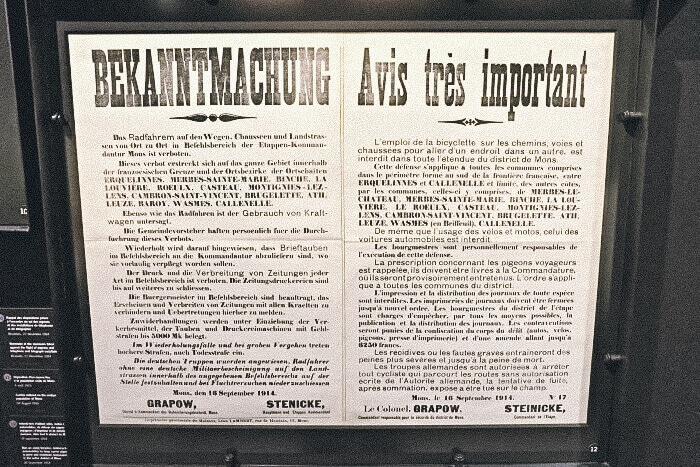
One of the most pivotal parts of the First World War was the Battle of the Borders. During this fighting France attempted to drive into Germany, while the Germans invaded Belgium and Luxembourg in order to strike the French along their northern border in an effort to take Paris. Tens of thousands of soldiers lost their lives during this campaign and the Museum of the Battle of the Borders in the Gaume, with its collection documents and personal items, is dedicated to their memory.
World War I Cemeteries in Belgium
This is a Commonwealth War Graves Commission burial ground. It contains the remains of almost 11,000 Commonwealth soldiers who died during the Great War. It is the second-largest WW1 cemetery for Commonwealth soldiers in Belgium.
This Commonwealth cemetery located near Zonnebeke is the final resting place for 2,108 soldiers from World War One, 80% of whom are unknown. It is actually two WW1 cemeteries that have been joined.
This is the only American military WW1 graveyard in Belgium. It holds the remains of 370 soldiers who died in the First World War.
One of only 4 German military cemeteries in Belgium, it honors more than 44,300 German soldiers who died in combat during the First World War. Only about 17,000 of them could be identified and their names have been made a permanent part of the cemetery.
This is the largest Belgian military cemetery in West Flanders and is the final resting place of over 3300 Belgian soldiers. Soldiers who died in the nearby military hospital were interred here. Almost half gave their lives in the Final Offensive in 1918.
Many of the graves in this cemetery came from field graves and smaller cemeteries in the area. There are 1723 Belgian graves and 81 Italian graves of those who were German POWs. The graves are arranged in a six-pointed star pattern.

Although this French cemetery is the largest on Belgian soil, it started out as a simple garden adjacent to a school which the French used as a military hospital. Today it commemorates 4200 French soldiers who died in the Great War.
The unusual name for this cemetery comes from the wrecked aircraft which crashed into it during combat. There are 1105 Commonwealth servicemen commemorated here with 636 of them unidentified.
The port town of Zeebrugge is home to a Commonwealth cemetery which is the final resting place of 185 British and German soldiers from the First World War. A total of 20 of those are unidentified.
This is one of only four cemeteries in Belgium honoring the German dead from World War One. Following the consolidation of German graves from around the area, the cemetery now holds the remains of 8,241 soldiers. It features a Hall of Honor constructed out of stones from the German Pavilion from the 1928 World’s Fair.
This Commonwealth cemetery located just outside of Ypres on the grounds of the castle Rosendael which was used as a medical facility by the British. Small cemeteries were created in the gardens of the castle which now hold the remains of 5,144 Commonwealth soldiers.
One of the smaller Belgian cemeteries, this one commemorates 508 Belgian soldiers who died in the Great War. Although a number of the graves were marked with Flemish “fallen hero” crosses, only a handful remain intact.
During the First World War, Steenkerke was the site of a medical infirmary to treat wounded soldiers. Over 500 Belgian soldiers are buried here. Well-known Flemish soldier Joe English was the first fatality interred here, although his remains were later transferred to another location.
The cemetery was originally begun in 1917 at the beginning of the Third Battle of Ypres. It was small but eventually took in graves from other battle sites in the area. Currently, the cemetery has approximately 5800 graves.
One of nine Belgian military cemeteries in West Flanders, it was taken over from the French in 1916 after relocating the French graves. Today it is the final resting place of 1207 Belgian soldiers killed in the First World War.
Belgian soldiers who were wounded and died at the nearby military field hospital were buried in this cemetery. It is the final home to 825 Belgian soldiers from the First World War, 35 of whom are unknown. There are also 20 British soldiers interred here.
This cemetery honors those French soldiers who gave their lives during World War Two. The cemetery is comprised of a total of four mass graves containing 5,294 fallen soldiers, only 57 of whom were ever identified.
This Commonwealth cemetery was created in 1914, then, despite fighting from the French and Commonwealth forces, lost to the Germans in 1918. Later that year it was retaken, although it was badly damaged during those months. There are 1135 Commonwealth burials from the UK, Canada, Australia, and New Zealand.
Located in the Bruges district of Assebroek, this Belgian cemetery has 611 graves. Most of those killed were part of the Liberation Offensive in October of 1918.
This cemetery commemorates those Commonwealth soldiers who fell on the battlefield during the Final Offensive of World War One, in 1918. The remains of soldiers who died in other combat were transferred to this cemetery, which now holds 1116 graves.
The third largest Commonwealth cemetery in the Westhoek, it was created in 1919. Approximately 7500 Commonwealth soldiers are buried here, mostly as a result of major conflicts in the Autumn of 1917.
Containing the graves of 590 Belgian soldiers, many of whom were killed in the fight for Keiem, this cemetery was not created until after the Great War was over. Roughly 60% of those interred here are unknown.
During the fighting in World War One the British designated a nearby farmhouse as “cement house” and the name remained. For a long time, this cemetery was one of the few which was still accepting Commonwealth remains. Any Commonwealth victims that were discovered, especially in recent years as construction has occurred in the area, are interred here.
The need for this cemetery arose due to the carnage following the Third Battle of Ypres 1917. Originally holding only 87 graves, the extension brought 678 more graves from surrounding smaller cemeteries and battlefields.
This cemetery is located at what was, at one time, the front line of World War One. In the beginning, it had only about 73 graves, but following a program of consolidation of smaller cemeteries, the number expanded to 4500. 70% of the people interred are unidentified.
Anticipating the Third Battle of Ypres in 1917 several field hospitals were established in the area. Dozinghem was one of them and it soon became the location of a cemetery to deal with who were mortally wounded. There are 3,174 Commonwealth burials in the cemetery as well as 65 German graves.
This French cemetery is the final resting place for 750 soldiers from the First World War. The deaths occurred during the Liberation Offensive of 1918.
The Moorsele area around this cemetery was retaken by the 15th Royal Irish Rifles in October of 1918 after being held by German forces for much of the war. The cemetery holds the remains of 147 Commonwealth soldiers as well as 14 Germans.
In addition to the approximately 80 French soldiers who share a mass grave at this cemetery, there are about 150 individual graves honoring the French soldiers who fell here during the Great War.
This cemetery holds the graves of Commonwealth, French, and Belgian servicemen from World War One. There are a total of 93 wartime casualties buried on this site.
This Commonwealth cemetery is the final resting place for 1028 soldiers from the First World War. Of those, 158 remain unknown.
Originally constructed by the Germans following the battles which took place in 1918, this cemetery contains 88 Commonwealth graves as well as 54 German graves. It was declared a protected monument.
Duhallow was originally a medical post. The cemetery was created in 1917, following the Battle of Pilckem Ridge. There are 1544 Commonwealth graves from World War One at this site. 231 of those are listed as unknown.
Over 200 casualties from the First World War are located here. Almost 30 of them are still unidentified. Although the area was behind British lines for almost the entirety of the War, it was still within range of German guns and the original chateau which housed the medical aid station is in ruins.
One of three Potijze Chateau cemeteries, including Chateau Grounds and Chateau Lawn, Chateau Wood contains 151 Commonwealth graves from the Great War.
During World War One the frontline trenches ran right through the community of Zillebeke where the “Tuileries” or Tile Works were located. In 1915 a number of Commonwealth and French soldiers were buried there. Unfortunately, during a heavy enemy shelling, many graves were destroyed. The cemetery contains 95 burials, although only 26 of them are known and marked. There is a special memorial on site commemorating those whose graves were destroyed.
At the end of World War Two, the decision was made to consolidate the German war graves from World War One into four major cemeteries. As a result of this merging, the German cemetery at Vladslo now contains the remains of 25,644 soldiers.
Although most of the burials on this site are Commonwealth soldiers from the Second World War, there are also five unidentified French burials from the First World War.
This cemetery was started by the French at the beginning of the First World War. It became one of the primary Commonwealth cemeteries along the Belgian coast. There are now 1507 Commonwealth soldiers interred at this site, the French remains having been returned to their homeland for full military burials.
This military cemetery was created at the end of the First World War and is the result of the merging of small local field graves and municipal cemeteries. This site contains the graves of 635 Belgians, most of whom were killed during the Battle of IJzer in 1914.
This cemetery was created by enclosing a number of smaller, regimental cemeteries and combining it into one all-encompassing facility. It contains the remains of 164 World War One soldiers.
The French cemetery of Heuleu is the final resting place of over 200 soldiers who were killed during the defense of Entre-Sambre-et-Meuse in August of 1914.
This World War One military cemetery is unique for several reasons. It is located on land which was donated by a private owner Belgian naturalist Jean Houzeau de Lahaie, and it is a multinational facility. Soldiers from the Commonwealth and Germany are interred in one place as a way to unite both sides of the conflict.
This is one of a number of cemeteries created by the French in 1918, but all 248 French graves were relocated to another cemetery. There are now 58 Commonwealth burials on the site, with 14 of them unidentified.
Not a large cemetery, but it holds the remains of 78 soldiers of the First World War. They were officers and enlisted men of the 9th Brigade of the 3rd Australian Division. They were killed during the Battle of Messines in June of 1917. Two of those buried remain unidentified.
The local churchyard was used for the burial of Commonwealth soldiers until 1915 when the military cemetery was created. It now holds 458 Commonwealth graves as well as a lone German grave.
Located on the west side of the churchyard, the cemetery holds 67 Commonwealth graves of those fallen during the First World War.
Begun in November of 1914 there are now 1,082 casualties of the Great War buried here. Of those buried, 238 of them are unidentified.
Due in part to the serious combat which took place in and around the village of Kemmel in April of 1918, there are 805 Commonwealth war graves in this cemetery, 109 0f them unidentified.
The history of this cemetery begins in the garden of the Godezonne Farm in 1915. After the Armistice graves were consolidated on this site from a large area north and east of the village of Kemmel. There are now 79 burial sites in this cemetery, 44 of them have never been identified.
The origin of this cemetery is unknown, but it contained Commonwealth, French and German casualties. The French graves have since been removed to other locations and there remain only 296 Commonwealth graves, mostly unknown, and 94 German graves, also mostly unknown.
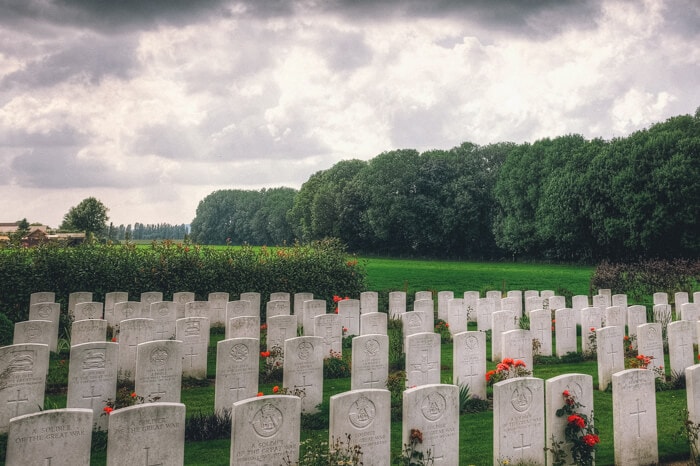
Near the front lines of World War One, Kemmel itself was held by the Germans for a while. The Churchyard cemetery contains 25 Commonwealth burial sites. There is a special memorial to those soldiers whose graves were destroyed by enemy shelling.
The cemetery was begun in 1915 and was actively used by field ambulances and combat units until 1917. Following the Armistice, over 100 graves were added to the cemetery from battlefields in the surrounding area. There are now 315 internments, 67 of those unidentified.
At one time referred to as Cheapside Cemetery, it now contains 47 burial sites of Commonwealth soldiers. Many of those soldiers were killed in April of 1918, during an attempted German advance.
During the spring of 1918, the town of Loker changed hands several times amid fierce fighting. The churchyard was used by both fighting units and by field ambulances during the fighting. It now contains 215 Commonwealth burials.
Created in 1914 and used until October of 1918, this cemetery was used as a place to consolidate graves from many battlefields to the north and northeast of Kemmel. Because of this consolidation, there are now 751 Commonwealth graves here. There is a special memorial on site which commemorates two soldiers whose original graves were destroyed during combat.
Although the area changed hands several times during fighting, this World War One cemetery survived largely intact. There was some restoration of the garden area and there are now 244 Commonwealth graves on the site. There are 12 burials which are unidentified.
Located near the village of Wulverghem, this Commonwealth cemetery was lost to German forces for 5 months in 1918, but the village was retaken, along with the cemetery in September of that year. There are a total of 443 Commonwealth soldiers buried here.
This farm was headquarters for the New Zealand Division in 1917 when the cemetery was begun. It was used by combat units as well as field ambulances until April of 1918. There are 131 Commonwealth graves on this site as well as 5 German graves.
Westoutre remained in Allied hands from the beginning of the First World War until the Armistice, even though at times it was within 2.5 km of the front lines. Although some French and German soldiers were temporarily interred here, they were later removed to other locations. Today the cemetery is the final resting place for 175 Commonwealth soldiers.
This Churchyard and extension were used by fighting units and field ambulances from 1914 to 1918. There are 98 Commonwealth soldiers and 3 German soldiers interred here.
The town of Wijtschaete is home to Cabin Hill Cemetery, begun in 1917 after the area had changed hands several times. The 11th Division created it as a front-line cemetery until March of 1918. It now contains the remains of 67 Commonwealth soldiers from the First World War.
The Croonaert Chapel, in “No-Man's-Land” prior to the Battle of Messines, was created during the First World War by the 19th Division in 1917. There were originally 15 German graves on this site, but they were relocated after the Armistice. Currently, there are 75 Commonwealth soldiers buried in this cemetery.
Derry House Cemetery, so named by the soldiers of the Royal Irish Rifles, was created in June of 1917. It was used as a front line cemetery by the 2nd London Scottish. In addition to 166 Commonwealth war dead, the cemetery also contains the remnants of a concrete command post built in 1917.
The Battle of Messines occurred in June of 1917 and it necessitated the creation of this cemetery. It contains the bodies of 88 soldiers who fell on the first day of that Battle.
Created during the Battle of Messines in 1917, this cemetery became a concentration point for graves in outlying battlefield areas. It now contains 1,119 Commonwealth burials.
A merger of two separate cemeteries, the R.E.Farm cemetery was begun in 1914. It now contains 179 Commonwealth burials with 11 of them unknown.
Begun in June of 1917 this Commonwealth cemetery was in use until October of 1918. It is the final resting place of 91 soldiers from the Great War.
Packhorse Farm Shrine Cemetery was one of two such cemeteries begun by the 46th North Midland Division in 1915. It contains 59 First World War burials.
The town of Wijtschaete was taken and retaken by Commonwealth forces several times during the First World War. This cemetery was created by the 5th Dorset Regiment in June of 1917. It contains 90 Commonwealth burials as well as 14 German war graves.
When the Battle of Pilckem Ridge ended in 1917, the Guards Division created this cemetery. It continued as a front-line cemetery until 1918. Following the Armistice, a large number of graves were moved to this site from battlefields around the area. Currently, there are 1,307 burials at this site with 506 still unidentified.
During the First World War, the Bard Cottage was just across the Yser Canal from the front lines, and the cemetery was started close by, under a high bank. Following the Armistice, graves from Marengo Farm Cemetery and other areas. The total of Commonwealth burials now stands at 1,639.
Begun in February of 1915 by the 46th Division, this cemetery lies adjacent to the St. Quentin Cabaret. The cabaret was used as battalion headquarters until it was captured by Germans in 1918. The cemetery contains 460 Commonwealth burials.
Pond Farm Cemetery was begun in 1916 by the 3rd Rifle Brigade and was used by both combat units as well as field ambulances. Two hundred ninety-six Commonwealth soldiers are buried at this site along with 5 German graves.
This cemetery was begun in July and August of 1915 by the West Riding Regiment, 49th Division. It remained in use until February 1916. It contains 47 World War One burials, 30 of those belonging to officers and men of the West Riding Regiment.
Soldiers of the 5th Division began this cemetery in 1914. Originally designated as the Wulverghem Dressing Station Cemetery, it was used up until October of 1918. Remains from numerous burial sites and battlefields in the area were brought to this location following the Armistice. Today the cemetery holds 1,010 Commonwealth servicemen.
In the Douve river valley, just north of Ploegsteert Wood, this cemetery was begun in January of 1915. It was in use until January of 1918 and contains 202 Commonwealth burials from the First World War.
On the east side of the village of Boesinghe is a spot known as “Caesar’s Nose”. This is where the 38th Welsh Division began this cemetery. It was only in use from July of 1917 until the following November. There are 65 Commonwealth soldiers buried at this location.
Originally known as the Villa Gretchen Cemetery, after a local landmark, this cemetery was begun by the 13th Royal Welch Fusiliers in August of 1917. It contains 66 First World War burials, ten of which are unidentified.
Created in 1916 by the 10th and 11th King’s Royal Rifle Corp, this cemetery took its name from a nearby farmhouse. It is the final resting place for 60 Commonwealth soldiers of the Great War.
From July of 1917 until March of 1918 this cemetery was active. It contains 79 burials of Commonwealth soldiers from the First World War. Of those, more than half belong to officers and men of the 51st Highland Division.
Named for a group of farmhouses, Talana Farm Cemetery was originally created by the French but was taken over by the 1st Rifle Brigade and 1st Somerset Light Infantry in 1915. There are 529 Commonwealth servicemen buried in this cemetery, with 14 of those unidentified.
The extension of this Commonwealth World War One Military cemetery was in use from May 1917 until January of the following year. It has 547 burials with 5 of those unidentified.
This was a World War One front-line cemetery, used from January through March of 1915. It has 46 Commonwealth burials, as well as 10 burials from the Second World War.
This cemetery was created after the Armistice and was used to consolidate burials from a number of smaller field cemeteries and battlefields in the area. There are 1,002 Commonwealth soldiers interred at this site. 673 of those are unidentified.
Begun in 1915 and in use until April of 1918, this Commonwealth cemetery also includes an extension that began in May of 1917. The cemetery proper includes the remains of 624 World War One war casualties, with 8 of them listed as unidentified.
Named for the line of huts along the road between Dickebusch and Brandhoek, this cemetery was created by field ambulance crews in 1917. Due to the German advance into the area, the cemetery was closed in April of 1918. This site contains 1,094 Commonwealth burials.
The Bleuet Farm was appropriated for use as a dressing station in 1917. As a cemetery, it was in use from June to December of that year and only occupied a corner of the property. After the Armistice, other graves were brought to this location from outlying areas, bringing the total of World War One Commonwealth soldiers buried here to 442. There are also nine soldiers from the Second World War interred here.
Begun by Commonwealth forces in 1917, the cemetery is actually across from the location of the farm. There are 296 World War One soldiers from the Commonwealth buried here, along with 5 burials from World War Two and a plot containing 3 German war graves.
Named after a nearby windmill, this Commonwealth cemetery contains 58 casualties of the first two days of fighting in the Battle of Messines in the Great War. There are special memorials on this site commemorating 6 soldiers who were buried here, but whose graves were destroyed during combat.
The nearby farmhouse was used as a dressing station during the Allied offensive in 1917. Most of those buried here were soldiers who died of their wounds at the dressing station. There are 907 soldiers of the First World War interred at this site.
In continuous use from June 1915 until August of 1917, this cemetery was the product of a number of successive dressing stations and field ambulance operations in the area. Over 400 Commonwealth soldiers from the First World War have been laid to rest at this site.
Begun following the Battles of Lys in April of 1918, the cemetery took its name from a stores dump located adjacent to it. Following the Armistice, over 200 graves from nearby battlefields were brought to this site. There are now 437 Commonwealth burials here.
Originally a farm building that was used as a dressing station during the Great War, the cemetery was in use from 1915 until 1917. There are 115 Commonwealth and 1 Belgian soldier interred at this location.
Three batteries of Belgian artillery were positioned at a junction near this cemetery, giving it its name. Nearly one-half of the graves are those of soldiers who were part of the artillery units. The cemetery has 573 burials of World War One Commonwealth soldiers.
First used by the 8th South Staffords and 9th East Surreys in 1916, this Commonwealth cemetery was used until the summer of 1918. Following the Armistices, other graves from isolated Belgian battlefields and smaller cemeteries were brought to this site. The total number of First World War soldiers at this location is 1,657.
Because of incessant enemy fire, there is very little left of the chateau. The Chateau Lawn Cemetery was in use from May of 1915 until October of 1918, though not in continual use. There are 226 World War One casualties interred at this site, with almost 30 of those unidentified.
Begun by French troops in November of 1914, this cemetery was later used by Commonwealth units until April of 1918. It houses the remains of 198 Commonwealth soldiers from the Great War. French graves have been relocated to French soil.
Combat units and field ambulances first established this cemetery in October of 1915 and it was in use until the Armistice. At that time it contained 1,099 burials. Later, graves from other locations were centralized in the Reservoir Cemetery. It now holds the graves of 2,613 Commonwealth soldiers of the First World War. Of those 1,034 are unidentified.
The extension is located on the east side of the town cemetery in Ypres. It was begun in October of 1914 and used until April of the following year. Following the Armistice, graves from nearby battlefields and smaller cemeteries were added to the extension in a consolidation effort. There are 604 Commonwealth burials at this site.
Created by the 12th, 13th, and 14th Royal Sussex and the Royal Artillery in July of 1917, this cemetery was later increased in size when graves from surrounding battlefields were added. Currently, there are 289 World War One Commonwealth soldiers buried in this site.
Named for the brickworks which stood until the First World War, this cemetery was created in May of 1915 and was in use until December of that year. It is the final resting place for 91 soldiers, 4 of whom are unidentified.
This cemetery in the small town of LaBrique was used from February of 1915 until March of 1918. Originally there were 383 burials at this site, but after the Armistice, many more were brought in from surrounding battlefields. The total now is 840 Commonwealth servicemen from the First World War, with 400 of those unidentified.
Used at various times as a German blockhouse and a company headquarters for Commonwealth units, the cemetery was begun in October of 1917 and was active until the following April. Over a third of the burials are of officers and men of the Royal Artillery. There are 192 World War One soldiers buried at this site.
The “Oxford Road” in the name of this cemetery was actually a name Commonwealth soldiers gave to a small road which ran behind the support trenches in the area. The cemetery was in active use from August 1917 until April of 1918. Graves which had been scattered throughout the area were added and now there are 851 soldiers from the First World War interred at this location.
This cemetery is situated between what were the front lines of Allied and German forces in World War One as they were in June of 1917. The 38th and 49th Divisions created the cemetery which was used only from the end of July 1917 until November of that year. There are 149 soldiers of the Great War in the cemetery now, with 27 of them unknown.
Taking its name from an actual “white house” on the Ypres Road, it was created in March of 1915 and was used until April of 1918. By this time the town of St. Jean had been completely destroyed. After the war, many graves from the surrounding area were concentrated here, and today the number of burials exceeds 1400 with the bulk of those soldiers from the U.K.
Created by fighting units in July of 1917, it was active until the following October. There are 115 soldiers of the Commonwealth buried at this site with 10 of the unidentified. There is also a memorial to 20 soldiers whose graves were destroyed by artillery fire.
In August of 1917, this new cemetery was created in anticipation of the coming Allied offensive. It was in use until the following May. There are 975 First World War burials at this location.
During the First World War, the area surrounding this cemetery was relatively safe from enemy fire, so field ambulances were stationed there and the cemetery was created in May of 1915, just adjacent to the dressing station. There are 669 Commonwealth burials here.
Begun in July of 1917 ahead of the massive Allied offensive, this cemetery contains 530 burials of Commonwealth soldiers from the First World War, as well as 28 German war graves.
Begun by Commonwealth units in April of 1915, it was active until May of the following year. Following the 1917 Flanders offensive, the cemetery was again pressed into use, predominantly to handle casualties from the artillery units involved. Now there are 283 burials from the Great War at this site.
Although the surrounding area was within range of enemy artillery, it was sometimes selected as headquarters for Allied artillery and field ambulances. The cemetery was begun in May of 1915, but due to its location, it remained relatively small. There are 251 soldiers from the Great War interred here.
Begun in 1914, this cemetery, also known as “Augustine Street Cabaret”, was used sporadically until October of 1916. It contains 105 burials of World War One soldiers, six of them unknowns.
For the bulk of World War One, the area in and around the village of Vlamertinghe was just beyond the reach of German artillery. Because of this, it was used by both Allied artillery units and field ambulances. The cemetery was begun in April of 1918 and it holds 46 Commonwealth burials.
Begun in June of 1917, in anticipation of the coming offensive, and in order to augment the original military cemetery, it was used until October of 1918. The cemetery now contains the remains of 1,812 Commonwealth soldiers from the Great War.
Although this unique cemetery was created by the French in 1914, it was taken over by Commonwealth troops in 1915. The cemetery was used by field ambulance units as well as combat units. The unique aspect of this location is that great care was taken to bury soldiers from the same unit side by side whenever possible. There are 1,175 Commonwealth soldiers from the Great War interred here.
Bus House Cemetery, named for a nearby farmhouse, was begun in June of 1917. The cemetery is a gathering of 206 burials from the First World War, 2 French war graves, and 79 burials from the Second World War.
This cemetery, actually a collection of small regimental cemeteries, is named for a nearby brewery. A significant number of casualties are from the 22nd Canadian Infantry. The cemetery holds 149 burials from the Great War.
Fighting units created this cemetery in July of 1917. Some burials were brought to this site following the First World War, so there are now 111 Commonwealth burials here, with 5 of them unidentified, and there is a special memorial erected to honor two graves destroyed by artillery fire.
The Ridge Wood stood on an elevated site and the cemetery was created in a hollow on the west side of that high ground. It was created in May of 1915 and, although Germans advanced on the ridge, it was retaken by the 6th and 33rd Divisions. There are 619 Commonwealth burials located at this site.
There were originally four of these enclosures, but that number has dropped to three. Begun in February of 1915 by Princess Patricia’s Canadian Light Infantry, Enclosure Number 3 now contains 1,611 Commonwealth burials from the Great War. Six hundred and nine of the burials are unidentified.
Although there are three enclosures at this location, Enclosures 1 and 2 are now considered as a single cemetery. Begun in March of 1915, and added to following the Armistice, the cemetery now holds 593 Commonwealth soldier of the First World War with 40 of those unknown.
Begun as a Dressing Station, the cemetery was created adjacent to it in August of 1917. Following a post-war consolidation of graves, there are now 833 Commonwealth soldiers from World War One buried here. Of those, 332 are unidentified. There are also memorials at this site to honor those whose graves were destroyed by artillery fire.
Blauwepoort Farm Cemetery was in November of 1914. It was originally created by the French Chasseurs Alpins battalion, but it was used by Commonwealth soldiers from February of 1915 until the following February. Following the Armistice, all French graves were relocated. There are now 91 burials from the First World War at this site.
Located only 1 km to the south of Blauwepoort Farm Cemetery, this site was used by front-line soldiers from March of 1915 until November of 1917. There are 420 Commonwealth soldiers from the Great War buried or commemorated at this location.
Also known as “Chester Farm Lower Cemetery”, this site is closely linked with the casualties suffered by the 2nd Suffolks in 1916. As was the case with many cemeteries, following the Armistice, a number of graves were moved from smaller, outlying sites to this one in an effort to organize and concentrate burials. The cemetery now contains 520 burials and commemorations from the First World War.
Due to its proximity to the front line trenches during the First World War, there are numerous cemeteries in this area. This one was begun in April of 1915 when there was a need for graves for officers and men of the Duke of Cornwall’s Light Infantry. Other burials were added to this site after the Armistice and it now holds 76 Commonwealth soldiers of the First World War.
Sometimes known as Ravine Wood Cemetery, this site was created in March of 1915 and used until August of 1917. The cemetery suffered heavy damage from artillery fire and many individual graves were lost or damaged beyond repair. This is the reason that many headstones are symmetrically arranged around the Cross of Sacrifice. There are 98 World War One burials at this site.
Begun in April of 1915, this military cemetery was created in the midst of a plantation of larches. After the Armistice, graves from the battles at Ypres and from many smaller plots in the area were added to Larch Wood. There are 856 Commonwealth burials from the Great War here, with 321 unidentified.
This area was used as an Advanced Dressing Station during The Great War, and the cemetery held burials from around the time of the Battle of Mount Sorrel in June of 1916. During the fighting in the area, most of those graves were destroyed. The cemetery was enclosed following the Armistice, but of the 308 burials and commemorations, only 78 could be found, and of those, only 26 could be identified.
In November of 1914, this cemetery was begun by the French. Following the Armistice, their graves were relocated. It was then appropriated by the 2nd Scottish Rifles in 1917. The cemetery was known by several names; “Perth”, to honor the 2nd Scottish Rifles, “China Wall” from the communications trench referred to as the Great Wall of China, or “The Halfway House”. There are now 2,791 soldiers of the First World War buried here.
This churchyard contains 32 Commonwealth burials from the Great War, many of whom were from the Foot Guards or Household Cavalry who were killed in 1914.
The Berks Cemetery Extension is separated from the original cemetery by a road. The extension was begun in June of 1916 and was in use until September of the following year. Following the concentration of burials, the extension now holds 876 First World War burials.
Begun in November of 1914, this regimental cemetery was in use until 1916, before falling into German hands briefly in 1918. There are 218 World War One Commonwealth burials at this site.
Another example of a regimental cemetery, this site was established in July of 1915 by the 9th Essex and 7th Suffolk Regiments. It was in active use by various regiments until 1916. There are 175 Commonwealth soldiers interred at this site as well as 4 German war graves.
Begun in April of 1915 by the 1st and 4th Royal Berkshire Regiment, this cemetery was used sporadically until November of 1917. It contains 83 Commonwealth burials from the First World War as well as 4 German war graves.
This area, also known as Ration Farm, was occasionally used as battalion headquarters. The cemetery was begun in April of 1915 by the 48th (South Midland) Division. It was used until it fell into German hands in May of 1918. There are 336 Commonwealth burials from the First World War at this site.
This cemetery was begun in November of 1914 by the 1st East Lancashire and 1st Hampshire whose units account for 84 and 56 of the graves, respectively. The cemetery was taken by the Germans briefly in 1918, so it contains 13 German war Graves in addition to the 256 Commonwealth burials.
In December of 1914, this cemetery was begun by the 4th Division. It was used by field ambulances and combat units until March 1918. At this point, the cemetery was taken by Germans until September of that year. There are 335 Commonwealth soldiers from World War One buried here along with 18 German war graves.
So named because no military cars were allowed any closer to the front, this military cemetery was begun in June of 1917 coinciding with the Battle of Messines. It was in use until March of 1918, when it fell into German hands for a time. Except for one, the German graves were relocated and the cemetery now holds 131 Commonwealth soldiers from the Great War.
“The Strand” was a name given by soldiers to a trench that ended at the Ploegsteert Wood. It was at this point that a cemetery was begun in October of 1914. After the Armistice, graves were brought to the site from many battlefields and small cemeteries in the area. There are now 1,143 Commonwealth soldiers interred at this location, 354 of whom are unidentified.
In Ploegsteert there is a farmhouse, now rebuilt, which served as an aid station during World War One. Behind that farmhouse is the military cemetery, begun in December of 1914 and used by field ambulances and combat units until March of 1918. There are 333 Commonwealth burials at this site.
Named for one of the paths used by soldiers in the Ploegsteert Woods, this military cemetery contains casualties from the Battle of Messines. Specifically, it holds officers and men of the 9th Brigade ( 3rd Australian Division). There are 78 burials from the First World War, two of them remain unidentified.
This cemetery was begun in June of 1917, with the capture of Messines by the New Zealand Division. It was in use until December of that year. There are 85 burials from the First World War here, and with only one exception, they are all from New Zealand or Australian forces.
Named for war hero Major (later Brigadier General) C.B. Prowse, the cemetery was begun by the 2nd Royal Dublin Fusiliers and the 1st Royal Warwicks in November of 1914. There are 231 Commonwealth burials from the Great War located here.
Close by dressing stations, the cemetery was created in June of 1917 and was in use until January of the following year. There are 190 First World War casualties buried here. Nine burials are unidentified.
Used from October of 1914 until June of 1918, there are 74 Commonwealth burials of the First World War in this cemetery. Of those, 24 are unidentified, but there are special memorials to three soldiers known to be among them.
Created by the Guards Division in October of 1917 and used until November of that year. The cemetery contains 82 burials from the First World War, with 6 of them unknown,
Named for a nearby farmhouse, this cemetery was created in September of 1917 by the 59th (North Midland) Division. The vast majority of the burials are soldiers from that Division following the Battle of Polygon Wood. There are 45 World War One burials at this site, four of them unidentified.
In September of 1917, in the Battle of Polygon Wood, Commonwealth forces took the German strong point at Dochy Farm. This military cemetery was created following the Armistice when burials from several nearby battlefields were concentrated here. There are 1,438 Commonwealth burials from the First World War at this site. Of those, 958 are unidentified.
Gwalia Cemetery was begun in the time period between the Battle of Messines and the Third Battle of Ypres in 1917. Because of its location near the camps, it was used by field ambulances, artillery troops, and combat units. There are 467 Commonwealth military burials at this site from the Great War.
Using the popular name given by the troops, Bandaghem Cemetery was created in July of 1917, originally as a site for Casualty Clearing Stations. It remained in operation until October 1918. This location contains 772 Commonwealth burials from World War One. There is also a plot which holds 39 German war graves.
Created in April of 1915 during the Battle of St, Julien, the cemetery initially took the name given by the army to a nearby farmhouse, so it became known as “Cheddar Villa Cemetery”. That was changed to its official name of Seaforth Cemetery in 1922, at the request of Commanding Officer of the 2nd Seaforth Highlanders. Since more than 100 of those buried at the site were part of that battalion, it was a reasonable request. There are 148 burials from the First World War at this location.
This cemetery was created out of necessity during the First Battle of Ypres in 1914. There are 450 Commonwealth burials here from the Great War, with 24 of them unidentified.
In April of 1918, this cemetery was begun, following the Battles of the Lys. It was originally known as Ouderdom Military Cemetery but was later renamed Grootebeek British Cemetery. It contains 109 Commonwealth burials from the First World War and 2 burials from World War Two.
The Old Military Cemetery at this location was closed in May of 1915, creating the need for the New Military Cemetery which was created in June of that year. It holds 677 Commonwealth burials from World War One, as well as 271 French war graves.
The Communal Cemetery was used for the burial of Commonwealth soldiers from October of 1914 until the following March. It holds 22 burials from the First World War.
While this area changed hands several times, the cemetery was begun in September of 1917 and was operational until March of 1918. As was often the case with cemeteries, following Armistice, graves from other smaller locations were incorporated into this cemetery. It now holds 420 Commonwealth servicemen, with 180 of those unidentified.
Mendinghem was the popular name given to the casualty clearing station located in the village of Proven and is also the name of the cemetery. This military cemetery was created in August of 1916 and was in use until September of 1918. There are 2,391 commonwealth graves from World War One located at this site, along with 52 German war graves.
Nine Elms was created in September of 1917 by the 3rd Australian and 44th Casualty Clearing Stations. The majority of those buried here are the result of the 1917 Battle of Ypres. There are 1,556 Commonwealth burials at this site as well as 37 German war graves.
In 1914 the town of Reninghelst was occupied by Commonwealth forces and remained so until the Great War’s end. The cemetery was an offshoot of the field ambulance station here and was operational from 1914 until September of 1918. The cemetery contains 798 Commonwealth burials from the First World War.
This cemetery was created by the 3rd Australian Division when Bethleem Farm was captured during the Battle of Messines in 1917. It was used by the 14th Light Division until the end of that year. There are 165 Commonwealth servicemen buried at this location. There is also one unidentified burial from the Second World War.
Named for the nearby aerodrome, this cemetery was created in April of 1918 by French troops. The following July and August the cemetery was expanded by Commonwealth forces. Following the Armistice, the French graves were removed and replaced with Commonwealth casualties. The cemetery now contains 104 burials from the First World War.
Begun by the 3rd Australian Division when they captured the area during the Battle of Messines in 1917, this cemetery was used primarily as a place to bury those officers and men who fell during that fight. The cemetery was in use until the following September. There are 44 soldiers from the First World War buried or commemorated here.
This cemetery was created following the Armistice at the end of World War One. It was used as a place to concentrate burials from smaller cemeteries and battlefields in the area. There are 1,534 Commonwealth soldiers interred at this site.
Created in July and August of 1917, this Commonwealth military cemetery from the First World War was added to a great deal after the Armistice. At that point, burials from all over the area were included at this site in a consolidation effort and to make certain that even casualties from the smallest battlefield grave sites were not overlooked. There are 841 Commonwealth soldiers buried or commemorated at this location.
This communal cemetery was heavily used in the summer of 1917 as German forces mounted a fierce attack from Nieuwpoort heading north. It was also used to bury British casualties during the Second World War. There are 70 burials from the First World War at this site, with 3 of those unidentified.
Used only sporadically from April of 1915 until April of 1918, this cemetery contains 12 Commonwealth graves from the First World War.
Located in an area that changed hands several times during the First World War, this cemetery was created at the end of the war. When the Armistice went into effect there was an effort to consolidate burial sites scattered throughout the country and many of those burials were sent to the New British Cemetery. It now holds 2,101 Commonwealth burials, with 1,600 of them unidentified.
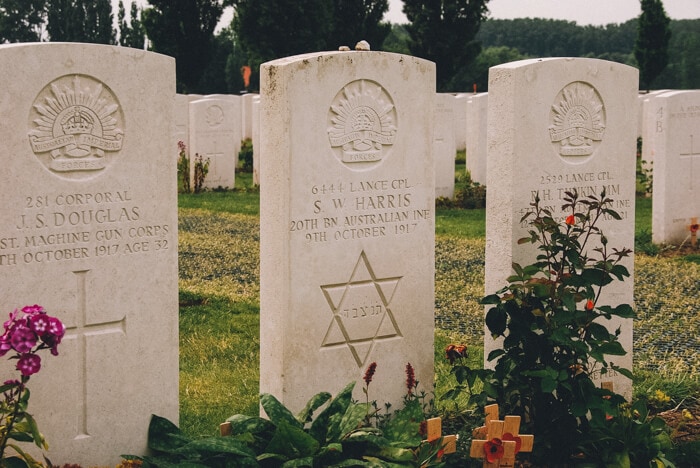
The original number of soldiers buried at this site was greatly augmented at the end of the war, with burials from several battlefields and smaller cemeteries concentrated here. There are 11,954 Commonwealth burials from the Great War with 8,367 of those unidentified.
This cemetery is another of the post-Armistice cemeteries created in an effort to consolidate all of the burial sites from battlefields and dressing stations in the outlying areas. There are 1,538 Commonwealth servicemen interred at this site, with 1,135 of those listed as unknowns.
Located in a heavily-contested area that changed hands several times during the course of the First World War, this small cemetery contains 4 Commonwealth burials.
Created after Commonwealth troops cleared the woods, this front-line cemetery was used from August 1917 until September 1918. There are 107 Commonwealth soldiers buried at this site, 19 of them unidentified.
Not a cemetery, this memorial to the missing pays respect to the more than 11,000 Commonwealth servicemen who were killed in this area in Belgium in WW1, but who have no known grave.
This memorial to the missing is in honor of Irish war poet Francis Ledwidge who was killed during the First World War at Rose Crossroads in Boezinge.
WW1 Belgian forts you can visit
Built in the late 1800s to help defend the areas surrounding Namur, this fortification came under heavy fire on the afternoon of August 24, 1914. Although sturdy in construction, the scale, and length of the attack was more than the facility could withstand.
Many soldiers were overcome by toxic gasses from their own weapons as well as those emanating from exploded enemy ordinance. Though abandoned and even buried, the fort is being restored section by section by volunteers.
This fortification is unique in that it is the only one of the original Liège WWI forts to remain unaltered since 1914. It fell under German attack in August of 1914 and, because of inadequate ventilation, was surrendered three days later. Currently, the fort is open for tours, but availability can be an issue, so calling to secure reservations is wise.
When the Germans arrived at the Liege fortifications during the Great War, they were dismayed to find how resistant they were to the firepower that they had brought to bear. They sent for much heavier siege weapons against which the fort had no defense. Building damage and lack of air circulation brought about the surrender on August 14, 1914. In addition to the museum, all that remains of the fort today is the air intake structure and two of the bunkers. There is also a small cemetery on site as well as a memorial to the dead.
Part of the Fortifications of Liege, this fort withstood a punishing German attack for eleven days before surrendering. It took a 42 cm, 800 kg shell from the famous gun known as “Big Bertha” to shatter the fort, killing 350 men. Today, the site offers visitors a chance to experience life in the fort, including a reenactment of the fatal explosion. You can see the enlisted men's quarters, the officers mess, and more, including recovered artifacts from the era like weapons, uniforms, and personal effects.
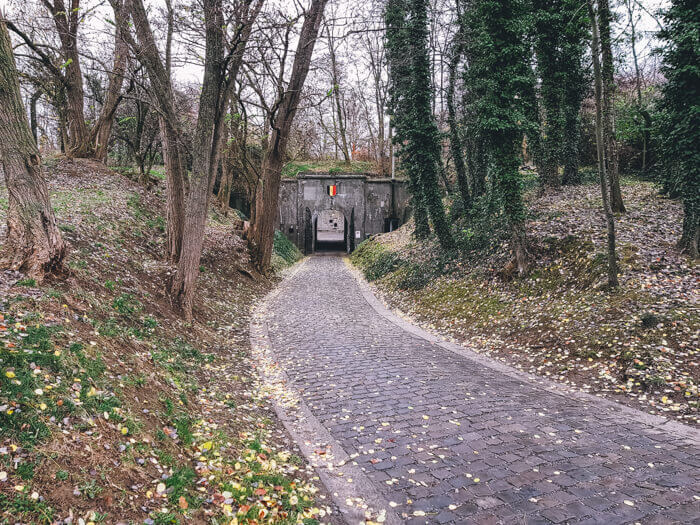
This fort has survived a great deal of damage as the result of two World Wars, but the bulk of the facility is still open to the public. Visitors can take an underground walking tour of the galleries and get a feel for what daily life was like in the fort. There is an excellent 3D reconstruction of the fort as it was in May of 1940 which gives you an idea of how the defenses of the fort evolved between wars. There is also an impressive collection of equipment, weapons, uniforms and more from both World Wars.
Built in the late 1800s with the idea of protecting the Liege area, this fort saw heavy military action in both World Wars. Today you can appreciate the size and scope of this defense by enjoying a 6 km walking tour of the area. Although the fort itself has been abandoned and partially buried, you can still see the air tower and other well-known military landmarks in and around the site.
Fort d’Emines fired its first defensive shots on August 23, 1914. It was met with heavier fire from the German artillery batteries and began to sustain serious structural damage. The fort was forced to surrender the following day after being hit by over 1500 shells. The fort was closed to the public for some time but opened for tours in 2008. Advance booking of tours is strongly recommended. Sections of the fortification which are closed for safety reasons are available digitally.
Important WW1 memorials and WW1 monuments
Saint Michael’s Church has had a long and painful history since its construction in the 13th century. It was partially destroyed by fire in 1579 and very gradually rebuilt over a period of decades. During an attack in World War One, the church was again almost completely demolished by bombs. It was rebuilt again in the 1920s. Although artillery badly damaged the church during the Second World War, it was nowhere as serious and repairs were soon underway yet one more time.
Beginning in 857 as a simple chapel, St. Vedast Church in Vlamertinge has been destroyed and rebuilt a number of times. The most recent rebuilds took place after shelling damage in World Wars One and Two. The original 64-meter-high Neo-Gothic-style tower has been duplicated – as much as possible – in the current incarnation of the church.
Commemorating the Christmas Truce of 1914, the Khaki Chums Cross was originally erected 1999 by a group who wanted to make sure the event would be remembered for a long time. They recreated the World War One conditions, right down to digging trenches and sleeping on the soaking ground. A wooden cross was erected as a to the soldiers of both sides of the conflict – as a sign of respect. The locals were so touched that they preserved the cross and set it in cement as a permanent reminder of that special Christmas so long ago.
Canadian forces, in their first battlefield appearance of the Great War, acquitted themselves admirably and gained the respect of other combatants. Near Ypres, their forces, in concert with British and French divisions encountered one of the first poison gas attacks. Suffering great losses, they continued to hold strong against the Germans and even mounted a counter-offensive of their own. The beautiful memorial topped by a touching stone bust, stands over the site where 2,000 Canadian troops gave their lives.
Along the banks of the Lys river, near Zulte, there is a bridge which has become a landmark for its part in battles in both World Wars. Multiple battles were fought over this strategically valuable bridge, giving it its name. It has become so important that, even though the Lys has been redirected around the area, the bridge still stands as a monument.
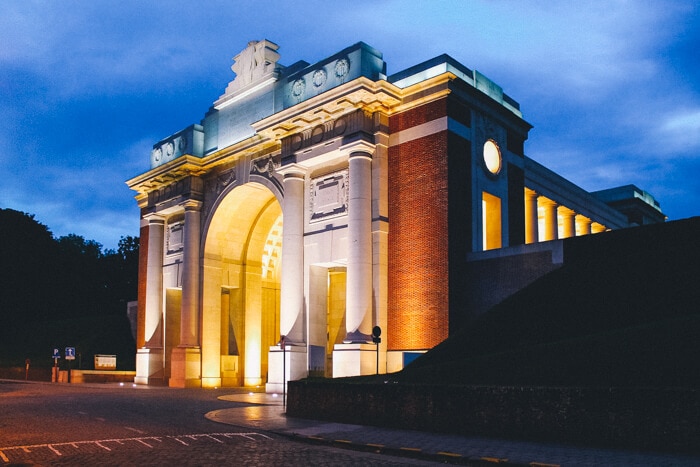
Just on the outskirts of Ypres sits the famous Hooghe Chateau – site of some of the most intense fighting in the First World War. The strategic location of the property made it of supreme importance to both sides and, as is often the case in war, this section of land was taken, lost and retaken many times. The site has been excavated and numerous items from that time have been recovered and are now a part of a historic display. Visitors can also enter some of the concrete bunkers from that time.
This memorial is a tribute to the 566 Commonwealth soldiers who died during operations along the coast of Belgium during the First World War. Located near the mouth of the Yser, it is an eight-meter-high pylon of Euville limestone and is surrounded by a band of bronze. On this band are engraved the names of those who are memorialized.
This unique memorial, located in Boezinge, is only possible through the hard work and determination of a group of amateur archeologists known as “The Diggers”. They did the research to locate the trench systems and began the actual reconstruction of the trenches themselves. During that process, the remains of a number of British, French, and German soldiers were discovered and returned to their respective countries for full military burials. The reconstruction of these trench systems will give visitors an idea of their construction as well as the brutal and claustrophobic atmosphere in which these soldiers fought.
This section of the Belgian Railway, also known as the “Frontzate” was very critical to World War One combat forces. Strategic flooding of the plains between the Yser and the railway embankment helped provide a barrier against enemy troops. Allied Supreme Commander Foch once said that France was saved by a meter and a half high railway embankment. Where the bed of the tracks was located, today there is a well-maintained path for walking or bicycling. From this picturesque path, visitors can still see the gun positions, observation posts and even a number of bunkers from the war.
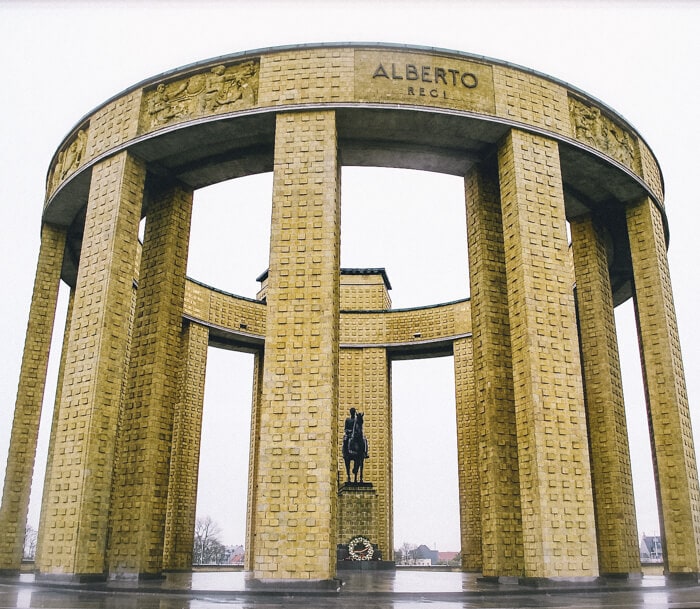
This monument, located in Nieuwpoort, is unique in that it commemorates two separate battles fought by the 7th Line Regiment. It honors both the Battle of the Yser and the Battle of Lombaert Zyde, fought in October and November of 1914, respectively. The memorial includes a large statue of a soldier with his hands clasped over his rifle, as though honoring those who made the ultimate sacrifice here.
If you are a lover of early aviation and the role it played in the Great War, this memorial will both thrill and educate you. Dedicated to one of the earliest wartime aviators, Georges Guynemer, this pavilion includes information on the legendary flyer as well as a documentation of the development of aircraft during the First World War. There is even a complete replica of the Morane-Saulnier aircraft which he flew.
While the Belgian Army began to flood the polders between the local railway line and the Yser, the German forces captured the town of Ramskapelle, stationing machine guns at high points in the surrounding area to lay down suppressing fire. On the 31st of October, the 14 Line regiment helped launch a counter-attack which retook the town and drove the German forces into the ever-deepening water. This memorial celebrates the heroism of those liberating forces and honors those lost in the fighting.
Hill 60 was actually made up of dirt and rock which was moved to construct the nearby railway. It was also the highest point in the area, which made it strategically invaluable during the Great War. The hill was taken and retaken many times by Allies and enemy forces. It was tunneled into, riddled with mines, and concrete bunkers and pillboxes were built into its sides. Hill 60 was fired upon with countless artillery shells and small arms fire and sadly, it is the final resting place for many soldiers who fought there.
Ypres Salient saw a number of significant battles during the Great War. Today, in addition to many memorials built to honor those who fought and those who gave their lives in these battles, there are many remnants of war. You can find concrete bunkers, remains of trench systems, and even bomb craters. Visitors to the area can also pay their respects at any of a number of cemeteries.
As the deepest advance of the German army in World War One, Sint-Eloi was also the center of fierce fighting. This included the detonation of mines in the area, making them as deep and as powerful as possible in order to inflict as much damage and carnage as possible. Both sides of the conflict took part in this mine warfare and the result is the enormous mine crater which can be seen today. The crater is still flanked by a British bunker, another reminder from 1917.
The Island of Ireland Peace Park is just south of the village of Messines. It is dedicated to all Irish soldiers, regardless of their religion or political affiliations. Many combatant countries in World War One had Irish men and women serving in their ranks and this monument is in their honor, as well. A classically Irish round stone tower, it is designed and built so that the interior of the tower is lit by sunlight on the 11th hour of the 11th day of the 11th month, recognizing the Armistice agreement which ended the fighting.
The Great War saw combat on a scale never before imagined. And the war’s effects on those fighting was not very well understood. Because of this, many soldiers who were “shell-shocked” either tried to run away or simply would not continue to fight. These unfortunates were quickly court-martialed, held in a death cell, and executed by firing squad the next morning. The cells and the execution pole are now a part of a historical display in the courtyard of the town hall.
This memorial is actually a merger of two projects; the Inter Allied Memorial Tower, and a regional church of the Sacred Heart. The church was built to commemorate the Great War and the tower was designed as a tribute to the countries that worked together to defeat the invading armies. The memorial was built in Liege, the first city to face attack in the War and the first to raise armed opposition to the invading force.
One way to experience what life in the trenches of World War One was like is to visit the Bayernwald Trenches. Restored with historical accuracy, just as they would appear in 1916, this trench system will allow you to appreciate the labor that went into building and reinforcing these trenches. In addition to standard sandbag construction, these trenches also feature woven branches along the sides, duckboard walkways, and reinforced concrete dugouts.
Built by British engineers, these bunkers are interconnected and provided strategic shelter during the Great War, as well as a headquarters for military operations in the area. Although some areas are no longer accessible by visitors, there is still plenty of World War One history to explore. Allow plenty of time to walk the area and get an idea of the part these bunkers played.
These memorial stones are placed on either side of the road where the two divisions fought side by side for the first time. The predominantly Protestant 36th (Ulster) Division and the mostly Catholic 16th (Irish) Division linked up at this spot during the Great War. These stones were dedicated in 2007 as a part of the 90th Anniversary of Passchendaele Commemorations.
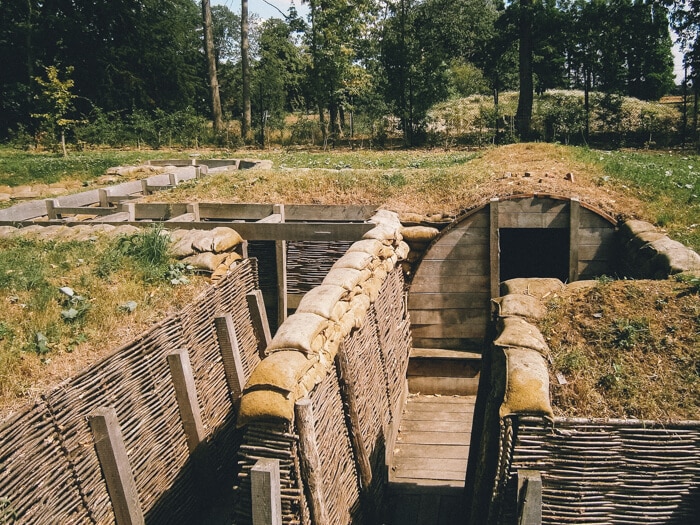
Ironically, the Pool of Peace was created by a devastating act of war. It was a part of the mine warfare of World War One which was waged by both sides in an effort to gain some strategic advantages. Nineteen deep mines were detonated in June of 1917, creating the loudest man-made sound up to that point. It was said that the explosion was heard as far away as Dublin. After the war, this particular piece of land was purchased and reclaimed so as to preserve the now water-filled crater as a Pool of Peace.
Completed in 1929, this beautiful church honors the memories of over 500,000 British and Commonwealth soldiers who gave their lives in the three major battles fought for Ypres. The church is open to visitors every day and regular church services are held. The services are ecumenical and everyone is welcome to attend them.
This local mill, built in the 1800s was a part of the local agrarian commerce and also included a small inn. During World War One, it fell victim to wartime strategies and was dynamited down to roughly half its original height to prevent it from being used as an observation post. In 1995 the mill and the Miller’s house were designated for protection as a monument due to its historic past.
This incredible work of art is a tribute and remembrance of all victims of the Great War who lost their lives on Belgian soil. Toward that end, the artists created 600,000 figurines out of native clay and set about displaying them in an appropriate setting. At the heart of the enormous work, is an egg, symbolizing the fact that even in the aftermath of war, there can still be life. The scale and scope of this work is a way to put a more human face on that terrible loss of life.
This incredibly well-preserved and restored command post bunker was built in 1916 and is open to visitors with no charge. In 1999 this bunker was officially designated as a monument. All six rooms in this 19-meter-long bunker are accessible. There is a concrete plaque in the bunker describing when it was built and by which unit of the Imperial German Army.
There are also a bunch of bunkers and literally hundreds of other, smaller memorials spread throughout the country and especially in West Flanders. I don't think it would be of much value to list all of them here but if you're interested in them this site has a complete list.
In regards to the bunkers: most of these are in ruins or not accessible. When they're potentially worth a visit, I've listed them above.
Around West Flanders, there are also a bunch of craters created by bomb impacts. Some craters were filled up again in the past. Others are still visible, although often barely. Only the ones mentioned above (Hill 60, Hill 62, and the Pool of Peace) are somewhat worth a visit. Lots of (former) crater sites nowadays lie on private property too.
In terms of cemeteries, the ones above are military cemeteries or communal cemeteries which also have a lot of war graves. There are, however, also communal cemeteries where just a few former soldiers, or sometimes even just one solder, have or has been buried. These are not listed in this post.
If you'd rather visit the Belgian World War 1 sites with a guide, there are plenty of WW1 battlefield tours to choose from:
1. World War I Battlefields Tour of Flanders from Brussels On this full-day tour from Brussels, an expert guide takes you to WWI-related memorials, cemeteries, and the renowned In Flanders Fields museum. You'll also get the chance to spend time in Ypres and experience the Last Post ceremony there in the evening.
Aside from the tour itself, hotel pick-up in an air-conditioned vehicle and lunch at Passchendaele’s famous Old Cheese Factory are included.
Click here to book this tour.
2. Private World War I Flanders Battlefields Tour from Brussels This full-day tour is similar to the one above except that it's a private tour, which means that you'll have your guide all to yourself and will be able to personalize the itinerary based on your interests. Lunch isn't included but hotel pick-up is.
3. Private WWI Canadian Battlefields tour from Brussels This full-day private tour focuses on the role of Canada in the First World War. You'll visit places like the Thiepval Memorial, Beamont-Hamel, Vimy Ridge and Tyne Coty Cemetery. On top of that, you'll get to experience the Last Post Ceremony in Ypres and all of this while traveling in a luxury minivan with an expert guide to answer all of your questions.
This tour includes hotel pick-up but no meals.
4. Private WWI day tour from Paris This full-day tour from Paris takes you to some of the most important World War One sites in Flanders. A professional guide will tell you all about places such as Tyne Cot Cemetery, Hill 60, and the St Julien Memorial. You'll end the day in Ypres, where you'll have some free time after having visited the Menin Gate.
5. Full-day Flanders Battlefields tour from Bruges On this full-day battlefields tour, an expert historical guide will take you to some of the most moving memorials and cemeteries as well as to the exquisite In Flanders Fields Museum. In the evening, you'll attend the famous Last Post cemetery at the Menin Gate in Ypres.
Aside from the guided tour itself, lunch and admission to the In Flanders Fields Museum are included.
6. Small-Group Australian Battlefield Tour from Bruges On this full-day trip from Bruges, you'll focus on the role Australian soldiers played in World War I in Belgium. You'll visit cemeteries such as Messines, Polygoon Wood and Passendale and will see mine craters laid by the 1st Australian Tunnelling Company. You'll end the day in Ypres where you'll attend the Last Post ceremony at the famous Menin Gate.
Aside from the actual guided tour, this experience includes hotel pick-up and drop-off and lunch.
7. Private New Zealand and Australia Battlefield Tour This full-day private tour from Ghent focuses on the ANZAC Corps, made up of Australians and New Zeelanders. You'll visit places such as the memorial on Messines Ridge, the Pool of Peace (Spanbroekmolen), several cemeteries, and Ypres in the company of an expert guide.
This tour starts at the Kortrijk train station and includes a drop-off at your hotel in Ghent should you choose to stay there. Lunch is included in the tour price.
Whether you'd like to stay in a city like Brussels, from which many tours depart, or somewhere near the battlefields to explore them by yourself, I highly recommend Booking.com to book your accommodation. It's where I always book my hotels as I love their filtering options and they always seem to offer a great price as well.
Depending on where you come from and how you want to visit the battlefields, you can choose to travel to Belgium by bus, train, plane, or car.
By bus Flixbus offers long-distance bus travel between European cities at cheap prices.
By train The NMBS is the Belgian railroad company. On their international website , you'll find train times and prices for trains to and within Belgium.
By plane Brussels Airport is the biggest and most important international airport in Belgium. Brussels-South or Charleroi is the second biggest and from a select number of destinations, you can also fly into Antwerp or Oostende. I recommend checking Skyscanner for an extensive list of flight options and prices.
Also interested in WW2 sites? Find my list of World War 2 tours, museums, and war memorials in Belgium here.
And if you want to go behind the battlefields, check outthese fun things to do in Belgium .
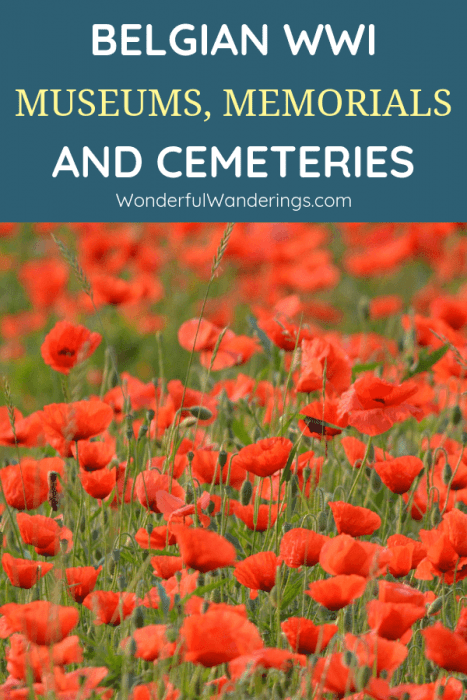
The editorial team at Wonderful Wanderings brings together travel experts with backgrounds in travel writing, web development and digital marketing. The team, through their collaborative effort, provides readers with relevant travel experiences and up-to-date digital content. The vast expertise within the team ensures an informative blend of travel stories and useful online travel guides and trip experiences, built on a foundation of both industry recognition and hands-on global adventures. Learn more about Wonderful Wanderings
Your email address will not be published. Required fields are marked *
Join 58,000+ other Wonderful Wanderers!
As an Amazon Associate I earn from qualifying purchases.
- Skip to global NPS navigation
- Skip to this park navigation
- Skip to the main content
- Skip to this park information section
- Skip to the footer section

Exiting nps.gov
Alerts in effect.
- Learn About the Park
- News Releases
News Release
World war i weekend at eisenhower national historic site.
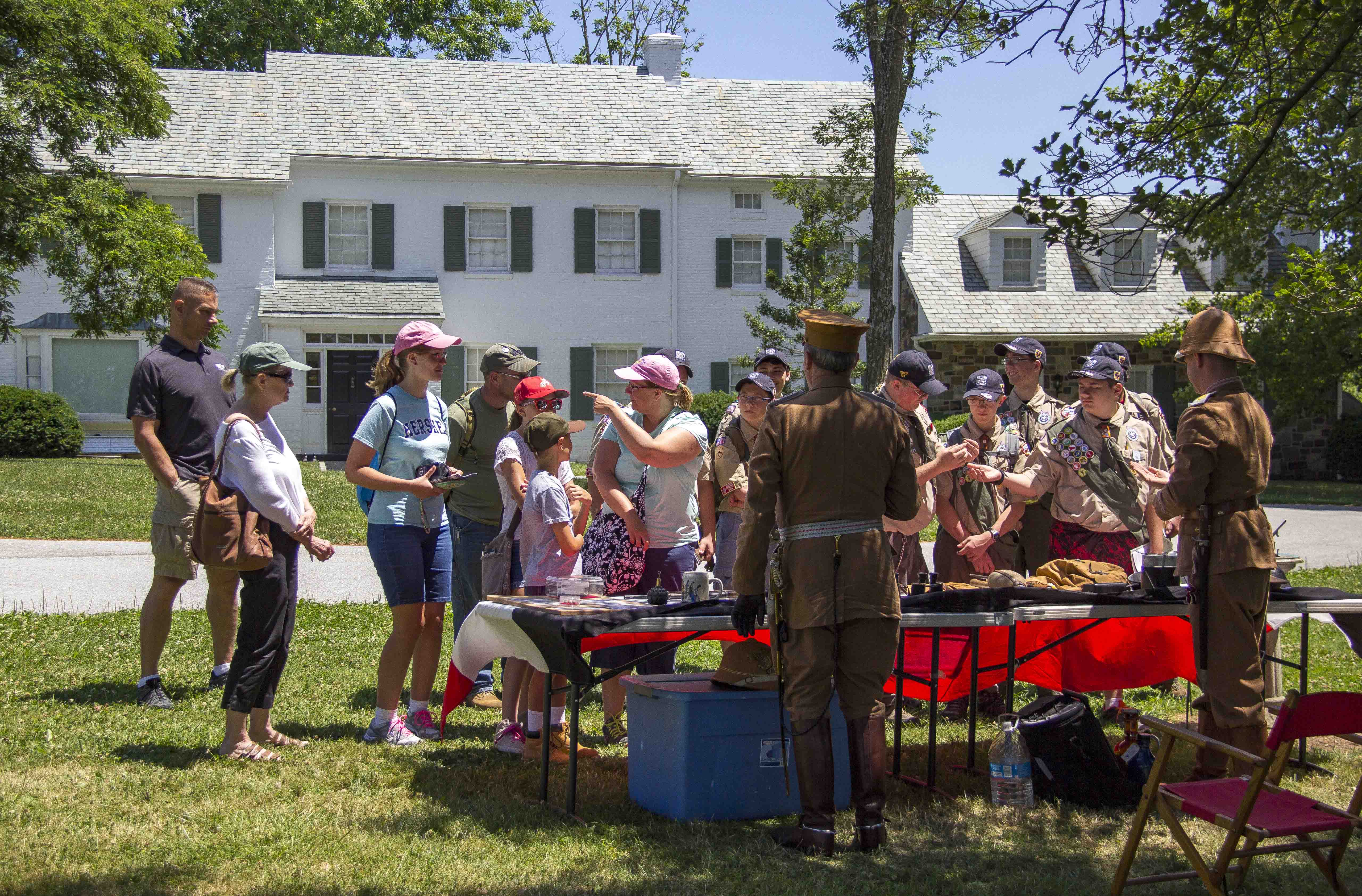
Contact: Dan Vermilya
Contact: Jason Martz
GETTYSBURG, PA—How did Gettysburg and the Great War shape a future five-star general and president? Explore answers to this question and more at Eisenhower National Historic Site’s (NHS) World War I Weekend on May 4 and 5. The National Park Service will host interactive living history displays with exhibits and programs exploring the American experience in World War I. On May 4 and 5, Eisenhower NHS will partner with the East Coast Doughboys, United States Marine Corps Historical Company, United States Naval History and Heritage Command, and the “Pall Mall Doughboys” from Sergeant Alvin C. York State Park, Tennessee for free exhibits and living history displays. Living historians and park staff will also provide free programming throughout the weekend. The living history displays will be open for the public from 10 am through 4 pm on Saturday and 10 am through 3 pm on Sunday. In addition to these displays, the Eisenhower home will have an open house. Visitors will be admitted to the home for self-guided tours on a rolling basis between 10 am and 3 pm on both days. Over four million Americans served in uniform during World War I, with over 100,000 losing their lives in the conflict. In the spring of 1918, Captain Dwight Eisenhower arrived in Gettysburg to command a new tank training camp. While Eisenhower never saw action in Europe during the First World War, his time in Gettysburg training soldiers was part of the larger American experience of that conflict. “The Great War” saw the United States and its citizens emerge as leaders on the world stage, shaping the course of the 20 th century. Admission to Eisenhower NHS is free. Visitors may drive directly to the site. Please use 250 Eisenhower Farm Rd for GPS or visit here for directions. Please follow signs for on-site parking.
www.nps.gov
About the National Park Service. More than 20,000 National Park Service employees care for America’s 429 national parks and work with communities across the nation to help preserve local history and create close-to-home recreational opportunities. Learn more at www.nps.gov , and on Facebook , Instagram , Twitter , and YouTube .
Last updated: April 18, 2024
Park footer
Contact info, mailing address:.
1195 Baltimore Pike Gettysburg, PA 17325
717 338-9114
Stay Connected
Iran launches retaliatory attack on Israel with hundreds of drones, missiles
- Medium Text
- For a Reuters live page of coverage of the Iranian attack, click
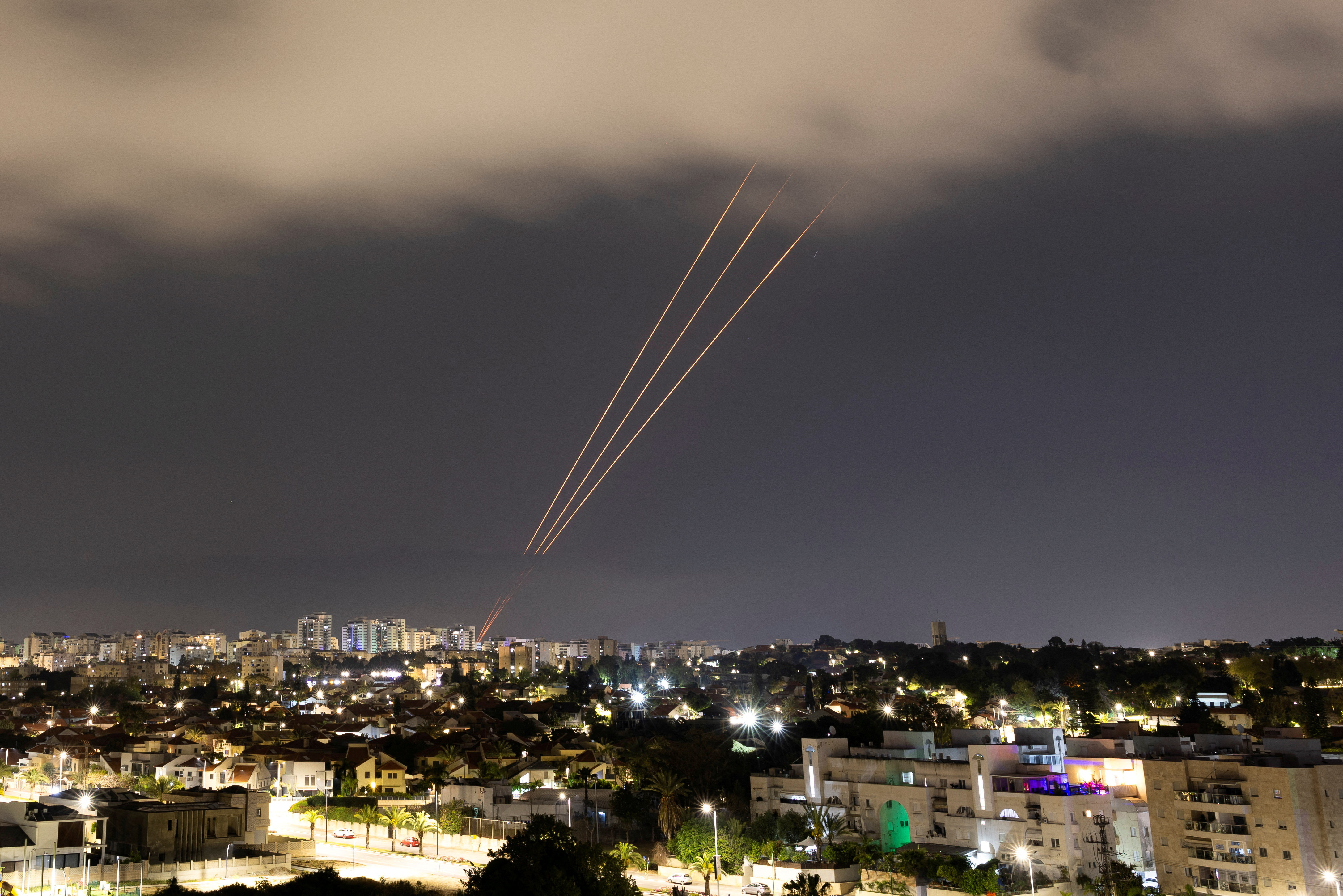
Coming soon: Get the latest news and expert analysis about the state of the global economy with Reuters Econ World. Sign up here.
Reporting by Dan Williams in Jerusalem, Parisa Hafezi in Dubai, Timur Azhari in Baghdad, Jeff Mason, Eric Beech and Doina Chiacu in Washington and Suleiman al-Khalidi in Amman and Lidia Kelly in Lisbon; Writing by Angus McDowall; Editing by Jonathan Oatis, Daniel Wallis, Chizu Nomiyama, Howard Goller and William Mallard
Our Standards: The Thomson Reuters Trust Principles. New Tab , opens new tab

World Chevron

Jury selection complete in Trump criminal hush-money trial
The jury for Donald Trump's historic hush-money trial was completed on Friday, clearing the way for prosecutors and defense attorneys to make opening statements next week in a case stemming from hush money paid to a porn star.
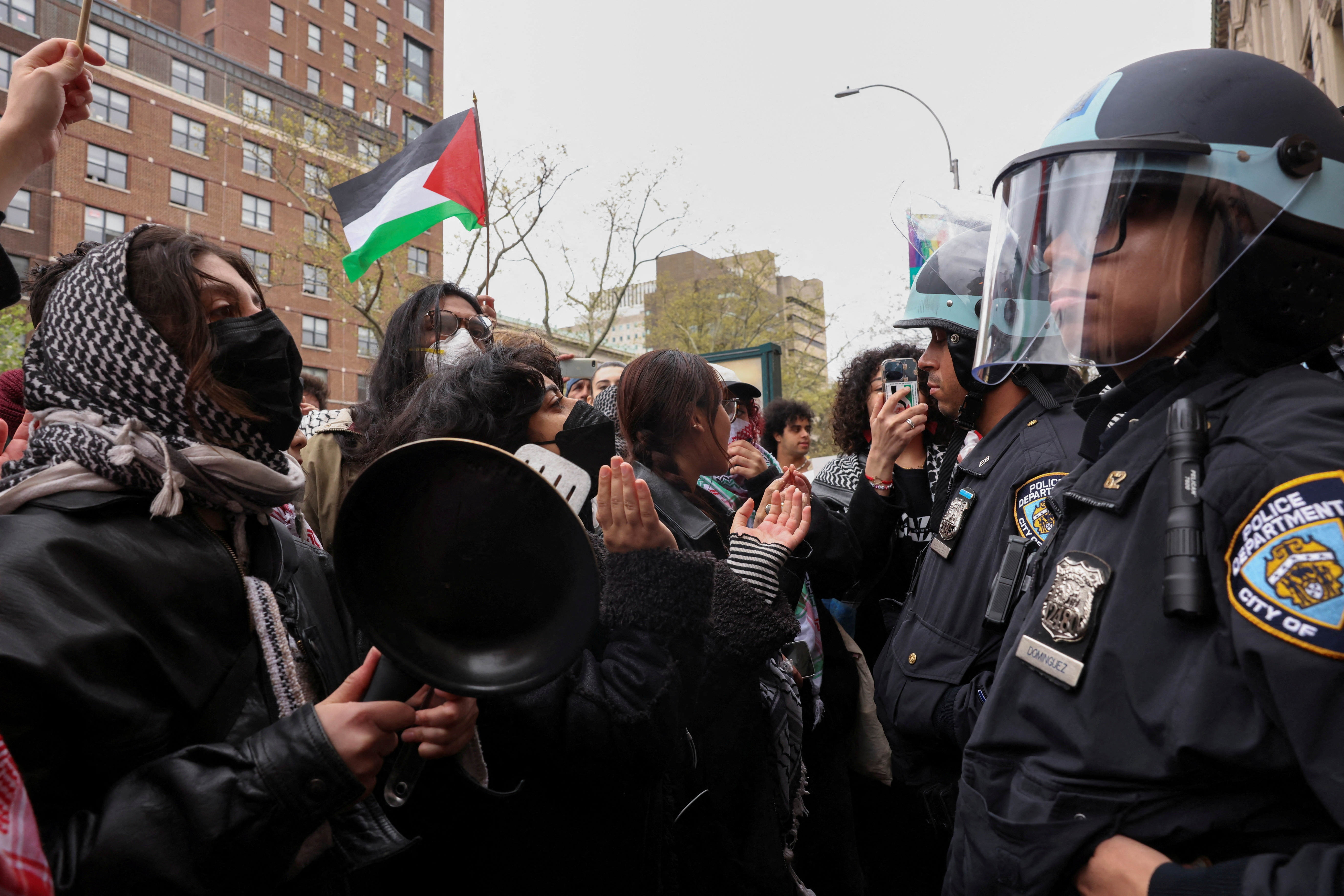
BREAKING: Jury selection is complete in Trump's hush money trial. Lawyers to debate possible Trump testimony next.
Iran attack: Israeli response to attack may be 'imminent,' source says
What to know.
- An Israeli response to Iran's retaliatory attack may be “imminent,” a source told NBC News as Israel weigh ed its next steps and after a meeting of the country’s war Cabinet today.
- The two countries clashed at an emergency meeting of the United Nations Security Council, with Tehran insisting it does not seek further escalation after it launch ed the barrage of 300 drones and missiles but warning of more "decisive" strikes in retaliation to any Israeli counterattack.
- U.N. Secretary-General António Guterres said it was time to “step back from the brink” as a chorus of world leaders urged restraint. President Joe Biden has warned Israeli Prime Minister Benjamin Netanyahu against launching new strikes on Iran . He said the U.S. would not participate in any offensive actions against Iran but has privately said he fears that Netanyahu is trying to drag the U.S. into a wider conflict, officials told NBC News.
U.S. officials expect Israeli response to Iran strikes will be limited
Courtney Kube
Mosheh Gains
Monica Alba
U.S. officials expect a possible Israeli response to Iran’s attack over the weekend to be limited in scope and most likely involve strikes against Iranian military forces and Iranian-backed proxies outside Iran, four U.S. officials said.
The U.S. assessment is based on conversations between American and Israeli officials that happened before Iran fired more than 300 drones and missiles at Israel on Saturday night.
As Israel was preparing for a possible Iranian attack last week, Israeli officials briefed U.S. officials about possible response options, the U.S. officials said.
The U.S. officials stressed that they have not been briefed on Israel’s final decision about how it will respond and that the options could have changed since the weekend attack. They also said it is not clear when an Israeli response will happen, but they said it could happen at any time.
Read the full story here.
Johnson outlines House plan to vote on foreign aid bills
Rebecca Kaplan
Zoë Richards
House Speaker Mike Johnson spoke to reporters after a GOP conference meeting that he said was “fruitful and productive” and outlined his plan to put four national security bills on the House floor: Israel aid, Ukraine aid, Indo-Pacific aid and a fourth measure that includes GOP national security priorities that would include more sanctions on Iran.
“Every member ultimately will be able to vote their own conscience on all of these matters and everyone have an opportunity to weigh in and bring the amendments that they think are suitable,” said Johnson, R-La.
He said that he would prefer to send each bill to the Senate individually but that no final decision has been made.
If bill text comes out tomorrow, as is the hope, Johnson said, the House might not vote on the packages until Friday. The House is scheduled to leave Thursday afternoon and be in recess next week, but that could change.
Iranians anxious as Israel weighs strike response
DUBAI, United Arab Emirates — The prospect of Israeli retaliation against Iran for its drone and missile attack over the weekend has alarmed many Iranians already facing economic pain and tighter social and political controls after protests in 2022-23.
Iran’s political and military leaders have repeatedly warned that they will respond to any Israeli retaliation by escalating further, potentially triggering yet more attacks.
And that would only be bad news for ordinary people, said Hesam, 45, a teacher from the northern city of Amol.
“Economic pressure will mount. Our safety will be jeopardized. ... We must avoid conflict at all cost. I don’t want a war. How can I protect my two children? Nowhere will be safe.”
Middle- and lower-income Iranians are shouldering much of the burden of the economic woes, with inflation over 50%; rising utility, food and housing prices; and the rial currency falling sharply.
Parvaneh, 37, a mother of two in the central city of Yazd, fears an Israeli strike could be the final hammer blow to the economy, weakened by years of sanctions, mismanagement and corruption.
“We Iranians have endured more than enough for years. War brings only disaster. My husband is a factory worker. We do not have even enough money to buy staples, let alone stockpile them,” she said.
Bilal Saab, an associate fellow at Chatham House, a think tank based in London, says the Iranian strikes on Israel signify that Iran has the ability to potentially mount a more significant attack.
Rep. Scalise offers support to Netanyahu in call
Yael Factor
House Majority Leader Steve Scalise, R-La., conveyed support for Israel following Iran's retaliatory strikes over the weekend in a call with Netanyahu today, according to both of their offices.
Netanyahu's office said in a statement that Scalise expressed support "for any decision that Israel makes in light of the Iranian attack."
"Majority Leader Scalise informed the Prime Minister of his initiative to advance in Congress, in the coming days, a series of measures against Iran and for Israel; Prime Minister Netanyahu thanked him," the statement said.
Scalise told Fox News that they spoke about the House agenda this week and that he spoke to Netanyahu about his support for Israel's right to self-defense.
"He truly appreciated the action we’re taking to support Israel and to hold Iran and their terrorist proxies accountable," he said.
Jordan allowed fighter jets to intercept Iranian drones, Israeli air force official says
Raf Sanchez
TEL AVIV — Jordan allowed Israeli fighter jets into its airspace to intercept Iranian missiles and drones, an Israeli air force official said today.
“In order to address something that comes from the east, we need to fly somewhere that is east of Israel,” the official said in a briefing for reporters. “This was done with coordination.”
While Iran’s direct attack against Israel was unprecedented, so was the scale of coordination between Israel and Jordan, its Arab neighbor, in the response. Jordanian and Israeli fighters — coordinated by the U.S. military — acted together to intercept the barrage of drones and missiles.
In a statement yesterday, Jordan’s government said the interceptions were made to ensure the safety of its citizens, rather than in defense of Israel.
But it is thought to be the first time the two countries’ militaries have fought side by side.
Jordan and Israel made peace in 1994, though the relationship has often been strained by disagreements over Israel’s treatment of the Palestinians.
U.S. looking to further isolate Iran, Kirby says
Ghael Fobes
Doha Madani
The Biden administration is working to "further isolate" Iran's regime by increasing economic pressure, White House national security communications adviser John Kirby told reporters today.
"That's the upshot here: a stronger Israel, a weaker Iran, a more unified alliance of partners," Kirby said.
Asked whether the U.S. would support a counterattack from Israel, Kirby told NBC News' Gabe Gutierrez it was a hypothetical question he would not entertain.
"We don’t want to see a wider conflict," Kirby said. "As the president said to the prime minister on Saturday night, we will continue to do what we have to do to help Israel defend itself. But you’re asking me to get ahead of — as far as I know — a decision that the war Cabinet hasn’t even made."
Blinken discusses regional concerns with visiting Iraqi delegation
Khalid Razak
Secretary of State Antony Blinken met with Iraqi Prime Minister Mohammed Shia Al-Sudani as part of Al-Sudani's official visit to Washington this week, Al-Sudani's office said in a statement.
The two officials spoke about strengthening relations between the U.S. and Iraq, as well as potential American investment opportunities, "especially in the fields of energy," the statement said.
Regional issues were also a topic, with Al-Sudani reiterating "Iraq’s clear position on the aggression, stressing the joint legal and moral responsibility for protecting unarmed civilians." The statement went on to say Al-Sudani stressed the importance of keeping the conflict from expanding.
A statement from Blinken's office was not yet available. Speaking to reporters alongside Iraqi Deputy Prime Minister Muhammad Ali Tamim, he said he was excited to welcome the Iraqi officials to the capital and hoped to "expand that 360-degree partnership" between their countries.
Both officials warned against escalating tensions in Iran.
The covert war between Israel and Iran has exploded into view. What comes next?
Daniel Arkin
The bitter conflict between Israel and Iran has long been confined to the realm of secret assassinations, audacious cyberattacks, nuclear sabotage and war-by-proxy. But that largely covert struggle burst into full view over the weekend with Tehran’s retaliatory drone and missile strikes.
Iran’s unprecedented direct attack on Israel, which followed its deadly strike on Iran’s consular building in Syria, left the U.S. and its allies scrambling to avoid a wider conflict as the world waits to see what comes next.
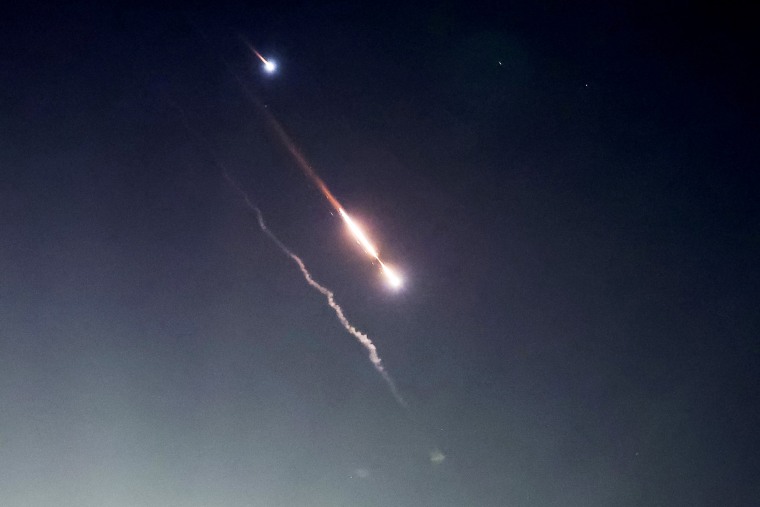
Netanyahu’s war Cabinet convened today to weigh its options. Western leaders have urged restraint, with Biden warning Netanyahu against carrying out new strikes on Iran and making it clear that Washington would not join in any such counterattack. (Speaking after the war Cabinet convened, an Israeli official told NBC News that a response may be “imminent.”)
While Israel took down almost all the drones and missiles used in the attack, the U.S. and other allied countries, the stakes after the attack could not be higher. In the eyes of some foreign policy hawks, the attacks could be perceived as a grave provocation that demands a furious rejoinder. But other analysts have warned that if Netanyahu decides to hit back hard, it could plunge the wider Middle East into war amid Israel’s devastating monthslong military campaign in the Gaza Strip.
Iran's response will be 'more extensive' if Israel counters, foreign minister told Cameron
Saba Hamedy
Iranian Foreign Minister Hossein Amirabdollahian warned that if Israel launches an attack, the regime's next response will be "immediate, stronger and more extensive."
In a call with U.K. Foreign Minister David Cameron yesterday, Amirabdollahian reiterated Tehran's position that the assault on Israel was within the country's legal right to respond to the strike on its diplomatic building and blamed the region's tensions on "the destructive role of the occupying Israeli regime," according to a state news report.
Cameron confirmed his call with Amirabdollahian on X, saying he formally condemned Iran's retaliatory strike on Israel. He also discussed the Revolutionary Guard's seizure of a Portuguese-flagged ship in the Strait of Hormuz.
"I made clear that Iran must stop these reckless attacks, de-escalate and release the MSC Aries," Cameron wrote .
Biden addresses Iran attack during meeting with visiting Iraqi prime minister
Biden took a moment to address Iran’s “unprecedented aerial attack” against Israel.
He said the U.S. and its allies were able to “defeat” the attack during a meeting with the prime minister of Iraq.
Bedouin girl severely injured during Iranian missile attack is still in intensive care, her father says
Anna Schecter
Paul Goldman
Rich Schapiro
The father of 7-year-old Amina al-Hasoni describes the chaos of the middle-of-the-night attack from Iran that left his daughter with a severe head injury from shrapnel.
Her injuries are the most severe casualty of the Iranian onslaught, according to Israeli authorities, as Israel's defense system was able to thwart most of the missiles and drones headed toward Israeli territory.
"We heard the rocket exploding over our heads. We didn’t know where to go, there was a lot of shouting and a lot of chaos," Amina's father, Mohammed al-Hasoni, told NBC News by phone Monday.
He said Amina is still in intensive care in a hospital in Be'er Sheva in southern Israel.
The Hasoni family lives in a Bedouin community in southern Israel. Bedouin communities number around 300,000, with very few of the resources enjoyed by other Israeli towns and cities, including bomb shelters that might have saved Amina's life, as was first reported by The New York Times.
"Amina has nothing to do with all that is happening [in the world], with this reality," her father said. "I just want peace."
Oil prices fall after Iran’s strike on Israel is thwarted
The Associated Press
Oil prices fell on Monday after Iran’s missile and drone strike failed to cause widespread damage in Israel and the U.S. made it clear it did not support a wider war with Iran.
Analysts say the chief risk to oil prices from the Israel-Hamas war would be if the conflict escalates and disrupts oil supplies from Iran and Persian Gulf producers through the Strait of Hormuz choke point.
Tougher sanctions enforcement against Iranian oil shipments by the U.S. could raise oil prices but would risk higher inflation and pump prices for U.S. motorists in an election year.
The stance taken by Iran, which said the matter “can be deemed concluded” with the retaliatory strikes, and the U.S. position reassured oil traders, who sent the price of international benchmark Brent crude 0.7% lower to $89.82 a barrel in Monday morning trading. That is below the levels just above $90 a barrel seen on Friday before the weekend attacks.
Risks that could send prices higher include any Israeli strike against Iranian oil facilities or tougher enforcement of sanctions against Iran by the U.S.
Israel’s response to the Iranian attack may be 'imminent,' official says
TEL AVIV — Israel’s response to the Iranian attack may be "imminent," an Israeli official said Monday.
Speaking after Israel’s war Cabinet met for several hours, the official said Israeli decision-makers believe it's important for any response to closely follow the attack. Several diplomatic and military options were examined during the Cabinet meeting, the official said.
“Any response will be coordinated with the Americans,” the official added.
Biden to host Iraqi leader, raising questions over U.S. presence in Iraq
President Joe Biden is set to host Iraqi Prime Minister Mohammed Shia Al Sudani this week for talks that come as tensions across the Middle East have soared.
The war in Gaza and Iran’s weekend attack on Israel in retaliation for a military strike in Syria have created a sharp rise in security fears and raised more questions about the two-decade American military presence in Iraq.
A U.S. Patriot battery in Irbil, Iraq, knocked down at least one Iranian ballistic missile, according to American officials.
Iran lifts suspensions on flights in Tehran as crisis simmers
Mithil Aggarwal
Iran has lifted suspensions on domestic and international flights from its capital, Tehran, the state-run IRNA news agency reported, possibly signaling a return to stabilization for now.
It comes as Israel weighs its response to the strikes and world leaders call for restraint.
Global airlines faced ongoing disruptions to flights after Iran’s missile and drone attacks on Israel narrowed options for planes navigating between Europe and Asia.
At least a dozen airlines have had to cancel or reroute flights over the last two days.
France raises security around Jewish community before Passover
The French interior ministry is increasing security for the Jewish community in the week before Passover and in the aftermath of Iran's attack on Israel over the weekend.
"As Passover approaches and given the current international situation, I have told local officials to significantly step up security at places visited by our Jewish compatriots, especially with regards to synagogues and Jewish schools," said Interior Minister Gerald Darmanin in a post on X Monday.
The news came as French President Emmanuel Macron announced the country was developing alternative plans should security threats pose risks to the opening ceremony for the Summer Olympics in Paris.
"We think there are security risks, we’ll have Plan Bs and even Plan Cs,” Macron told local news outlets.
Ukraine condemns Iran attack and says it needs help like Israel
Peter Jeary
Ukrainian President Volodymyr Zelenskyy has condemned Iran’s drone and missile attack on Israel and said his country needed help from its allies to fend off threats from the air, just as Israel did.
Zelenskyy again called on the U.S. Congress to approve a vital aid package that has been blocked for months by political wrangling. Ukraine’s forces are facing new onslaughts from Russian troops in the east and daily attacks on cities and infrastructure from Russian missiles and drones, many supplied by Tehran.
Iran says the U.S. should be 'grateful' for its restraint
Iran has said the U.S. should be "grateful" for what it framed as the restrained nature of its retaliatory attack against Israel.
Tehran is not seeking a further escalation in the region, foreign ministry spokesperson Nasser Kanaani said today.
He "advised the U.S. to take account of Iran’s responsible conduct and legitimate reaction to the Israeli act of aggression and to be grateful for Iran’s logical and legitimate operation instead of adopting an irresponsible stance," according to the semiofficial Tasnim news agency.
Aid into Gaza has increased ‘dramatically,’ Kirby says
Max Butterworth
Israel has increased the amount of aid reaching Gaza “dramatically,” National Security Council spokesperson John Kirby said today, calling for that flow to be sustained.
“In just the last few days, more than 2,000 trucks have been able to get in,” he said on MSNBC’s “Morning Joe,” with around 100 trucks entering the Gaza Strip in the last 24 hours.
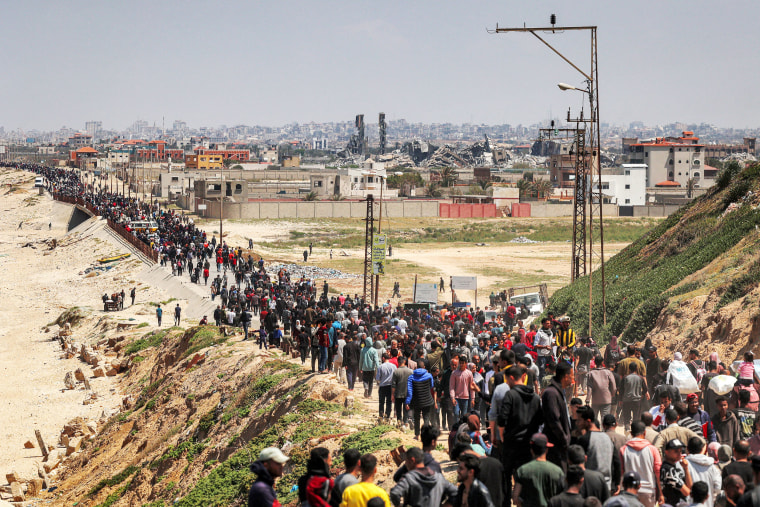
“Our policy with respect to Gaza will have to change if we don’t see changes over time and have them sustained,” he added.
Israel showed its 'military superiority,' White House official says
It's up to Israeli officials to decide on any response to Iran's attack over the weekend, but the U.S. ally should keep in mind its "incredible military achievement" in shooting down 99% of the drones and missiles, National Security Council spokesperson John Kirby said this morning on "TODAY."
Biden urged Netanyahu over the weekend to "consider the impact of that and the message it sent not only about Israel's military superiority but that Iran utterly failed in what it was trying to do," Kirby said.
"What we showed the other night is that Iran is not militarily superior, that Iran is not 10-feet tall and that Israel is not alone. We will act with them in their self-defense," he added.
Israel weighs response after Iran’s missile and drone barrage
Richard Engel NBC News Chief Foreign Correspondent, Host of MSNBC's "On Assignment with Richard Engel"
JERUSALEM — What happened this weekend could've easily started a massive war, and it's still not off the table while Israeli officials stay vague about any potential response.
'Double defeat' for Iran, U.K. says as Europe urges Israel to avoid further escalation
British Foreign Secretary David Cameron called the Iranian strikes a "double defeat" today, saying the United Kingdom has urged Israel to be "smart as well as tough" in weighing its response.
French President Emmanuel Macron also urged Israel against escalating the conflict further.
“We will do all we can to avoid things flaring up, escalating,” he told BFM TV and RMC radio today, adding that Israel should isolate Iran instead. “The situation is very unstable today,” he said.
Both the U.K. and France joined the U.S. in helping shoot down the drones and missiles Iran fired at Israel over the weekend.
Israel launches overnight strikes as it vows to press ahead with its war in Gaza
At least 68 people were killed in Gaza in the last 24 hours, the Palestinian enclave's Health Ministry said today, as Israel continued its strikes in Gaza overnight after vowing to press on with its war against Hamas.
“Even while under attack from Iran we have not lost sight, not for moment, of our critical mission in Gaza," IDF spokesperson Daniel Hagari said last night in a video statement.
U.S. says it intercepted 80 drones and 6 missiles launched from Iran and Yemen during attack on Israel
The U.S. military destroyed more than 80 drones and at least six ballistic missiles from Iran and Yemen during the Saturday night attack on Israel, U.S. Central Command said last night.
"This includes a ballistic missile on its launcher vehicle," it said in a statement on X.
Seven drones were destroyed before their launch from Yemen, it said, adding that the U.S. was supported by European forces.
‘You’re incredible:’ Biden thanks U.S. fighter squadrons that helped defend Israel
Biden thanked the U.S. fighter squadrons that helped defend Israel from a drone and missile attack by Iran. In a video posted to social media yesterday, he said, “You make me proud.”
Israeli war Cabinet to reconvene on response to Iran attack
TEL AVIV — The Israeli war Cabinet will meet today at 7 a.m. ET, an Israeli official told NBC News.
It comes after an Israeli official told NBC News following an hourslong meeting of the war Cabinet last night that the country would respond to the retaliatory strikes but that the scope and timing of that response had not yet been decided.
The official said that among the considerations were whether Israel needed to retaliate immediately or could afford to wait, and what impact any escalation against Iran would have on Israeli operations in the Gaza Strip.
Israeli schools to reopen, gathering restrictions relaxed
Schools are set to reopen in Israel today after they were shut as a security measure over the weekend due to Iran's retaliatory strikes, the Israel Defense Forces said in a statement on X.
Restrictions on public gatherings have also been lifted after a "situational assessment," it added.
Israeli military commanders gather at Kirya base in Tel Aviv
Lt. Gen. Herzi Halevi leads a situational assessment at the Kirya military base in Tel Aviv yesterday.
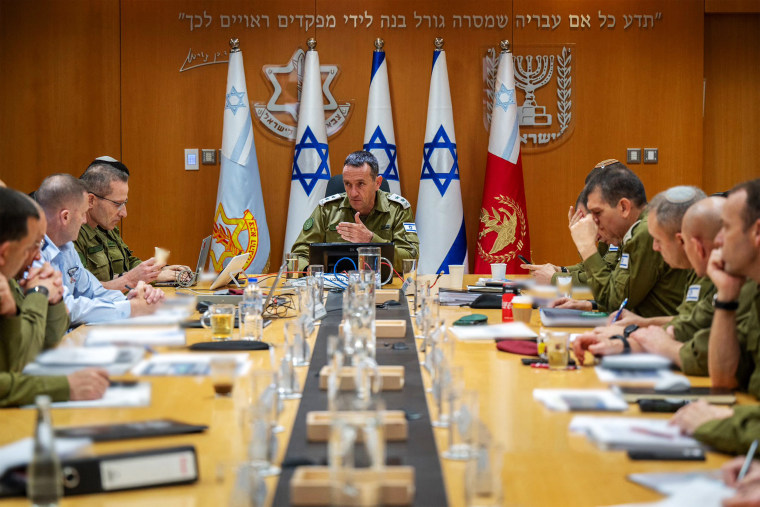
Catch up with our latest coverage
- Biden officials worry that Israeli response to Iran’s attack may trigger wider war
- Biden ‘doesn’t believe’ that Iran attack ‘needs’ to escalate into wider war, White House official says
- Johnson signals he won’t put Senate supplemental on the floor despite increased pressure
- Iran launches retaliatory attack on Israel that risks sparking regional war
- International edition
- Australia edition
- Europe edition
Russia-Ukraine war: Zelenskiy signs new mobilisation law in effort to boost Ukraine’s exhausted forces – as it happened
Kyiv brings in higher payments for volunteers and new punishments for draft dodgers
- 3d ago Closing summary
- 3d ago Ukraine identifies 37,000 people missing since Russia launched its full-scale invasion
- 3d ago Poland's president could meet Donald Trump in New York
- 3d ago German defence giant to build ammunition plant in Lithuania amid fears of Russian threat
- 3d ago Volodymyr Zelenskiy signs new army mobilisation law
- 3d ago Summary of the day so far...
- 3d ago Ukraine says it 'ran out of missiles' to stop Russian strike destroying power plant
- 3d ago Kremlin dismisses Macron's call for 'Olympic truce'
- 3d ago Russia-Ukraine Black Sea shipping deal was almost reached last month - report
- 3d ago Warnings over nuclear danger after attacks on Zaporizhzhia power plant
- 3d ago Opening summary

Volodymyr Zelenskiy signs new army mobilisation law
Ukraine’s president, Volodymyr Zelenskiy , signed into law a bill overhauling army mobilisation rules, according to the parliamentary website (see earlier post at 13.13 for more details)
The law will come into force a month after it is officially published, Reuters reports.
It obliges men to update their draft data with the authorities, boosts payments to those who volunteer, and adds new punishment for draft dodging. Russia has many more soldiers fighting in the war than Ukraine .
In the first weeks after the invasion, hundreds of thousands of ordinary Ukrainians volunteered to serve at the front in an explosion of patriotism that helped keep the country independent and fight off the initial attack.
More than two years later, however, many of those initial recruits are dead, wounded or simply exhausted, and the army needs new recruits to fill the ranks. By now, most of those who want to fight have already signed up, leaving the military to recruit among a much more reluctant pool of men.
Vladimir Putin ordered a “partial mobilisation” of 300,000 reservists in September 2022 , after a series of military defeats saw Russian forces routed from east Ukraine’s Kharkiv region and under increasing pressure in the southern Kherson region.
Since then, it has replenished its ranks by recruiting prisoners as well as luring tens of thousands of recruits from poorer Russian regions with the promise of high salaries.
At the end of 2023, Putin said that 486,000 new recruits had joined the army that year and that 1,500 a day were signing contracts.
Closing summary
Ukraine said it had identified almost 37,000 people, including military personnel, who are unaccounted for since Russia launched its full-scale invasion in February 2022.
Ukrainian President Volodymyr Zelenskiy has signed a mobilisation bill into law with the aim of boosting troop numbers. The parliament’s website said the bill had been “returned with the signature of the president” on Tuesday, after receiving final approval from lawmakers last week. The new law toughens penalties on draft dodgers, incentivises conscription and obliges men to keep their military registration details with the authorities up to date.
Polish President Andrzej Duda may meet Donald Trump during a visit to New York this week, he said on Tuesday . “If there is such a possibility, because it also depends on the schedule, I will also meet socially with … Donald Trump,” Duda, whose term in office expires in 2025, told reporters before boarding his plane. An informal meeting could reportedly take place on a visit to New York during which Duda is scheduled to meet the UN secretary-general António Guterres.
Lithuania and German weapons manufacturer Rheinmetall has agreed to build an ammunition plant in the Baltic state, in a new sign of Europe re-arming to counter any threat from Russia . Germany’s largest military equipment maker and the Lithuanian government signed a letter of intent to set up a factory to make 155mm artillery shells in the EU and Nato member.
In a wide-ranging interview with PBS NewsHour , Volodymyr Zelenskiy , said a lack of air defence missiles prevented Ukraine from thwarting a Russian missile attack last week that destroyed the Trypilska thermal power plant . His comments gave fresh urgency to Kyiv’s pleas to be sent more military weapons from its allies as the war appears to have turned in the Kremlin’s favour over recent months.
Mike Johnson , the US House speaker, has unveiled a complicated proposal for passing wartime aid for Israel, Ukraine and Taiwan . Facing an outright rebellion from conservatives who fiercely oppose aiding Ukraine, Johnson said he would push to get the package to the House floor under a single debate rule, then hold separate votes on aid for Ukraine, Israel and Taiwan and several foreign policy proposals, according to Republican lawmakers.
Germany’s chancellor, Olaf Scholz , has said he hoped Berlin and Beijing could help achieve a “just peace” in Ukraine , as he met his Chinese counterpart, Xi Jinping , in the Chinese capital.
Ukraine’s UN ambassador, Sergiy Kyslytsya , has accused Russia of a “a well-planned false-flag operation” endangering the Russian-occupied Zaporizhzhia nuclear plant, as the two countries traded accusations at the UN security council over alleged attacks on Europe’s largest nuclear power station. The Zaporizhzia nuclear power plant reportedly suffered at least three direct strikes on 7 April and another drone attack at the plant’s nearby training centre on 9 April. The head of the International Atomic Energy Agency, Rafael Mariano Grossi , said, without attributing blame, that the “reckless” attacks had put the world “dangerously close to a nuclear accident”.
The Kremlin reacted coolly to France’s president Emmanuel Macron ’s call for a truce in international conflicts during the Paris Olympics, saying Ukraine might use it as an opportunity to regroup and rearm.
Russia and Ukraine negotiated for two months with Turkey on a deal to ensure the safety of shipping in the Black Sea and reached agreement on a text that was to be announced by Ankara last month, but then Kyiv suddenly pulled out, sources told Reuters .
Thank you for following today’s latest news. This blog is closing now but you can read all our Ukraine coverage here .
Ukraine identifies 37,000 people missing since Russia launched its full-scale invasion
Calculating the exact number of missing is difficult, as Russian forces still occupy around a fifth of the country and neither side regularly releases data on military casualties.
“Almost 37,000 people are considered missing – children, civilians and military. These figures may be much higher,” Ukraine’s human rights ombudsman, Dmytro Lubinets , said.
He said Ukraine and the Red Cross had identified about 1,700 people “illegally detained” by Russia, which he accused of “abducting civilians” since 2014, when war with Moscow-backed separatists in the country’s east first broke out.
Human rights groups have accused Russia of forced disappearances and abducting children in occupied areas, accusations the Kremlin has rejected.
The British Ministry of Defence has said that the UK-based Operation Interflex has trained over 34,000 Ukrainian recruits.
Military personnel from countries including Canada, New Zealand, Australia and Norway have been involved in the operation.
🇬🇧🇺🇦🇨🇦🇦🇺🇳🇿🇳🇴🇸🇪🇫🇮🇱🇹🇳🇱🇷🇴🇽🇰🇪🇪🇩🇰 The UK and 12 partner nations stand as one to support Ukraine in the training of recruits. Operation Interflex, based in the UK, has trained over 34,000 Ukrainian recruits with the help of our partners. #StandWithUkraine pic.twitter.com/n40yeqKfiv — Ministry of Defence 🇬🇧 (@DefenceHQ) April 16, 2024
Poland's president could meet Donald Trump in New York
Polish President Andrzej Duda may meet Donald Trump during a visit to New York this week, he said on Tuesday.
Duda, whose term in office expires in 2025, was one of Trump’s preferred international partners during his presidency. The Polish president’s top aide has said they remain in contact, according to Reuters.
“If there is such a possibility, because it also depends on the schedule, I will also meet socially with … Donald Trump,” Duda told reporters before boarding his plane.
An informal meeting could reportedly take place on a visit to New York during which Duda is scheduled to meet the UN secretary-general António Guterres

Many European leaders have long been nervous that another Trump presidency would mean waning US support for Poland’s neighbour Ukraine and the Nato military alliance.
Poland is a staunch ally of Ukraine and both Duda and Poland’s prime minister Donald Tusk have urged US lawmakers to approve $60bn in military aid to Ukraine.
While Tusk and Duda are bitterly divided over a host of domestic issues, they are united on the importance of continued support for Ukraine.
“If he actually meets (with Trump), we would expect him to firmly raise the issue of clearly siding with the West and Europe in the Ukrainian-Russian conflict,” Tusk told reporters on Tuesday.
He said his foreign minister would also brief Duda on the importance of speeding up the delivery of American weapons to Poland.
German defence giant to build ammunition plant in Lithuania amid fears of Russian threat
Lithuania and German weapons manufacturer Rheinmetall has agreed to build an ammunition plant in the Baltic state, in a new sign of Europe re-arming to counter any threat from Russia , AFP reports.
Germany’s largest military equipment maker and the Lithuanian government signed a letter of intent to set up a factory to make 155mm artillery shells in the EU and Nato member that was once a Soviet-ruled nation.
“This will be the largest ever defence investment in Lithuania,” the country’s economy minister, Ausrine Armonaite, told reporters.
“It is time for us, democracies, to step up our arsenal that is (a) prerequisite to defend freedom,” Lithuania’s prime minister, Ingrida Šimonytė, said on social media.
Today we signed the Memorandum of Understanding with @RheinmetallAG , laying the foundation for artillery ammunition plant in 🇱🇹 and our long-term cooperation. I am very grateful to everyone working on this project since the day one. It is time for us, democracies, to step up our… pic.twitter.com/qSh0V8gqbj — Ingrida Šimonytė (@IngridaSimonyte) April 16, 2024
Lithuania is a staunch ally of Germany, which plans to deploy a brigade-sized military unit in the country until 2027 to help secure Nato’s eastern flank. Germany is also a key arms supplier to Lithuania.
Lithuania’s defence minister, Laurynas Kasciunas, said the war in Ukraine showed the importance of having an independent ammunition supply “as an integral part of national security and defence”.
The location of the plant and the investment amount are being negotiated between the government and the German company.
Poland will cooperate with the European Sky Shield Initiative air defence umbrella and it makes sense for the country to be part of several air defence systems, the country’s prime minister, Donald Tusk, has announced.
The European Sky Shield Initiative is a common air defence scheme set up by Germany in 2022 to boost European air defence.
Warsaw has been one of Kyiv’s staunchest supporters since Russia’s February 2022 invasion and has said Ukraine must regain control over all of its territory in order to deter Moscow from further aggression.
Russian blogger Anastasia Ivleeva , the organiser of a “Nearly Naked” party that caused a major scandal, has been charged with discrediting the Russian army, according to the Moscow court service.
Ivleeva has been charged with an administrative offence, which could lead to a fine, and the hearing has been set for 25 April, the court service said.
On 20 December, Ivleeva threw an “Almost Naked Party” at Moscow’s Mutabor nightclub. It was attended by a number of household celebrity names who have stayed in the country since Vladimir Putin launched his invasion of Ukraine in February 2022.
The scantily clad stars wore flesh-coloured mesh, lace, and lingerie, with one rapper attending in nothing but a sock, in what appeared to be a tribute to the famous 1987 Red Hot Chili Peppers album cover .
But when videos surfaced of the party, there was outrage among Russian politicians and law enforcement agencies. You can read more about what happened here:
Ukraine’s bill on mobilisation has been submitted to Volodymyr Zelenskiy for signature, according to the online portal of Ukraine’s parliament, the Verkhovna Rada, has said.
The Kyiv Independent reports :
The bill was passed in its second reading in parliament on 11 April and was signed by the speaker of the parliament on 15 April.
The bill on mobilisation is a critical component of the Ukrainian political and military leadership’s efforts to update the legal framework around conscription in order to ramp up mobilisation in 2024 .
After an initial, contentious version of the mobilisation bill was withdrawn in January, a new, updated version passed the first reading on 7 February. Lawmakers have proposed over 4,000 amendments to the bill since then.
Several key provisions of the earlier draft law were eventually passed by the parliament separately, with Zelenskiy signing three laws in early April: on the lowering of the conscription age to 25, the introduction of an electronic register for conscripts, and the canceling of the “partially eligible” status.
The final version of the mobilisation bill was approved by the parliament’s National Security and Defense Committee on 9 April.
Of the provisions remaining in the bill, key points include the right of disabled soldiers and those who have returned from captivity to discharge themselves, and the introduction of mandatory medical commission checks for those who previously held the “partially eligible” status.
The Reuters newswire is running an interesting explainer on why Russia is trying to capture the Ukrainian town of Chasiv Yar.
Here are some extracts:
Russian paratroopers have reached the eastern edge of the Ukrainian town, which Kyiv’s top commander says Moscow wants taken by 9 May, the date when Russia marks the Soviet victory over Nazi Germany. If Russian forces capture the town, 12 km (7.4 miles) from the centre of the devastated city of Bakhmut they took last May after months of bloody fighting, they would be able to launch direct offensives against several Ukrainian “fortress cities.” Russian military analysts list Sloviansk, Kramatorsk, Druzhkivka, and Kostiantynivka as the “fortress cities” in Ukraine’s east accessible from Chasiv Yar. The Washington-based Institute for War Studies (IWS) think-tank describes the cities as “the backbone” of the Ukrainian army’s defence in the east. “The offensive effort to seize Chasiv Yar offers Russian forces the most immediate prospects for operationally significant advances,” ISW said in a briefing note. The ISW warned that losing Druzhkivka and Kostiantynivka in particular would be a major operational setback that would be hard to reverse.
A ballet performance in South Korea featuring dancers from Russia’s Bolshoi Ballet was cancelled abruptly, the organisers confirmed to AFP on Tuesday, amid growing tensions between Seoul and Moscow over Ukraine and North Korea.
The Russian embassy in Seoul expressed its “deep regret” over the cancellation of the show – scheduled to open 16 April – which comes after another planned performance in Seoul featuring Russia’s top ballet dancer Svetlana Zakharova was axed in March.
Ukraine said the show had been cancelled after a lobbying campaign by its local embassy. “Russian ‘cultural’ propaganda should have no place on international platforms,” it added on an official Telegram account.
But the South Korean organiser Choi Jun-seok, who studied at Russia’s Bolshoi Ballet Academy, told AFP that while Kyiv’s embassy had requested he cancel the show, the final decision was made by the venue, Seoul’s Sejong Centre for the Performing Arts.
Summary of the day so far...
In a wide-ranging interview with PBS NewsHour , Ukraine’s president, Volodymyr Zelenskiy , said a lack of air defence missiles prevented Ukraine from thwarting a Russian missile attack last week that destroyed the Trypilska thermal power plant . His comments gave fresh urgency to Kyiv’s pleas to be sent more military weapons from its allies as the war appears to have turned in the Kremlin’s favour over recent months.
Ukraine says it 'ran out of missiles' to stop Russian strike destroying power plant
A lack of air defence missiles prevented Ukraine from thwarting a Russian missile attack last week that destroyed the biggest power plant in the region around Kyiv, Ukraine’s president, Volodymyr Zelenskiy , said.
Trypilska thermal power plant was destroyed in a strike last month. It was the biggest energy facility near Kyiv and was built to have a capacity of 1,800 megawatts, more than the prewar needs of Ukraine’s biggest city. Other stations and imports have filled the gap for now but residents have been urged to save power.
“There were 11 missiles flying. We destroyed the first seven, and four (remaining) destroyed Trypillia. Why? Because there were zero missiles. We ran out of missiles to defend Trypillia,” Zelenskiy said in an interview with PBS .
He warned earlier this month that Ukraine, which has reported ongoing ammunition shortages, could run out of air defence missiles if Russia keeps up its intense long-range bombing campaign.
It followed weeks of Russian strikes on the energy infrastructure, towns and cities using a vast arsenal of missiles and drones. Western allies have been reluctant to send additional air defences to Ukraine, which says it needs 25 Patriot systems to cover its territory properly. Germany has pledged to deliver another system after urgent calls from Kyiv.
Zelenskiy said in the PBS NewsHour interview:
It’s a lot to preserve ourselves. It’s very difficult for us. We are fighting against a large army. They don’t care about their soldiers’ lives. They’re not training them. They’re not as trained as our soldiers. But there’s a lot of them. They have an unlimited number of people and a lot of shells. They use thousands of drones against us. Tell me, please, how can you fight against these thousands if you don’t have weapons to take them down? They have aircraft taking off from Crimea and engaging us at a distance of over 300 kilometers. It could be over 300, 400, 500 kilometers, depending on how deep they’re targeting from Crimea. How can we destroy those? The plan is very simple. It’s very clear. It exists. There is a specific weapon that we need to advance. There’s a specific weapon to defend the skies. This plan exists. Besides, all the partners have it in their hands. This is the plan for what we really need.
Mike Johnson, the US House speaker, has faced mounting pressure to act on Joe Biden’s long-delayed request for billions of dollars in security assistance for Israel, Ukraine and Taiwan. It’s been more than two months since the Senate passed the $95bn aid package , which includes $60bn for Ukraine.
The Republican speaker huddled with fellow GOP lawmakers on Monday evening to lay out his strategy to gain House approval for the funding package.
- Ukraine war live
Most viewed

COMMENTS
The Battle of the Somme began on 1 July 1916 and lasted nearly 5 months. It was one of the largest battles of World War One and among the bloodiest in human history. On the first day of battle alone, Britain lost nearly 60,000 men, making it the deadliest day in British military history. And by the close of the Battle of the Somme, a million ...
Visiting the WW1 Western Front Battlefields. One of the very few sites where original trenches dating from 1914-1918 have been preserved at the Hill 62 Sanctuary Wood museum, Ypres Salient, Belgium. The 1WW battlefields of the Western Front are located in a long line of approximately 450 miles from the Belgian coast, through the southern ...
Belgian World War One battlefields saw combat from the war's earliest salvoes. WW1 battle sites in Belgium include: Liège - The Siege of Liège took place on 4 th August 1914, making it the first battle on the Western Front. German forces besieged the city, taking it from the Belgian army on 16 th; Namur - Namur was captured during the initial German offensive on Belgium on 25 th It ...
Welcome to the World War One Battlefields website! This website went live in 2004, and is regularly updated to provide an online guide to areas of the Western Front as they are today, with historical information and photographs alongside modern photos of each area. It provides practical information - see pages on Visiting the Somme and ...
Beaumont-Hamel Newfoundland Memorial, Beaumont-Hamel, France Wikimedia Creative Commons. Among the trenches that make up this network constructed in a pocket of northern France, located about 100 ...
Visit a WW1 Grave or Memorial. Visiting a grave at Guillemont Military Cemetery on the 1916 Somme battlefield. An interest for many people wanting to visit the battlefields is the discovery of a relative who fought on the Western Front. In many cases tracing the war service of a relative leads to the knowledge that that the person was killed in ...
11 Day Battlefield Tour of UK, Belgium and France. Travel to the front lines of Europe, where brave soldiers once fought for freedom. On this epic battlefield tour through the countryside of Britain, Belgium and France, you'll explore the tragedy and triumph of two World Wars. Looking to book in a group of 9 or more?
A visit to the National WWI Museum and Memorial is an exciting way to make the Great War meaningful and relevant to learners of all ages! Tour the Museum, either with a Museum guide or on a self-guided tour, for $5 per student. ($7 per student with the Liberty Memorial Tower included.) These discounted rates apply only for groups of 7 students ...
Friday, Sept. 13 - Wednesday, Sept. 18, 2024. Venture into the crossroads of mythology and modernity with the National WWI Museum and Memorial as we explore the cultural and historical significance of the Salonika Front. From the dense forests and mountain landscapes of beautiful Greece, we will trace the forgotten trench lines of some of the ...
During the First World War, the Western Front became a byword for mud, misery and suffering. From 1914 to 1918, hundreds of thousands of men on both sides were killed in a series of near-suicidal offensives in the area north of Amiens, but the situation on the ground remained deadlocked.Today, visitors gather to reflect at a series of moving memorials marking the sites of major battles ...
Many of the First World War battlefield sites on the Western Front are located in rurual parts of Belgium and France. Nevertheless, there are towns and villages in cloe proximity which provide accommodation for visitors wanting to explore the battlefields. ... For information about the places to visit and sights to see on three battlefield ...
Lille is an easy 1.5 hour Eurostar journey from London and is a good starting place for touring many World War 1 sites, such as the Somme or Ypres. ... checking out guidebooks and scoping out online travel blogs. And I came up a little empty to my surprise. Not about World War 1 in general- there is a plethora of books, movies, blogs, and ...
Yes, you can visit Ypres and Belgian WWI sites as a day trip from Brussels. Ypres is 120km from Brussels and it takes about 1,5 - 2 hours to drive there by car. You can also get to Ypres by train. But if you want to visit the war sites, it's best to either come by car or with an organized tour.
3. Tyne Cot Cemetery And Memorial. Located near the town of Passchendaele, the site of three major World War I battles, Tyne Cot Cemetery is a resting place for and memorial to the fallen soldiers from England, Canada, New Zealand, and Australia. It's telling that out of the 12,000 graves, about 8,000 are marked unknown.
IWM London has undoubtedly the finest collection of objects, archives and artworks relating to the First World War. Their atrium and First World War Gallery, opened in time for the centenary of World War One, features over 1300 objects from the IWM's peerless collection, the new gallery also boasts around 60 interactives and films and a newly ...
The massive crater (90m across, 30m deep) can still be seen. La Boisselle is 155km north of Paris. From the village, follow the signs for 'La Grande Mine'. Seek out the world's most thought-provoking sights with Lonely Planet's Best in Travel 2014. 2014 marks the centenary of the start of the Great War (28 July 1914 to 11 November 1918).
Musée Franco-Américain de Blérancourt. Château de Blérancourt is the home of the Franco-American Museum. Founded after WWI by Anne Morgan {JP's daughter}, the museum houses memories of not only World War I, but the centuries of Franco-American friendship, including films and photographs from the Anne Morgan collection.
8. Fort Douaumont. Fort Douaumont was one of the strongest, most state of the art forts in France at the time of the First World War. However, in 1916, it was destroyed during the Battle of Verdun and today it lies as one of many ruined First World War Battlefields in France. Today, visitors can see Fort Douaumont as it was at the end of World ...
The original railway carriage was removed by the Nazis during the second world war, and destroyed. Also close to Paris, and easy to visit on a day's excursion from the capital, the Great War Museum at Meaux has one of the largest collections of WW1 memorabilia and artefacts. This modern museum was opened in 2011, and as well as its permanent ...
World War II started when this city on the Baltic Sea was invaded by Germany and a visit to the place where the first shots of the struggle were fired is as symbolic as it is engrossing. Sights like the Museum of the Second World War and the Museum of the Polish Post Office in Gdansk both tell the story of the heroic early Polish resistance to ...
The main WWI sites near Paris are between 60 miles (100 km) and 170 miles (275 km) away by road. Ride in a comfortable minivan or bus through the countryside of France to reach the sites, a journey that can take from one to three hours depending on the destination. Full-day tours generally last between 10 and 13 hours, so prepare for a long day.
About the Battle of Fromelles. The Battle of Fromelles, close to Lille, was the first important battle on the western front involving Australian troops. It is also considered to be the bloodiest 24 hours in Australian military history. In the night of July 19, 1916, 5,533 Australians and 1,547 English soldiers were killed, injured, or left missing.
During World War 1, the Pondfarm was a place of upheaval and turmoil. In November 1914, residents were told to evacuate the area immediately as the German army advanced into the area. ... If you'd rather visit the Belgian World War 1 sites with a guide, there are plenty of WW1 battlefield tours to choose from: 1. World War I Battlefields Tour ...
"The Great War" saw the United States and its citizens emerge as leaders on the world stage, shaping the course of the 20 th century. Admission to Eisenhower NHS is free. Visitors may drive directly to the site. Please use 250 Eisenhower Farm Rd for GPS or visit here for directions. Please follow signs for on-site parking. www.nps.gov
1 / 15. The safest countries in the world to be in if World War 3 starts ©Chester Zoo / SWNS. The recent surge in global conflict has led to speculation that World War III could be on the horizon ...
Iran has launched a wave of strikes toward Israel in retaliation for last week's deadly Israeli strike on an Iranian embassy complex in Syria, in an unprecedented move by Tehran that could ...
Iran launched explosive drones and fired missiles at Israel late on Saturday in its first direct attack on Israeli territory, a retaliatory strike that raised the threat of a wider regional ...
An Israeli response to Iran's retaliatory attack may be "imminent," a source told NBC News as Israel weigh ed its next steps and after a meeting of the country's war Cabinet today. The two ...
Ukraine identifies 37,000 people missing since Russia launched its full-scale invasion. Ukraine said it had identified almost 37,000 people, including military personnel, who are unaccounted for ...